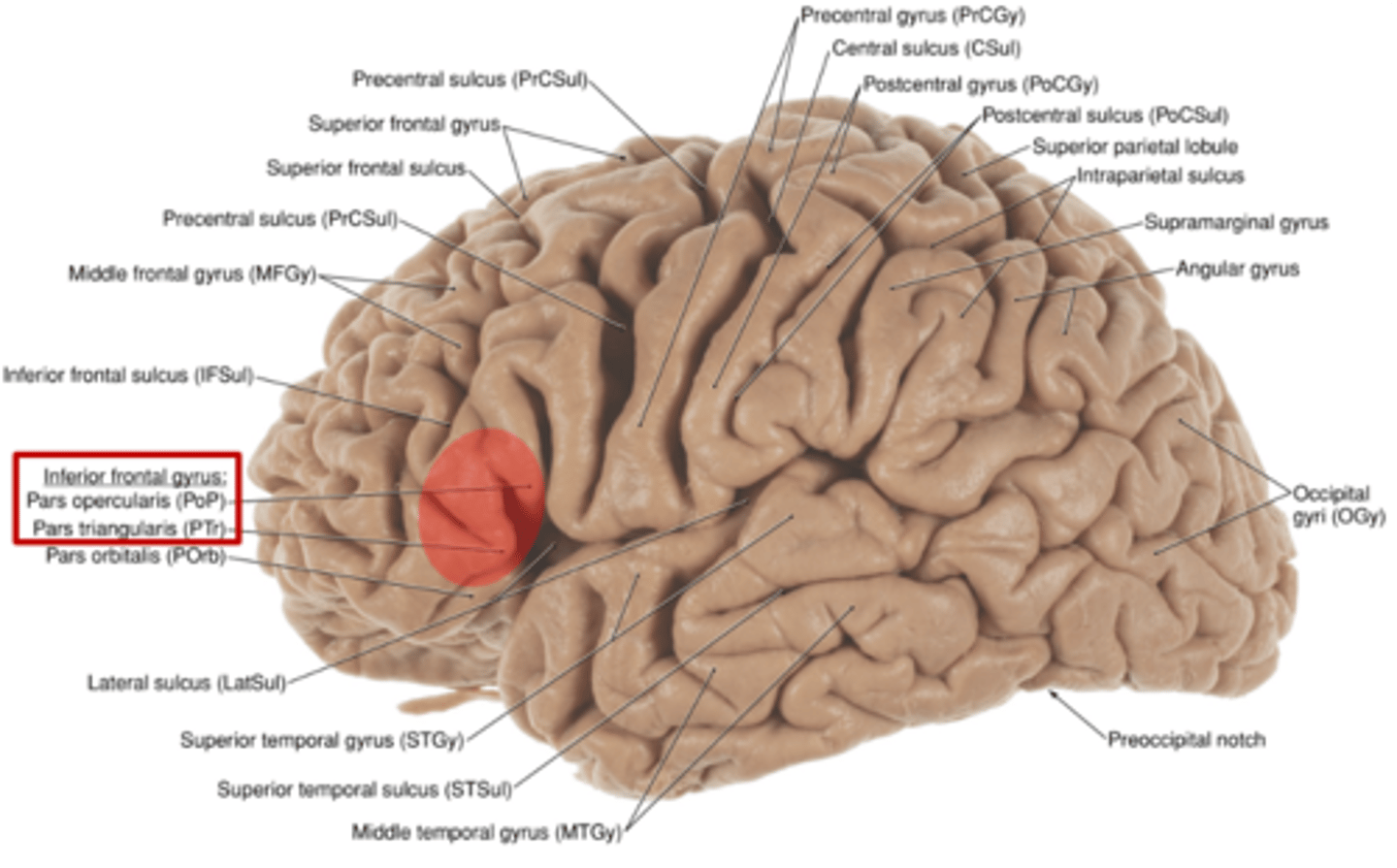Functional Regions of the Cerebral Cortex - Newcomer
1/129
There's no tags or description
Looks like no tags are added yet.
Name | Mastery | Learn | Test | Matching | Spaced |
|---|
No study sessions yet.
130 Terms
what lobe is the ring of cortex on the medial surface around the corpus callosum and is important in processing the complex aspects of learning, memory, and emotion?
limbic lobe
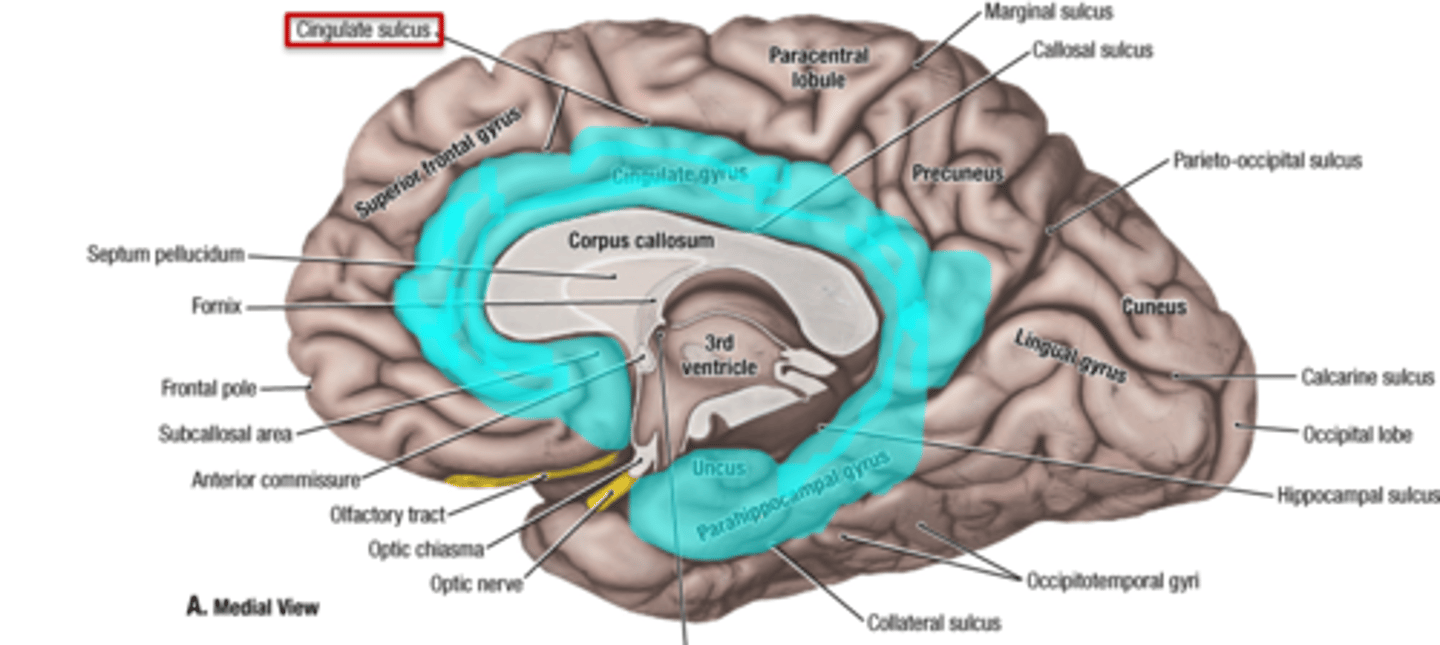
what lobe is made up of portions of the frontal, parietal, and temporal lobes buried deep to the lateral sulcus involved in receiving, processing, and integrating various types of information like taste, visceral sensation, pain, and balance?
insular lobe

what cerebral lobe is composed of the cingulate and parahippocampal gyri and is important in emotional responses, drive-related behavior, and memory?
limbic lobe
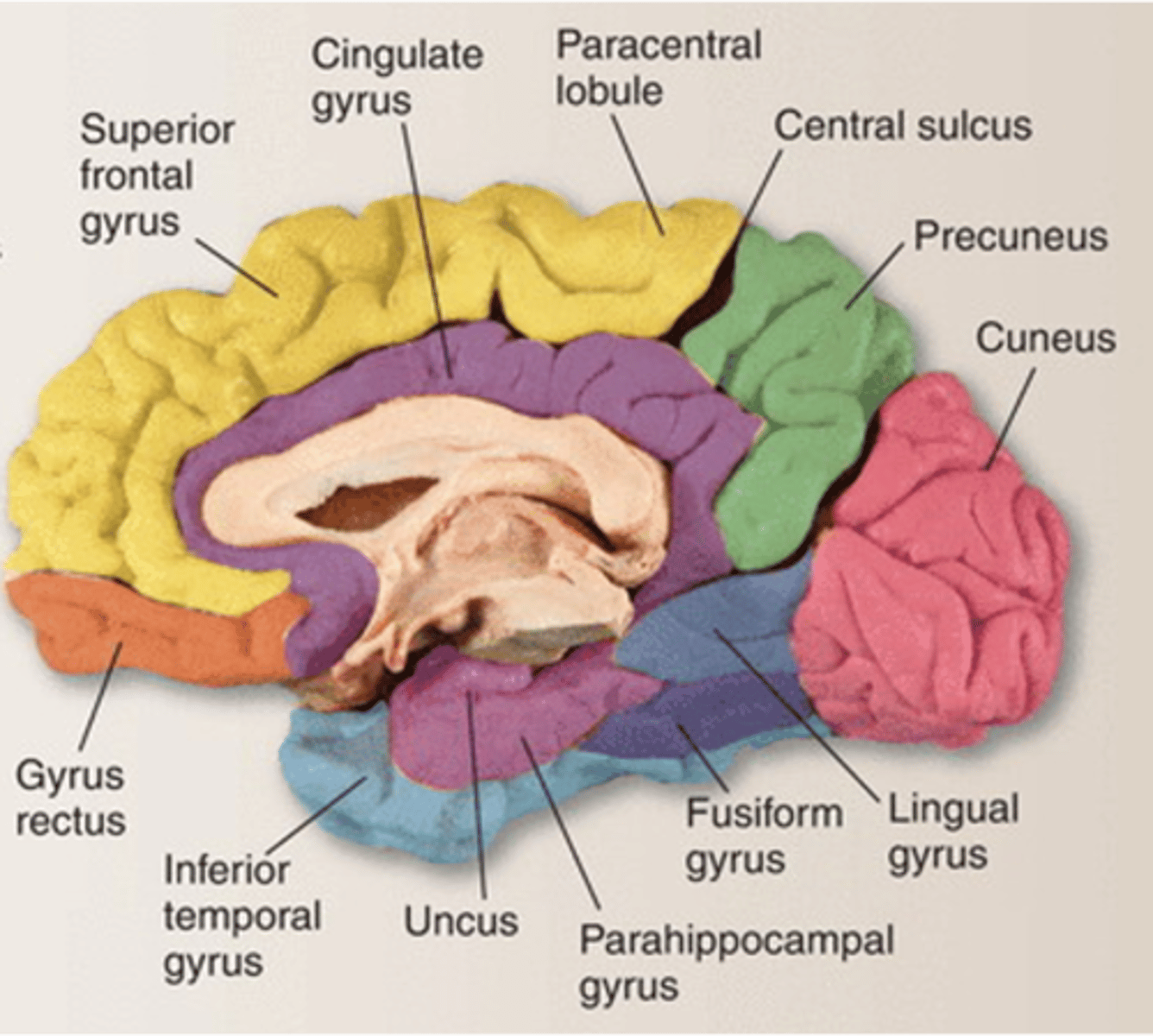
the anterior end of parahippocampal gyrus of the limbic forms a medially directed bump called the _______
uncus
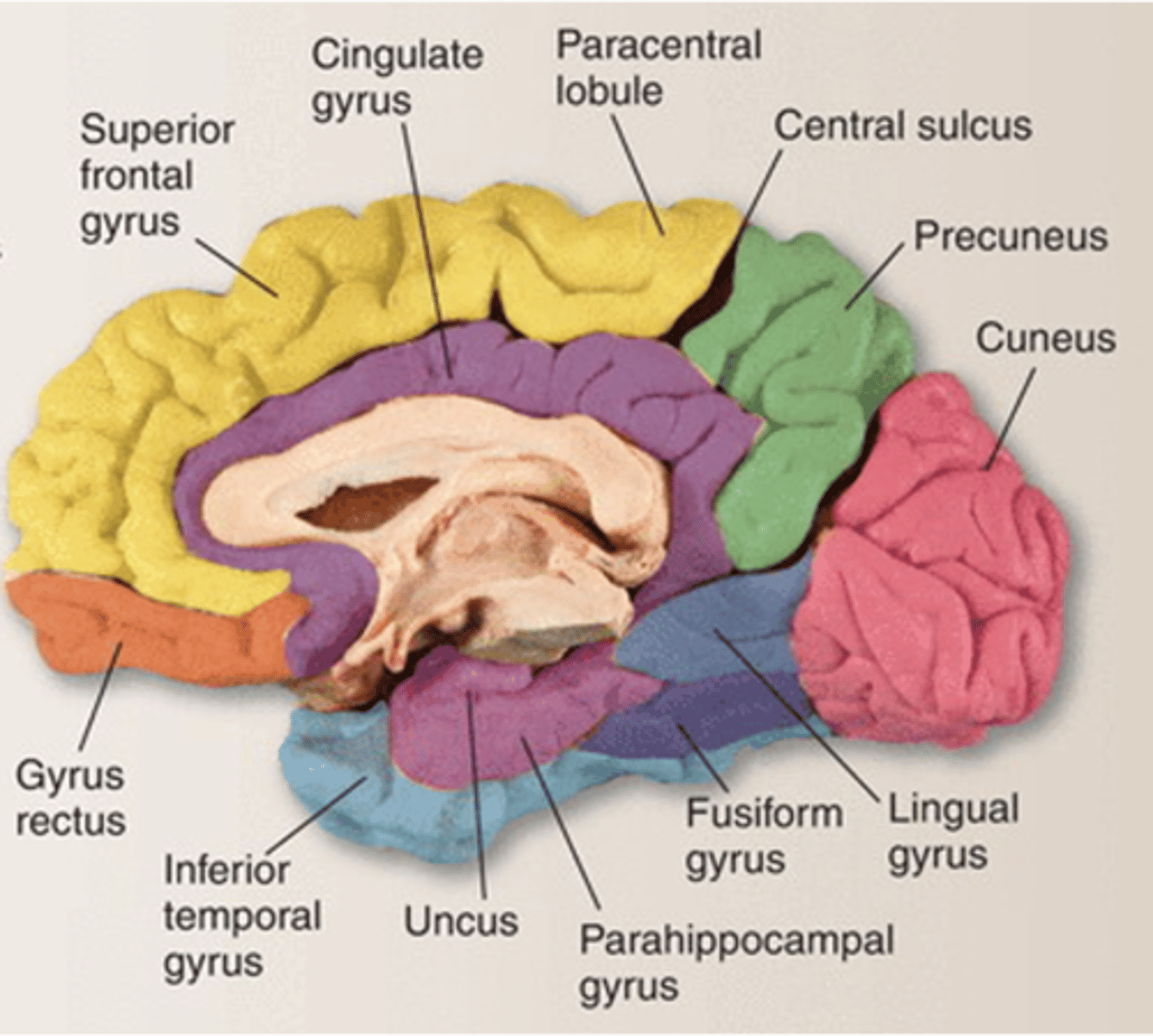
what is the purpose of the sulci and gyri on the cerebral cortex?
to increase surface area without a proportional enlargement of brain's outer dimensions or total volume
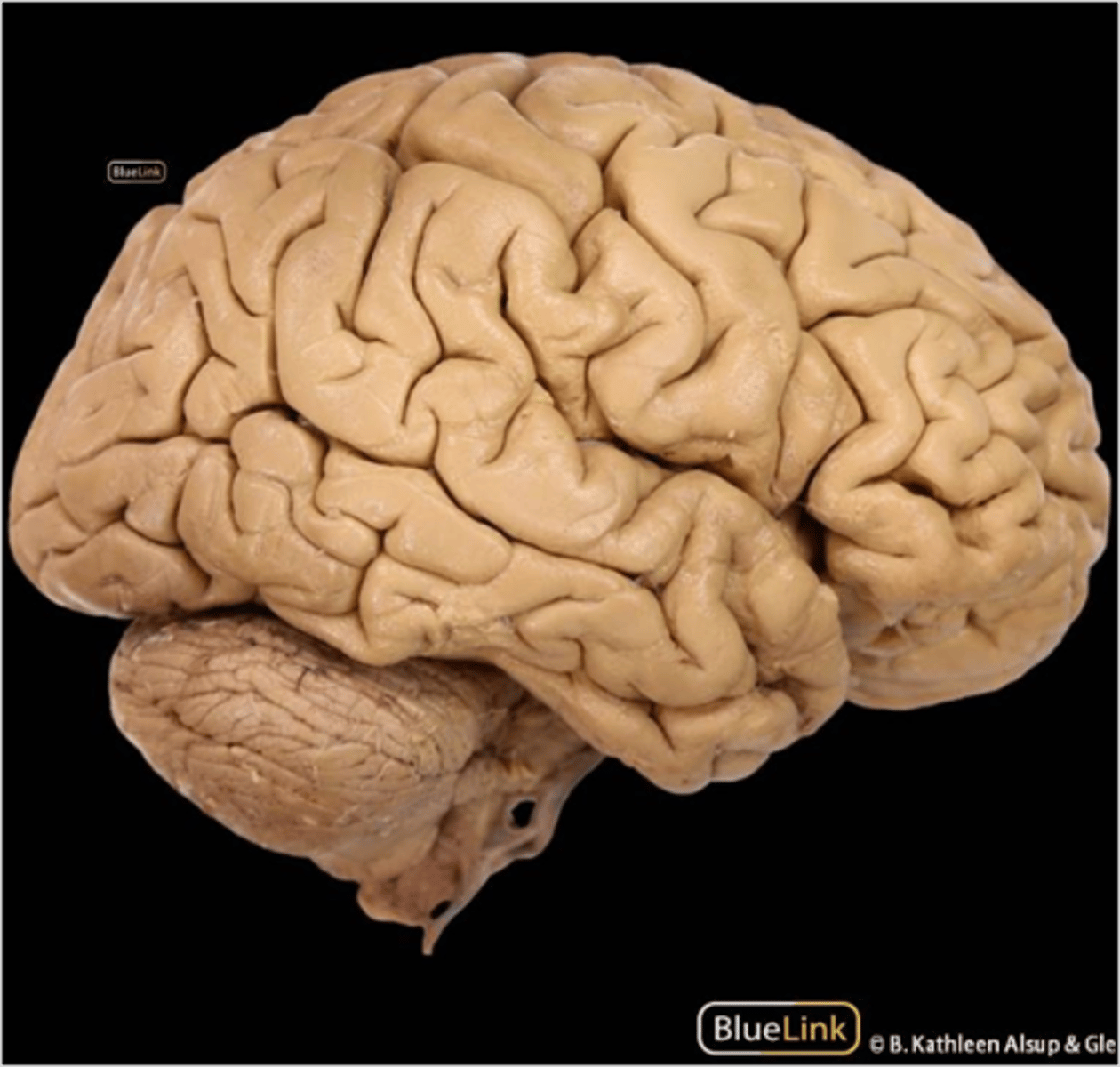
what are the 4 gyri of the frontal lobe?
1. precentral gyrus
2. superior frontal gyrus
3. middle frontal gyrus
4. inferior frontal gyrus

which gyrus of the frontal lobe contains the pars triangularis (BA 45) and pars opercularis (BA 44) (parts of Broca's area)?
inferior frontal gyrus
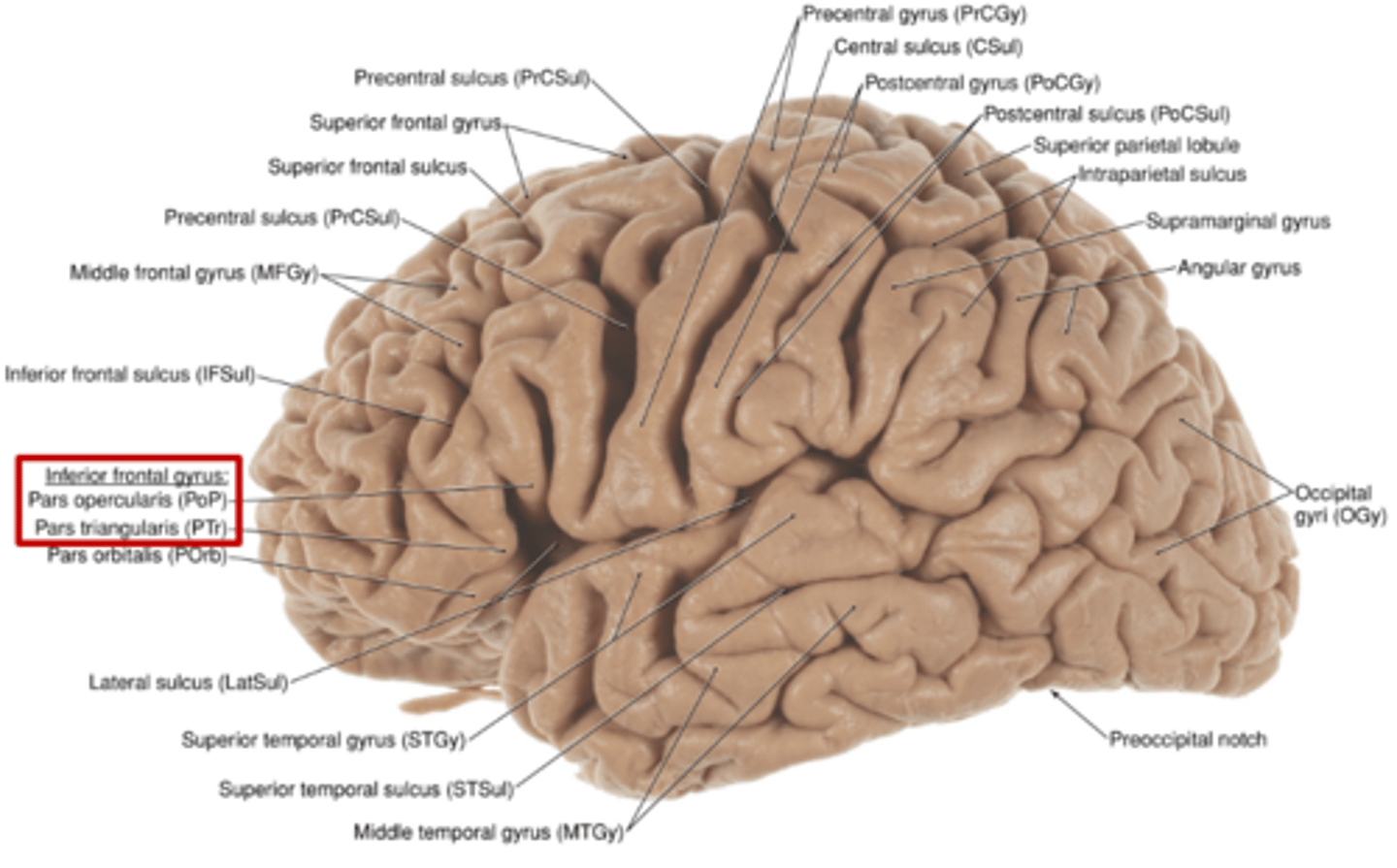
what are the 3 gyri/lobules of the parietal lobe?
1. postcentral gyrus
2. superior parietal lobule
3. inferior parietal lobule
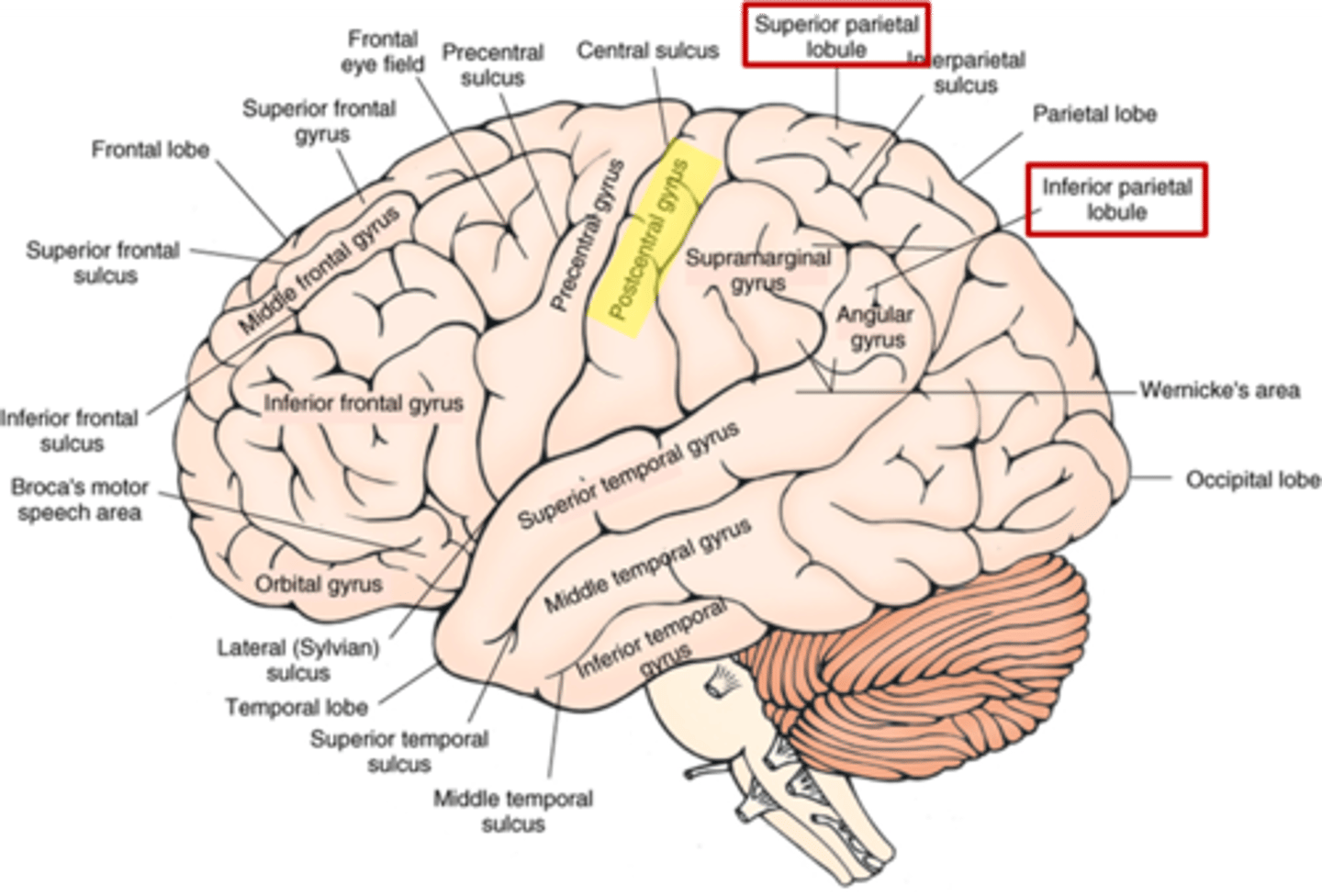
which lobule of the parietal lobe contains the supramarginal gyrus and angular gyrus (parts of the Wernicke area)?
inferior parietal lobule
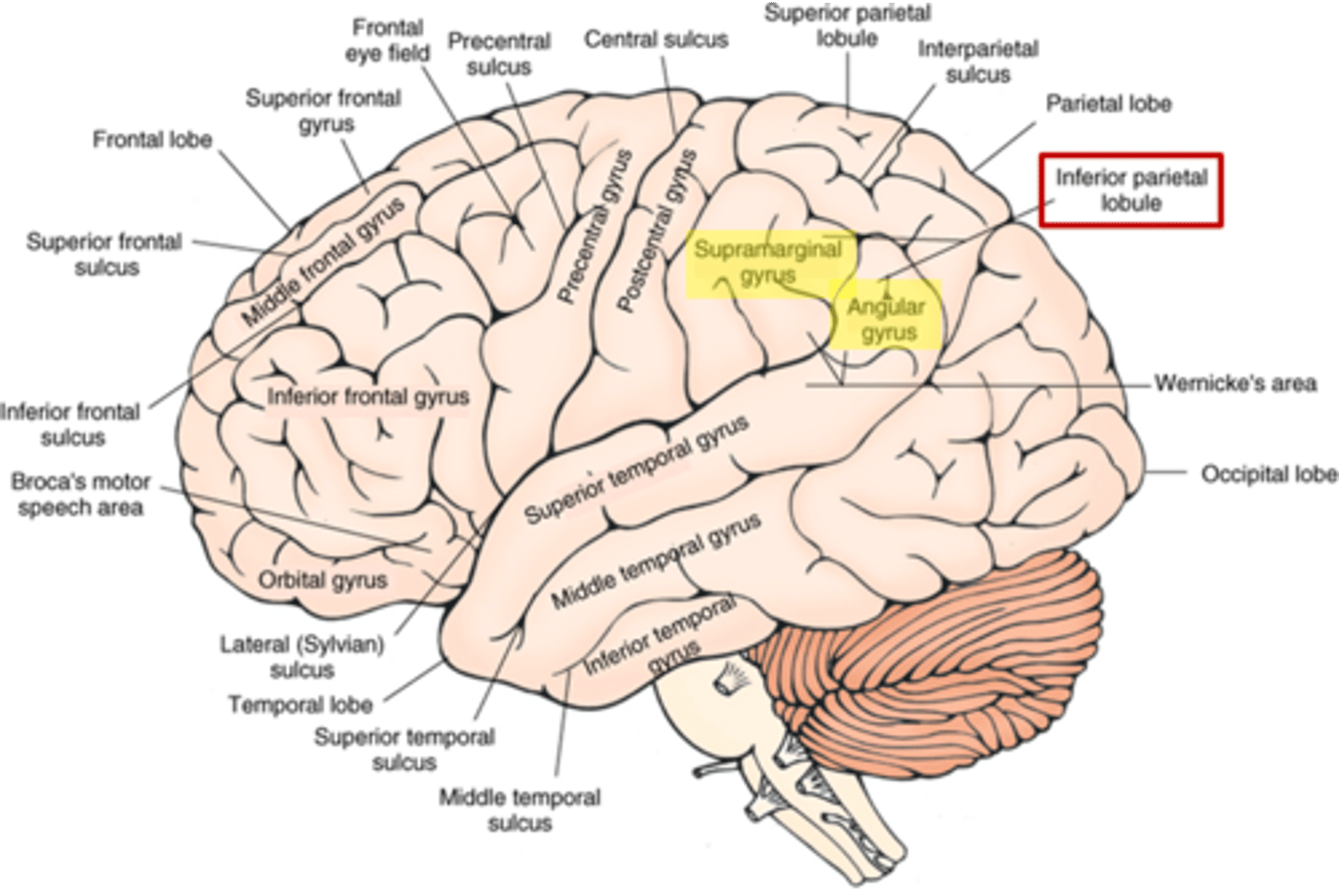
what are the 3 gyri of the temporal lobe?
1. superior temporal gyrus
2. middle temporal gyrus
3. inferior temporal gyrus
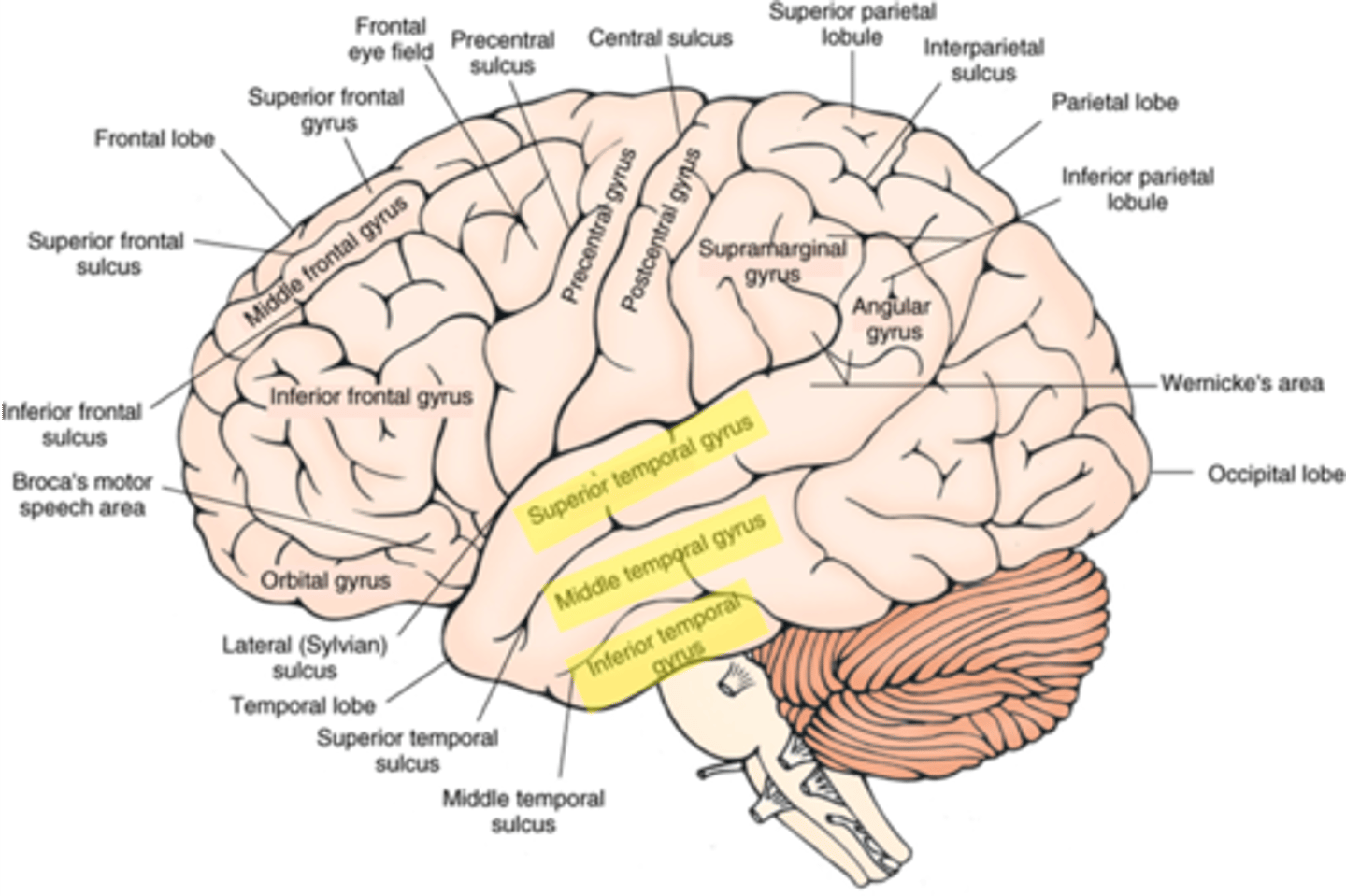
which gyri of the temporal lobe contains the transverse temporal gyrus of Heschl (primary auditory cortex)?
superior temporal gyrus
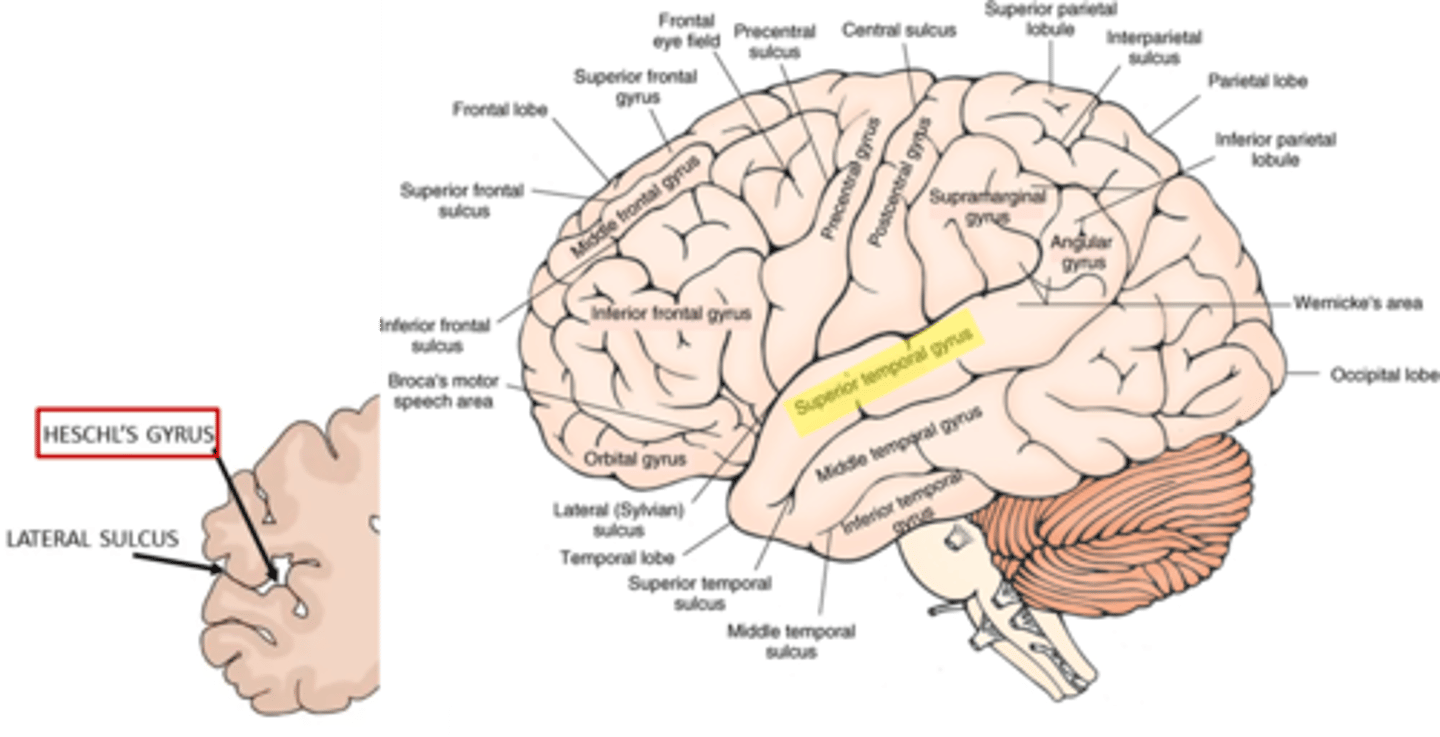
what is the name of the wedge-shaped area between the calcarine fissure and parieto-occipital sulcus in the occipital lobe?
cuneus

what is the location of the primary visual cortex within the walls of the occipital lobe?
calcarine fissure/sulcus
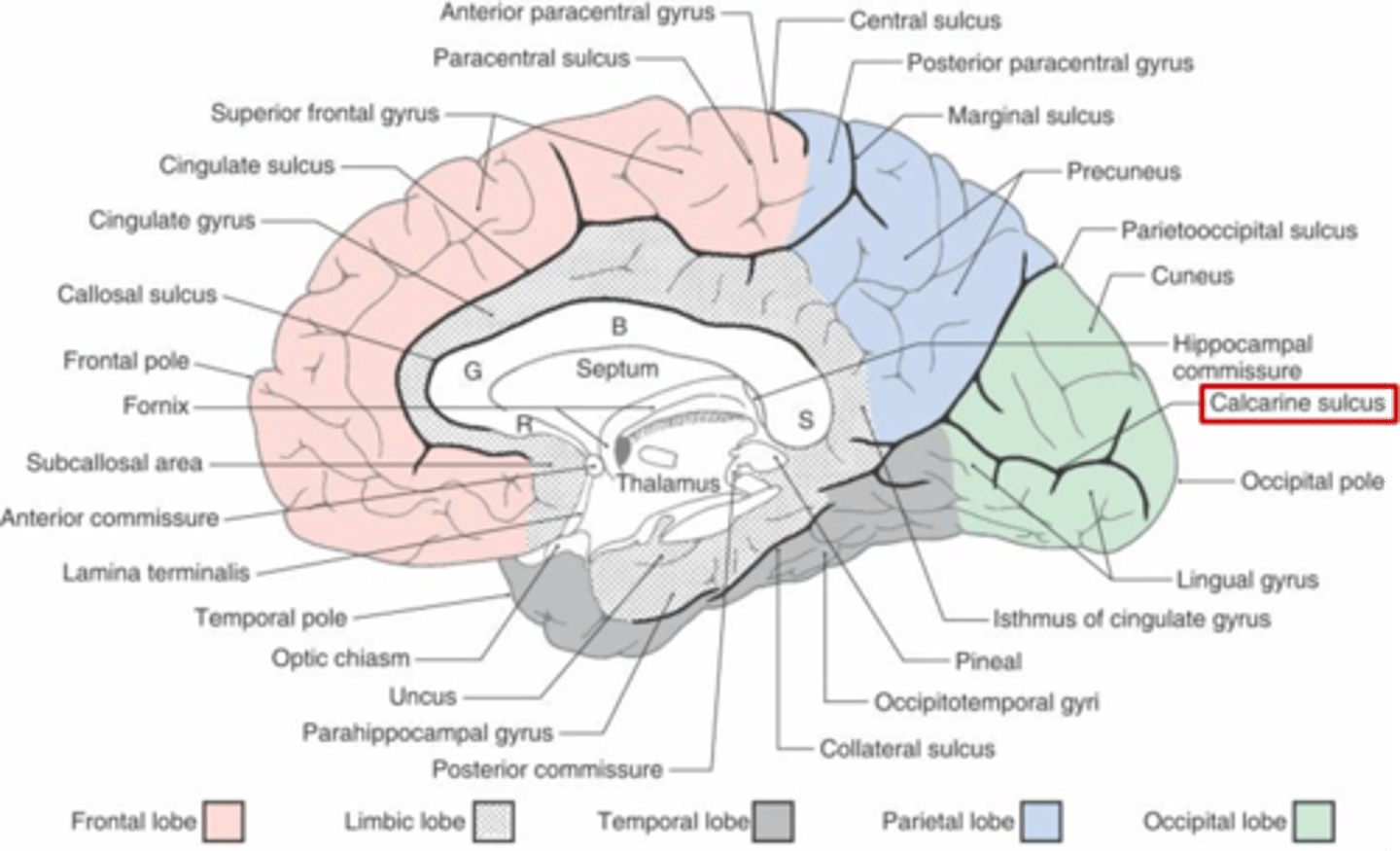
allocortex vs neocortex: most of the cortex (has 6 cell layers)
neocortex
allocortex vs neocortex: more rudimentary layer
allocortex
allocortex vs neocortex: 3-5 cell layers consisting of the paleocortex (olfactory system) and archicortex (hippocampal formation)
allocortex
what are the 2 major neuronal cell types in the cortex?
1. pyramidal neurons
2. granular (stellate) neurons
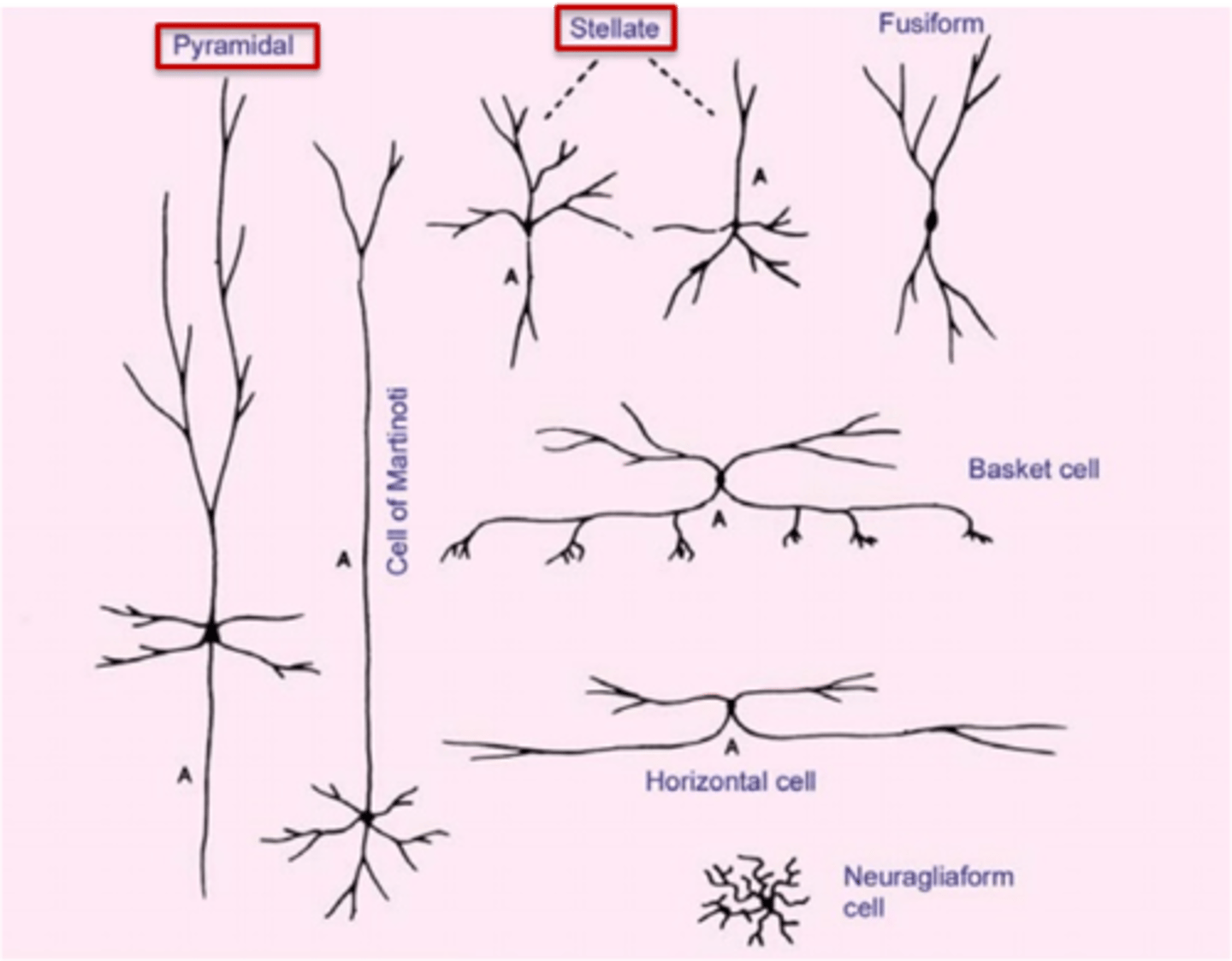
which neocortical neurons are the most common type and are conical bodies with one apical dendrite that leaves the top of the cell forming abundant dendritic trees?
pyramidal neurons
which neocortical neurons are the principle output neurons of the cortex (project to other regions of the CNS)?
pyramidal neurons
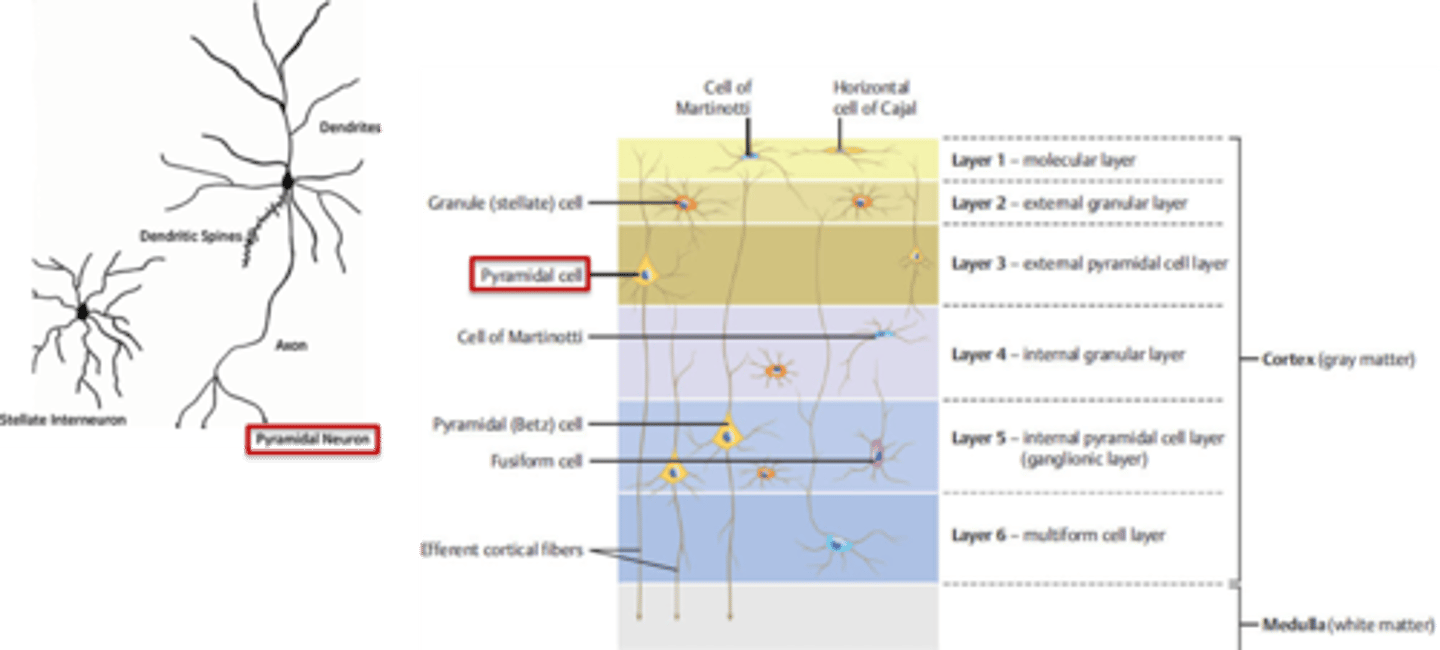
which neocortical neurons are the main interneurons found only in the CNS and serve as the middle-men between afferent neurons, efferent neurons, and interneurons?
granular (stellate) neurons
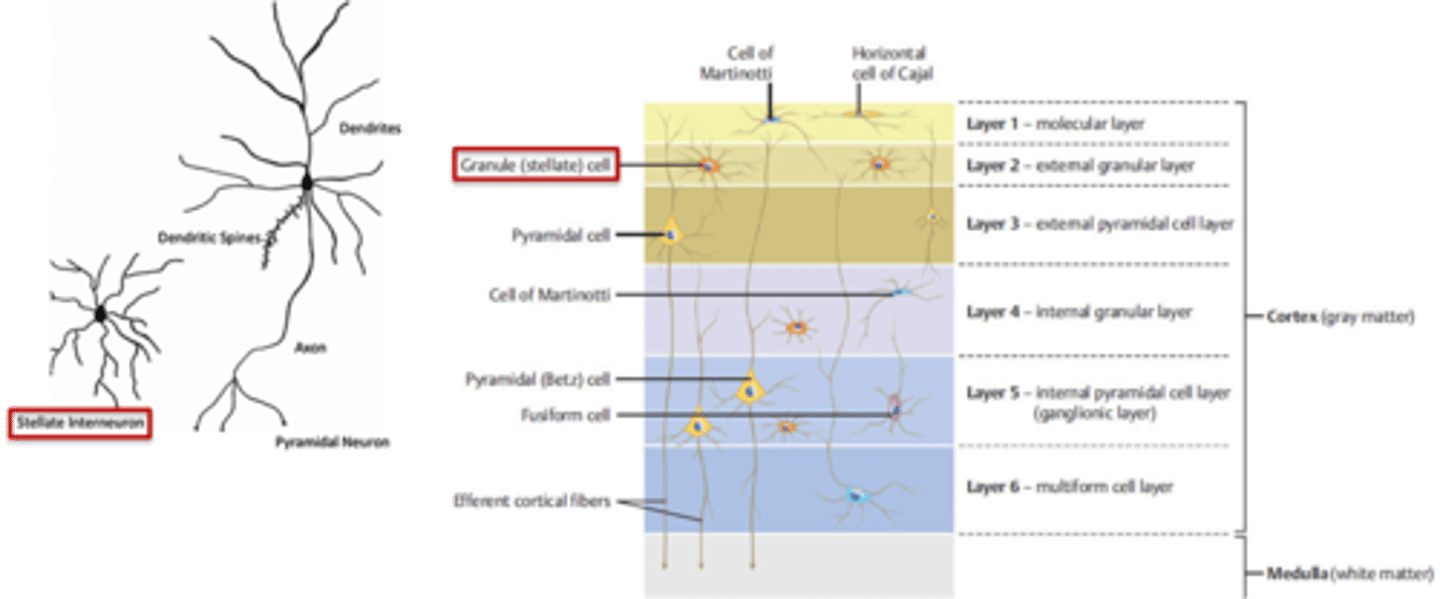
which neocortical neurons have shorter axons, smaller dendritic trees, and remain within the cortex?
granular (stellate) neurons
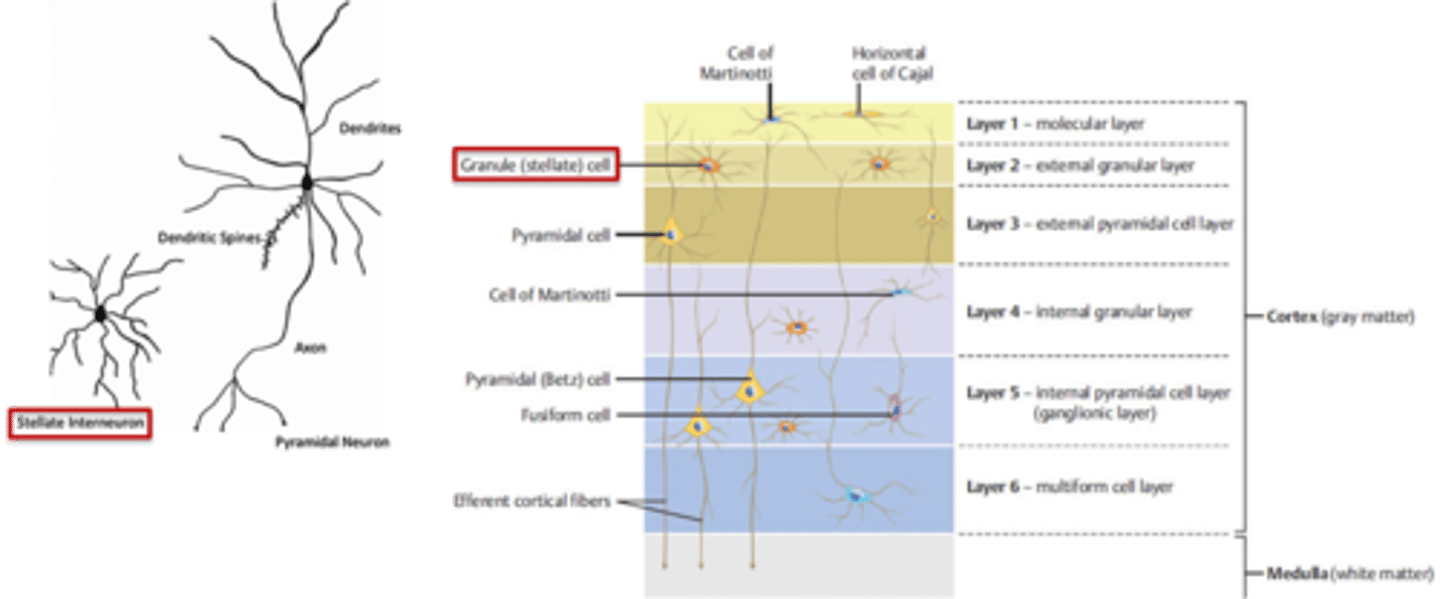
which neocortical neurons have triangular cell bodies and a single large apical dendrite arising from the apex of the cell body?
pyramidal neurons

which neocortical neurons have multiple basal dendrites that predominantly run in a horizontal direction and a single axons that leaves the cortex to the white matter?
pyramidal neurons

what are the largest pyramidal cells found almost exclusively in the primary (somatic/motor) cortex?
motor; giant pyramid cells (Betz cells)
(t/f) all the non-pyramidal neurons of the cortex act as afferent neurons
false; all the non-pyramidal neurons of the cortex act as interneurons
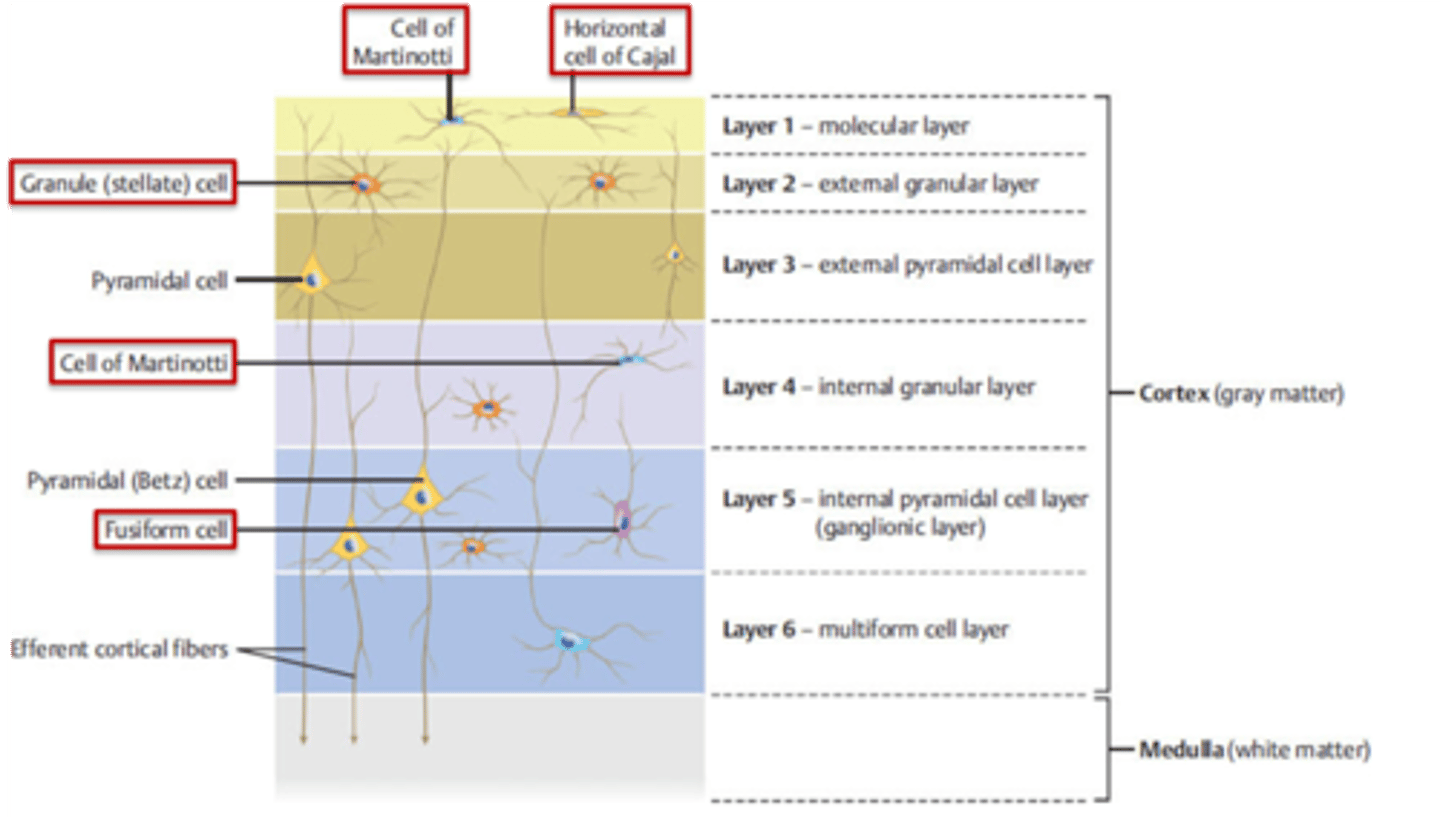
what are the 6 layers of the neocortex?
1. molecular layer
2. outer granular layer
3. outer pyramidal layer
4. inner granular layer
5. inner pyramidal layer
6. multiform layer
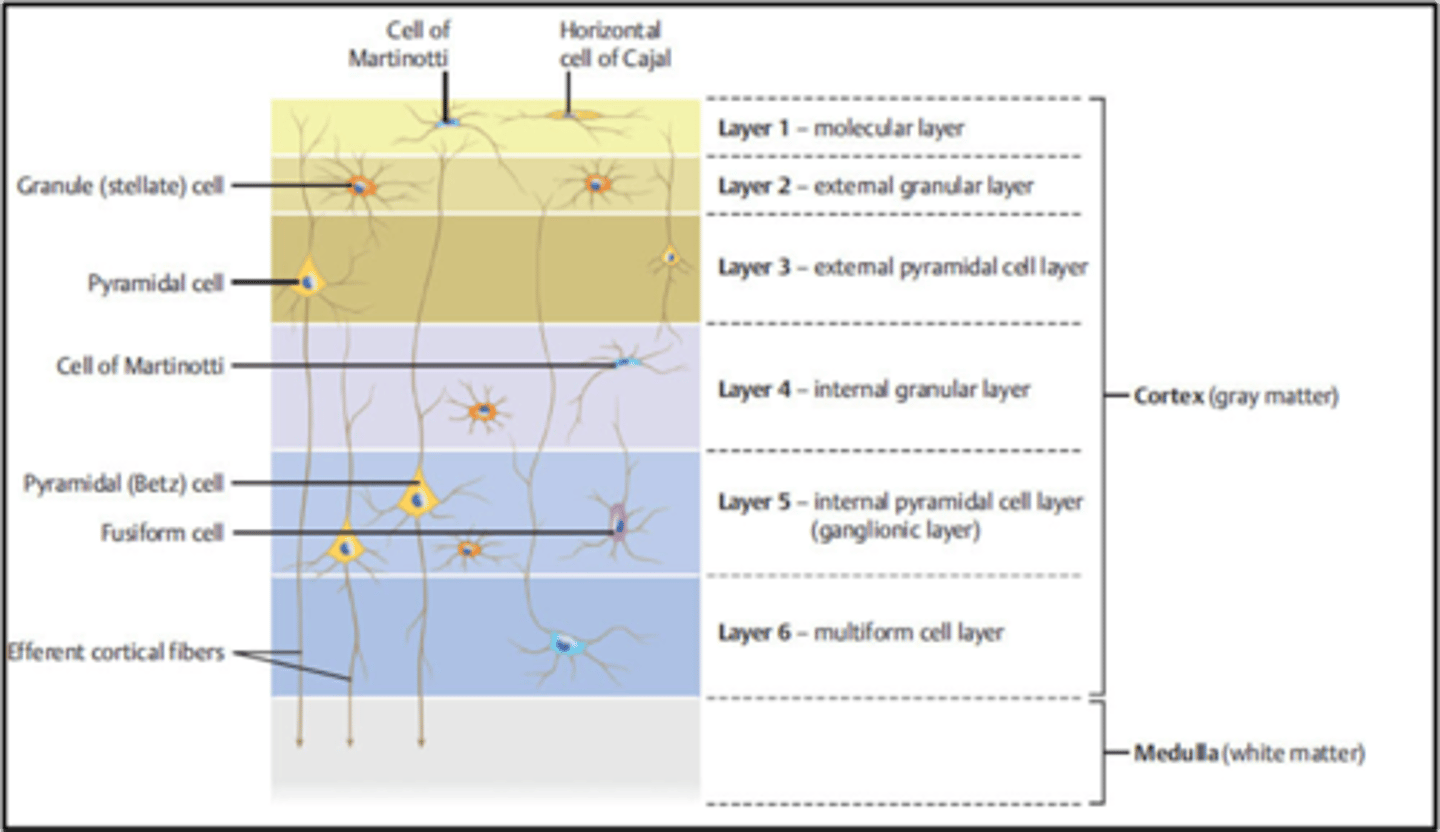
which neocortical layer is the most superficial layer covered by the pia mater?
molecular layer
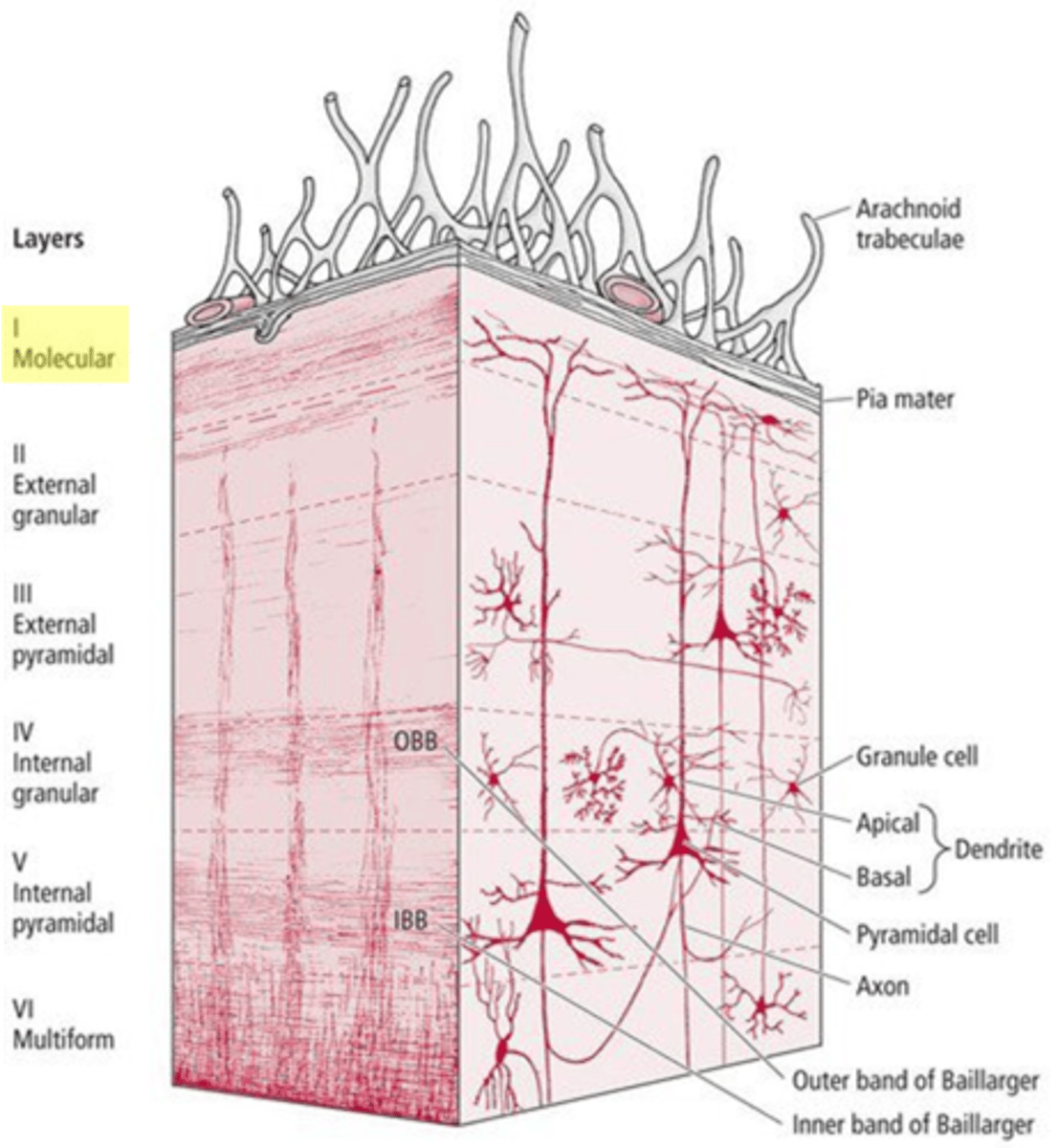
which neocortical layer consists of primarily axons, dendrites, and not many neuron cell bodies?
molecular layer
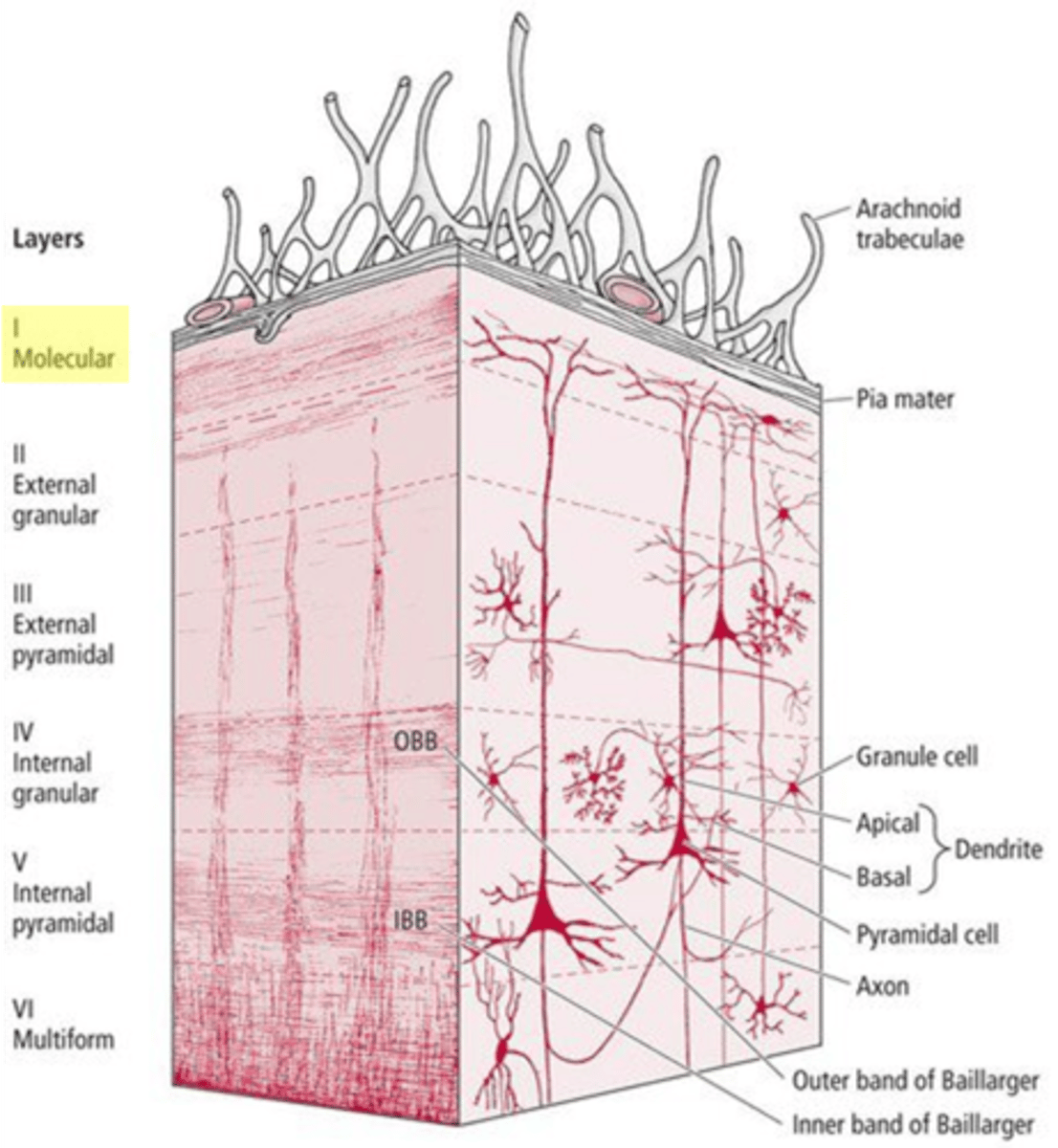
which neocortical layer consists mostly of small stellate cells (as well as pyramidal cells with apical dendrites that extend into the first layer and descend into deeper layers)?
outer granular layer
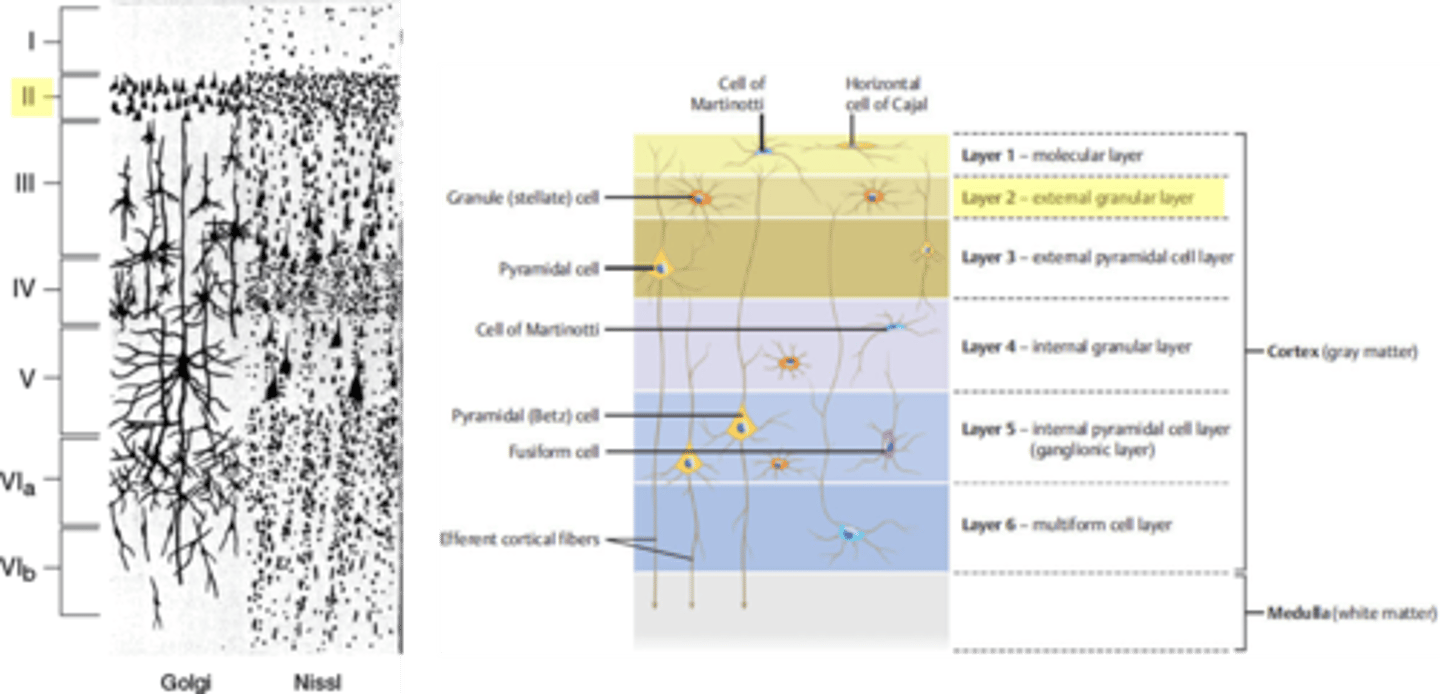
which neocortical layer consists of small and medium sized pyramidal neurons with its dendrites and axons extending to different layers?
outer pyramidal layer
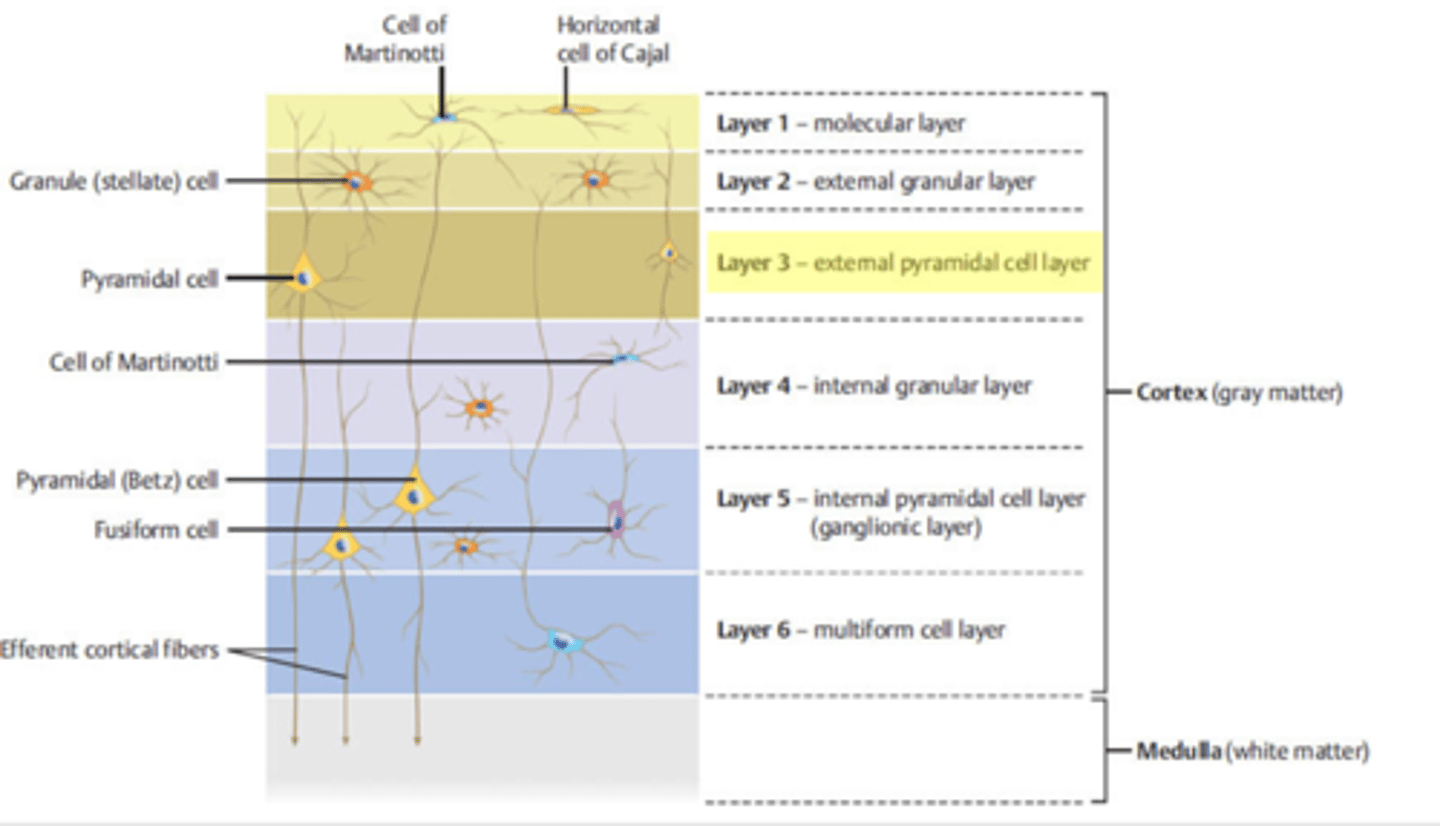
which neocortical layer consists mostly of stellate cells that are the primary target for ascending sensory information from the thalamus?
inner granular layer

which neocortical layer contains medium and large pyramidal cells that are the major source of cortical efferent fibers?
inner pyramidal layer
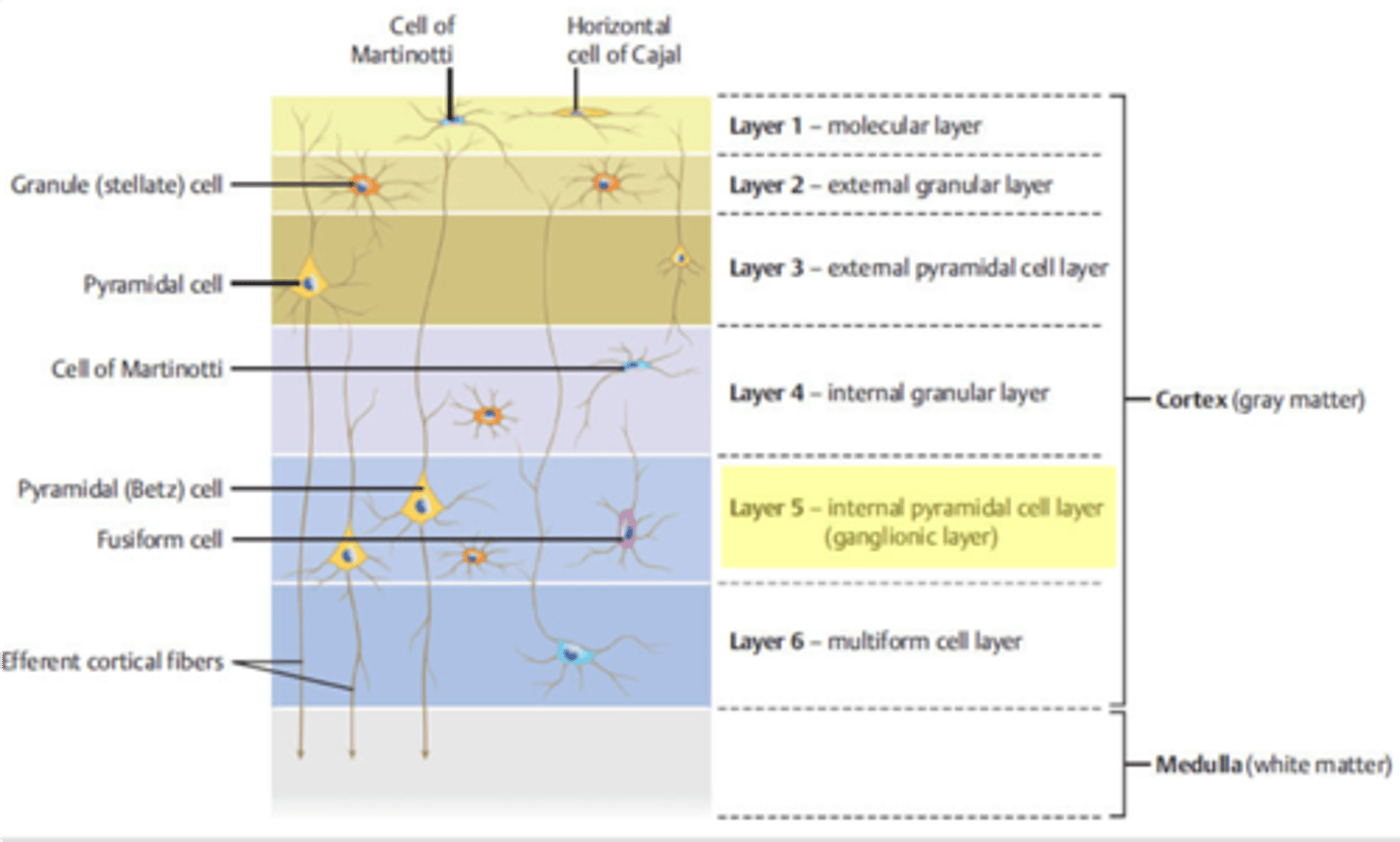
which neocortical layer is the most prominent within the motor cortex with the primary motor cortex containing Betz cells?
inner pyramid layer
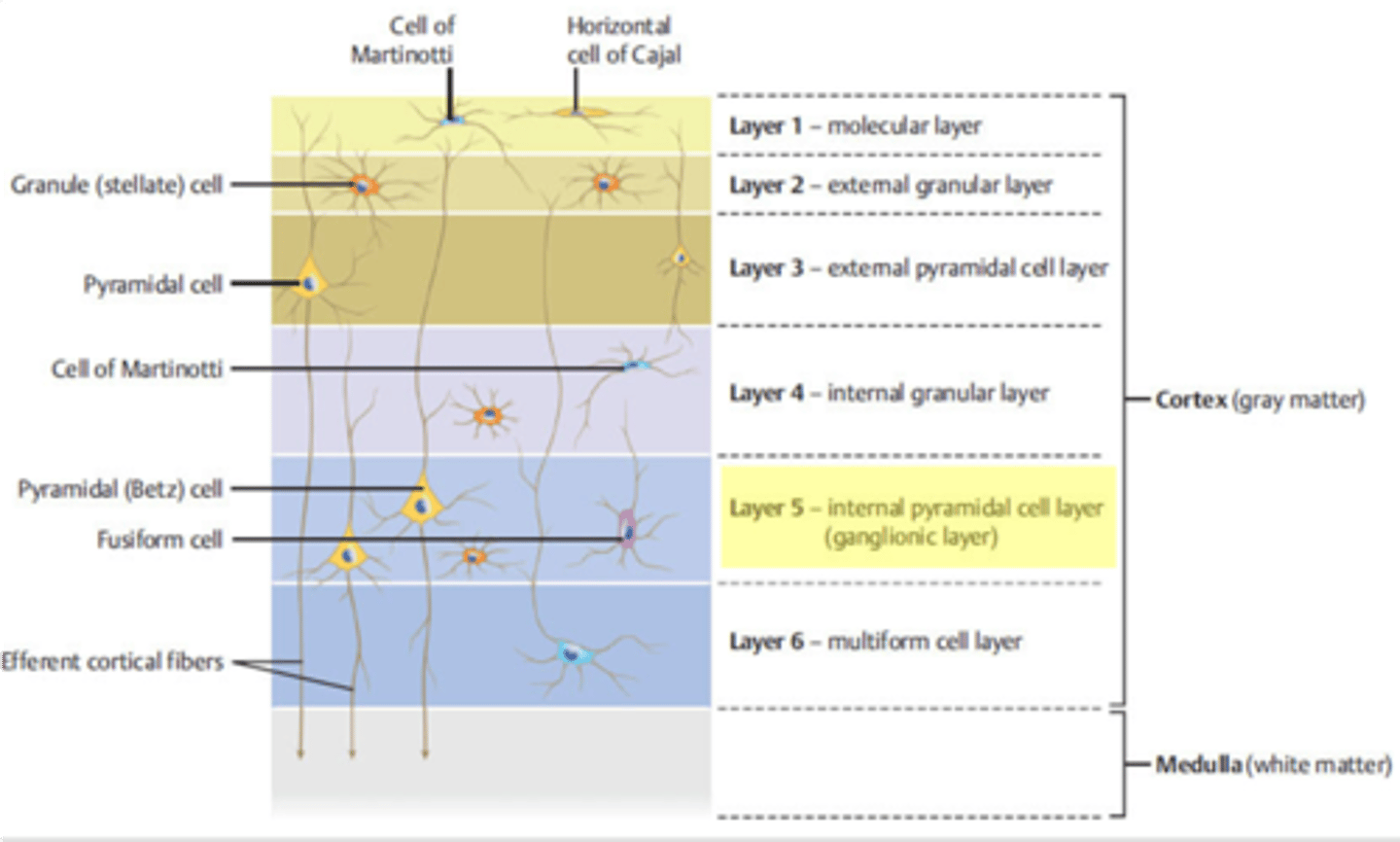
which neocortical layer is the deepest layer of the cortex that directly overlies subcortical white matter?
multiform (fusiform) layer
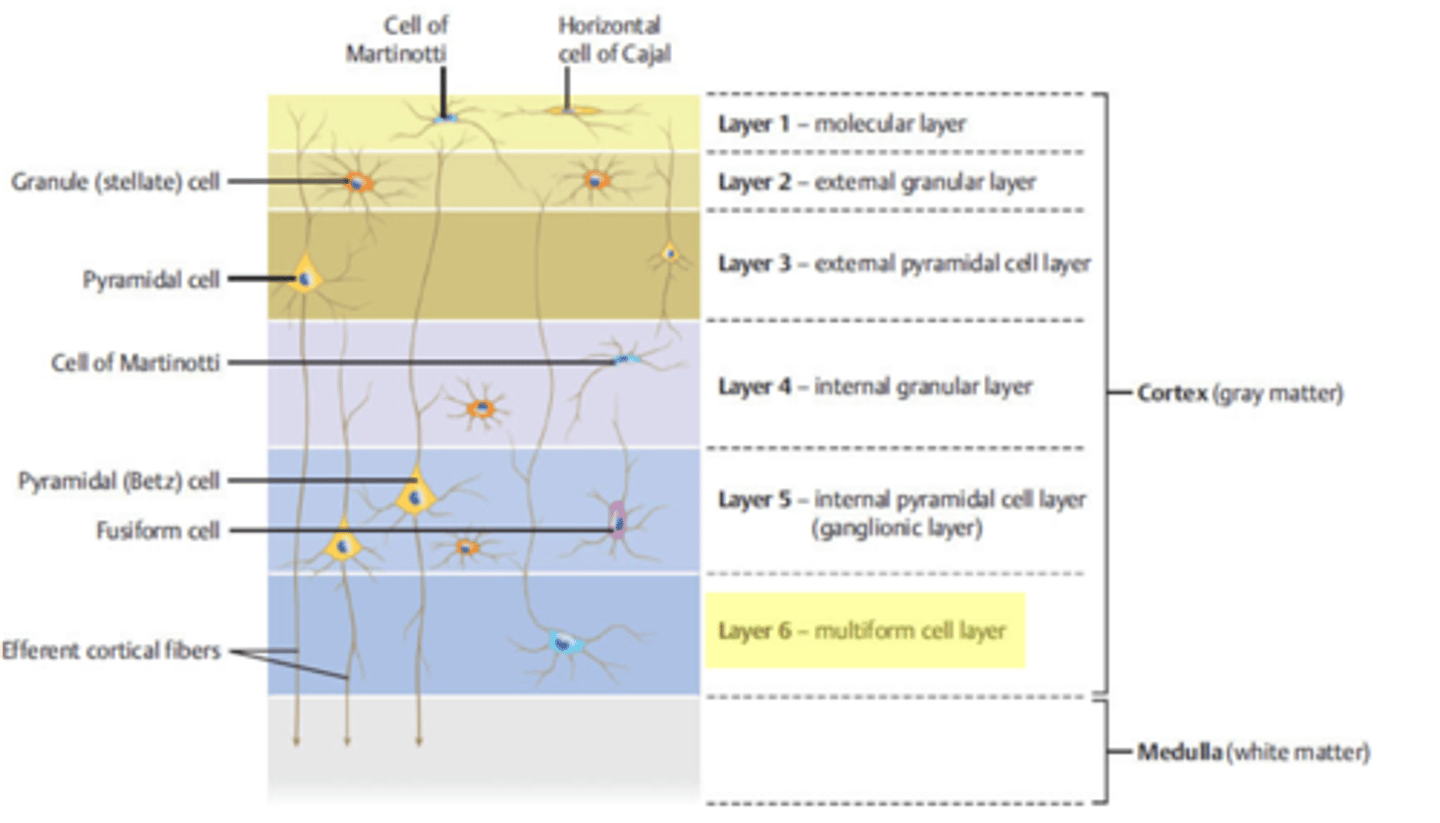
which neocortical layer contains output neurons of varying shapes and sizes with their axons projecting to subcortical targets and other cortical regions?
multiform (fusiform) layer
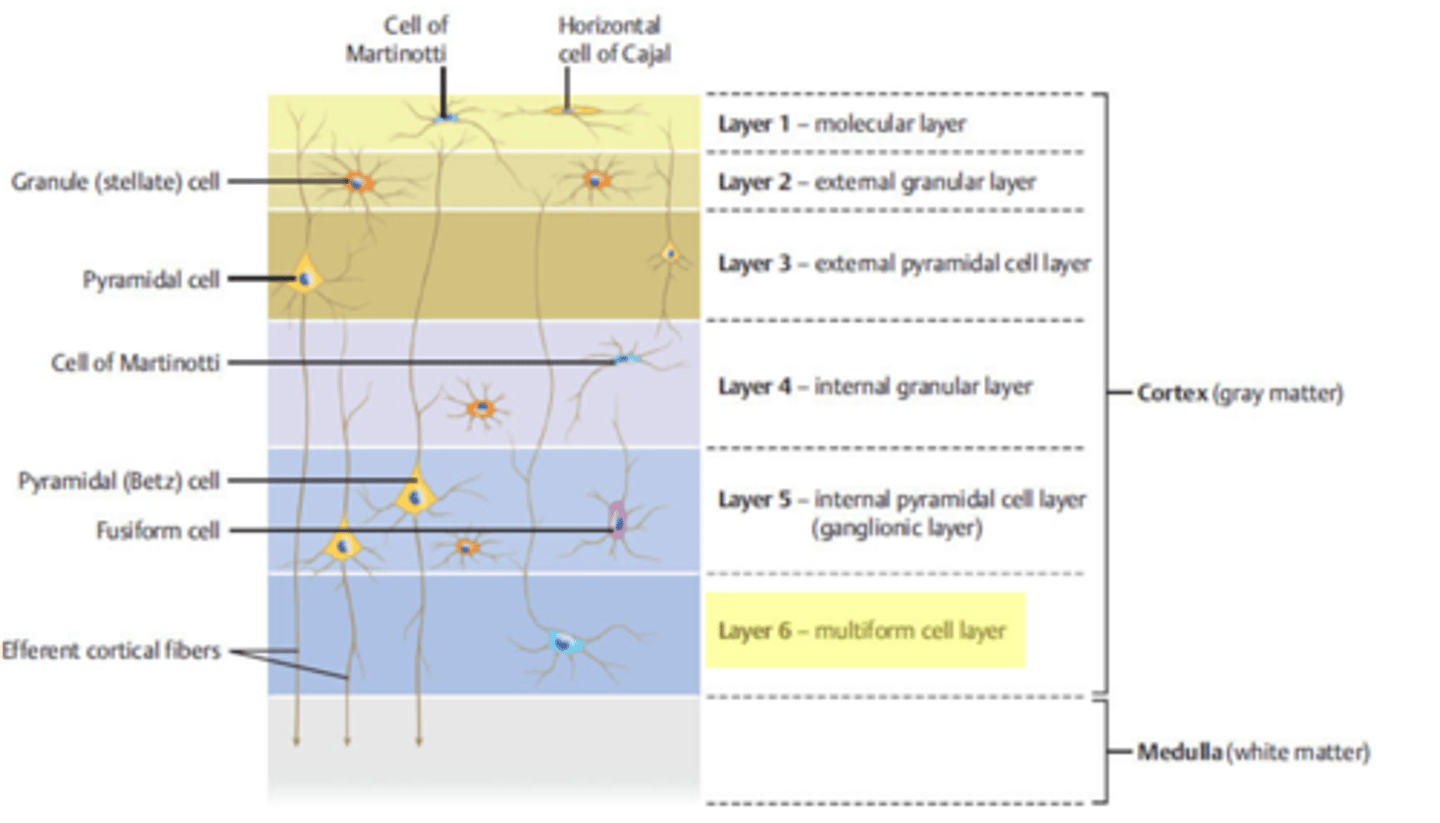
which neocortical layer is well developed in the association cortex?
outer pyramidal layer
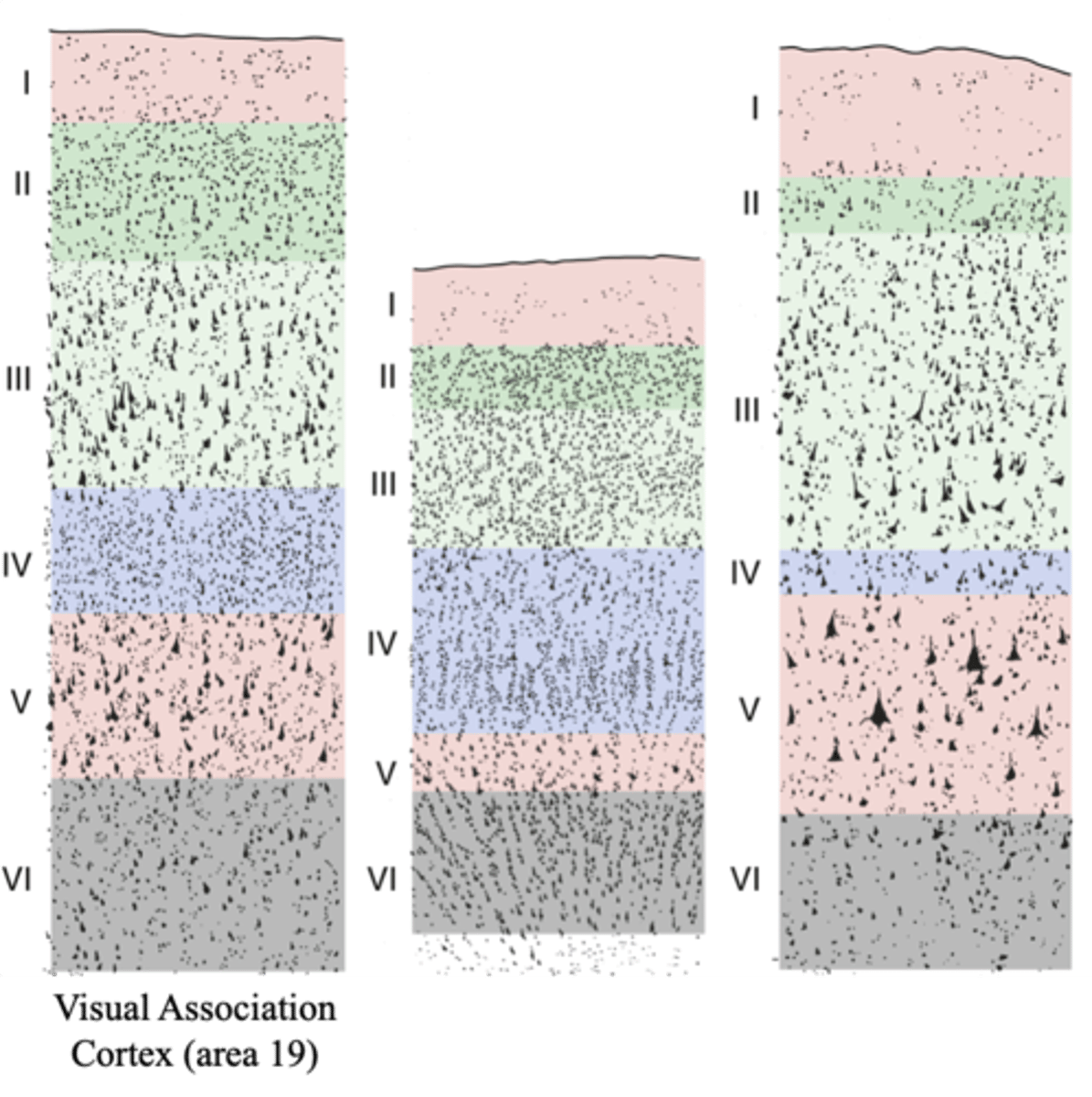
which neocortical layer is the chief reception layer, especially in the sensory cortex (thickest in sensory areas)?
inner granular layer
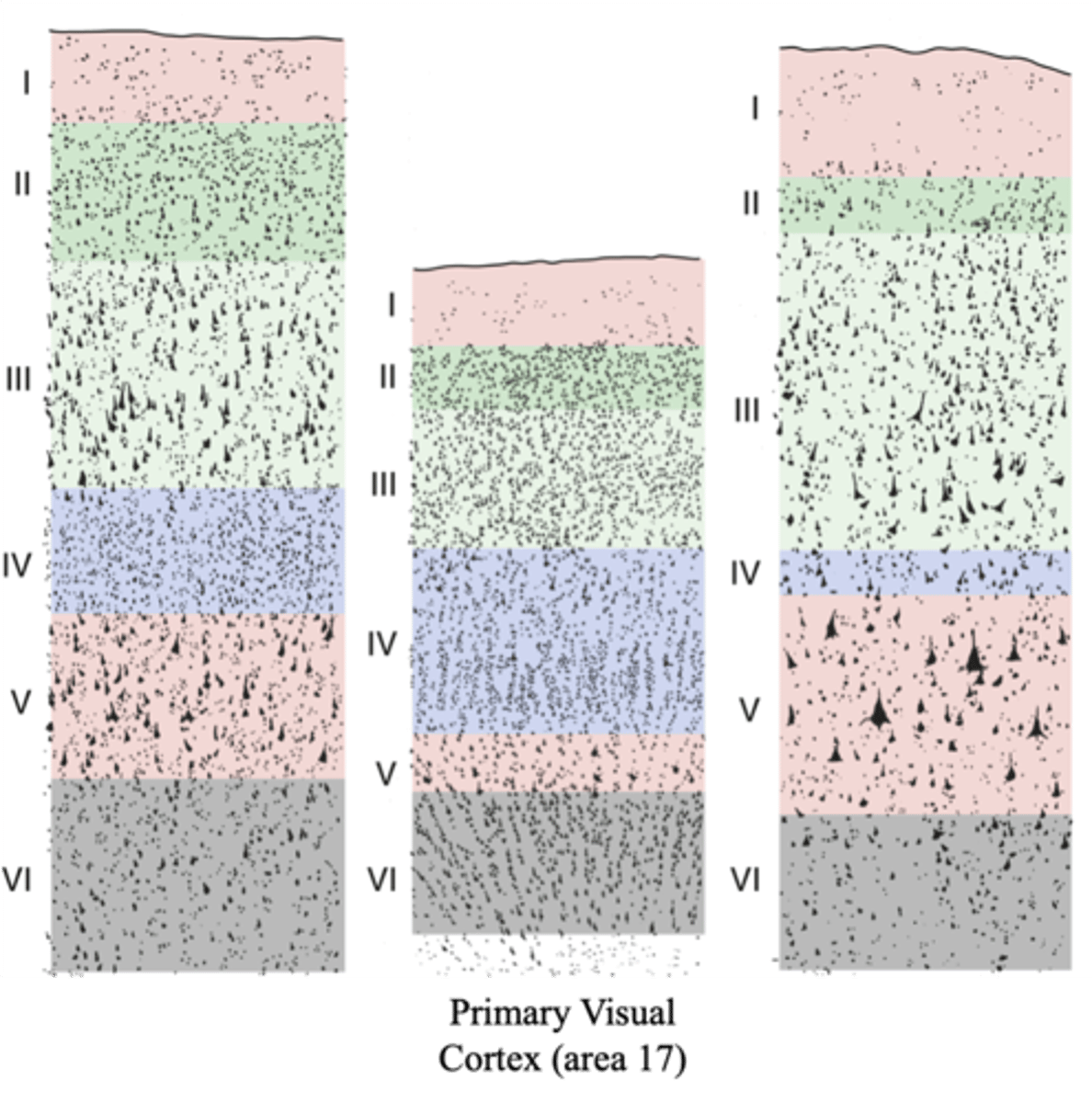
which neocortical layer is the chief output layer, especially in the motor cortex?
inner pyramidal layer
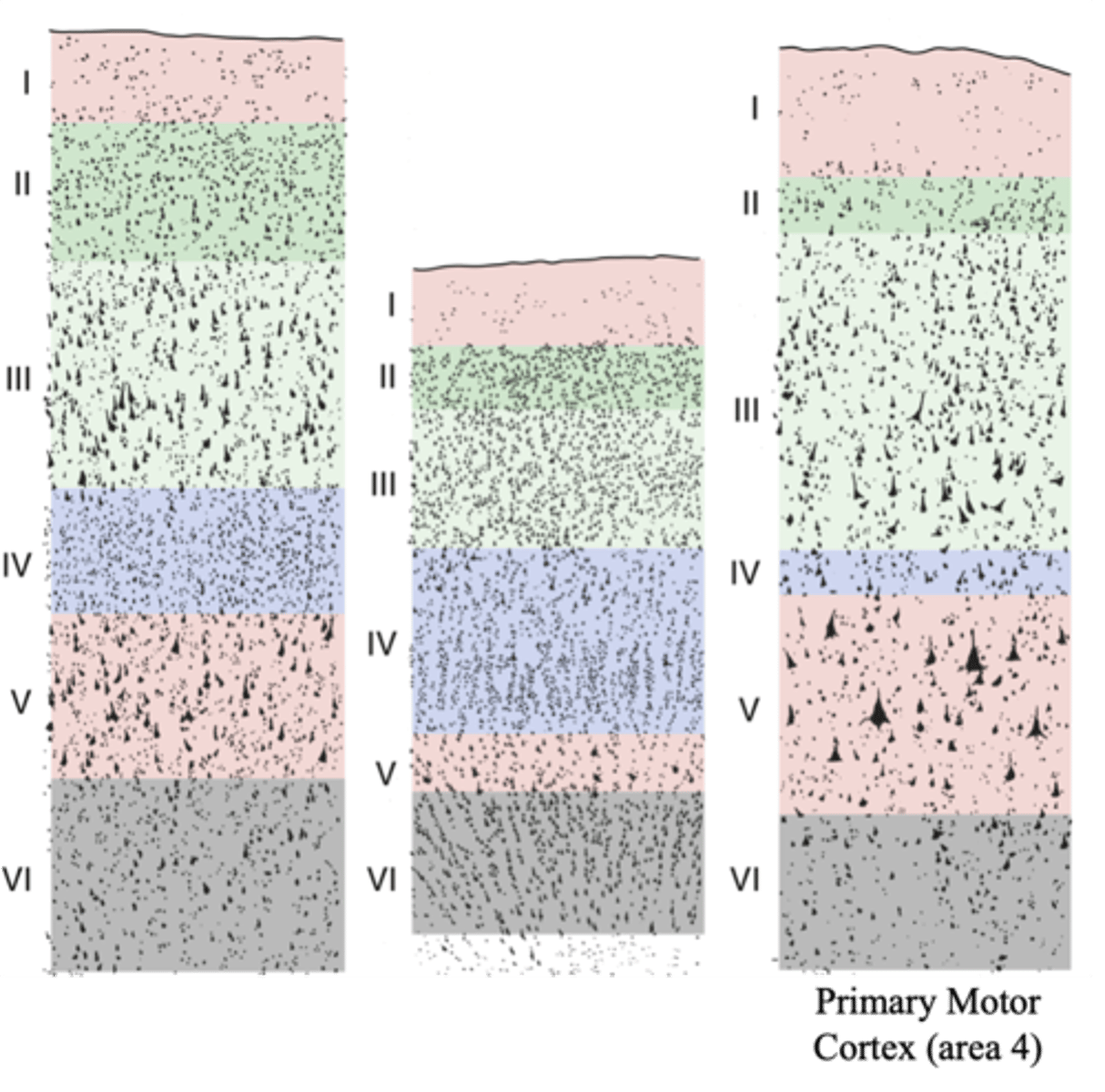
which neocortical neurons represent virtually the only output pathway for the cortex?
pyramidal neurons
(t/f) all cell types in the cortex are local circuit neurons that exert their influence within their own immediate vicinity, except for pyramidal and granular neurons
false; other than pyramidal neurons, almost all other cell types in cortex are local circuit neurons that exert their influence within their own immediate vicinity
what are the 3 classes of pyramidal neurons?
1. corticocortical association fibers
2. commissural (callosal) fibers
3. descending projection fibers
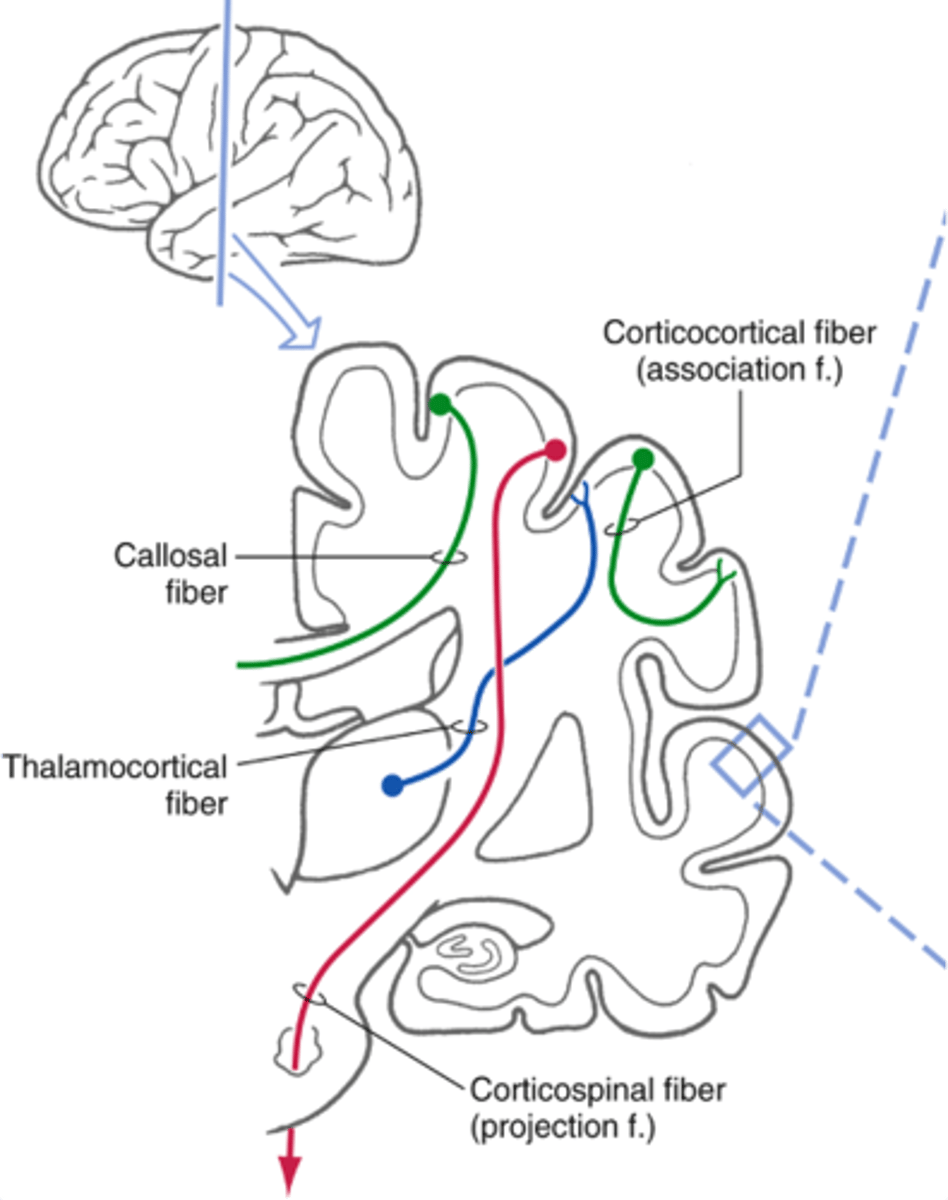
which class of pyramidal neurons project to cortical areas of the same cerebral hemisphere?
corticocortical association fibers

which class of pyramidal neurons project axons to the contralateral cortex via the corpus callosum?
commissural (callosal) fibers
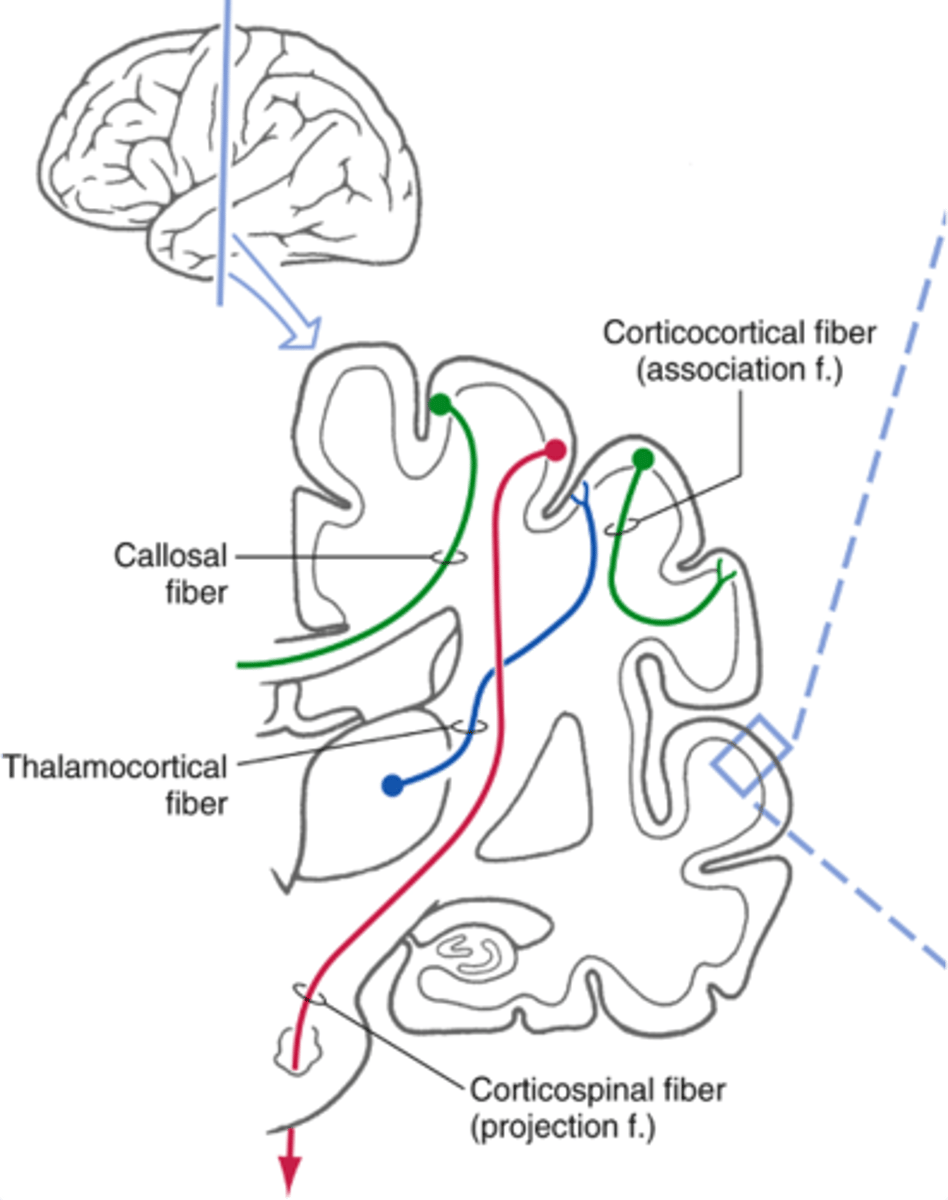
which class of pyramidal neurons travel to subcortical targets (thalamus, spinal cord, and the brainstem)?
descending projection fibers
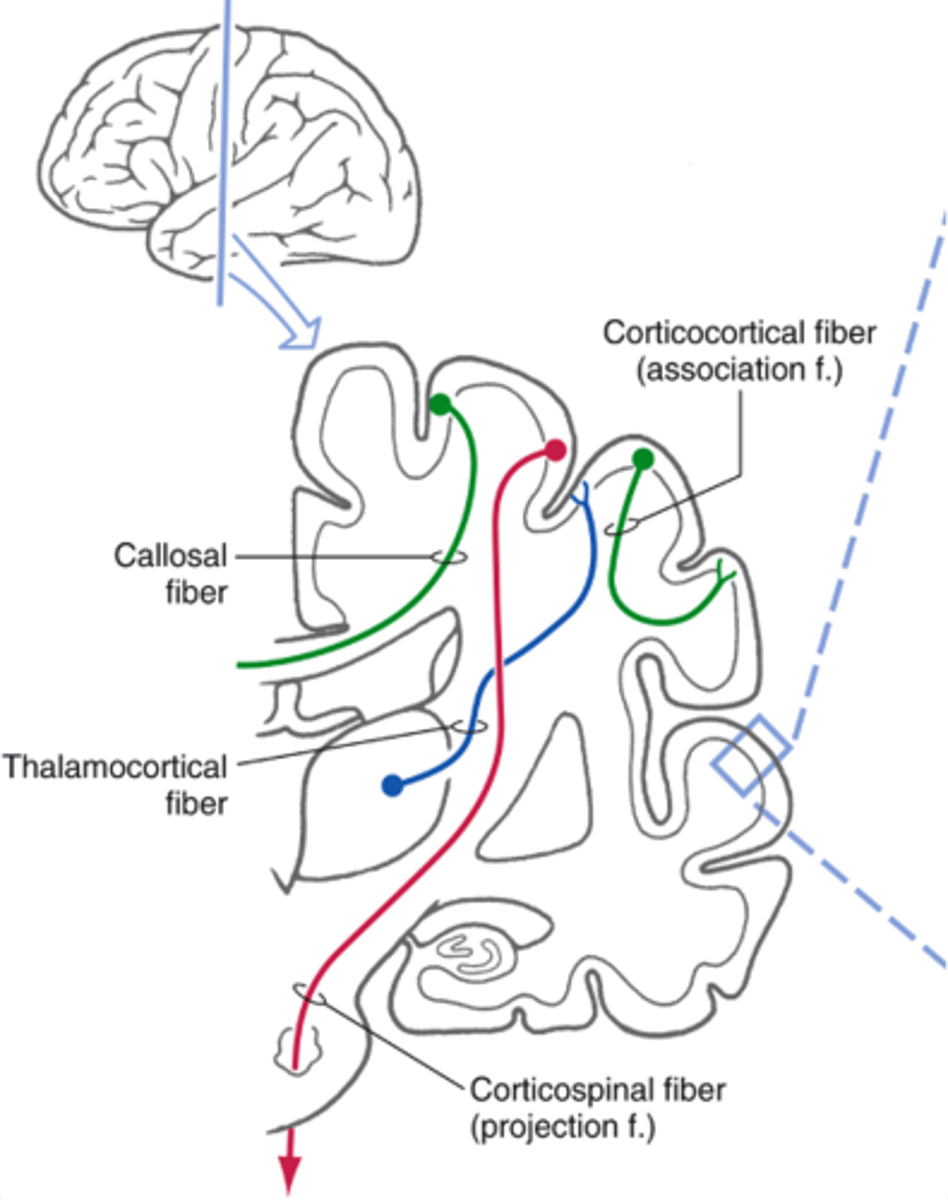
what are the 4 neocortical output layers of the cortex?
1. outer granular layer
2. outer pyramidal layer
3. inner pyramidal layer
4. multiform (fusiform) layer
what neocortical layer is the input layer of the cortex?
inner granular layer
the cortex can be functionally divided into vertical formations called _________ and represent the functional units of the cortex. these consist of (3/4/5/6) neocortical layers with each one differing depending on their function.
columns, 6
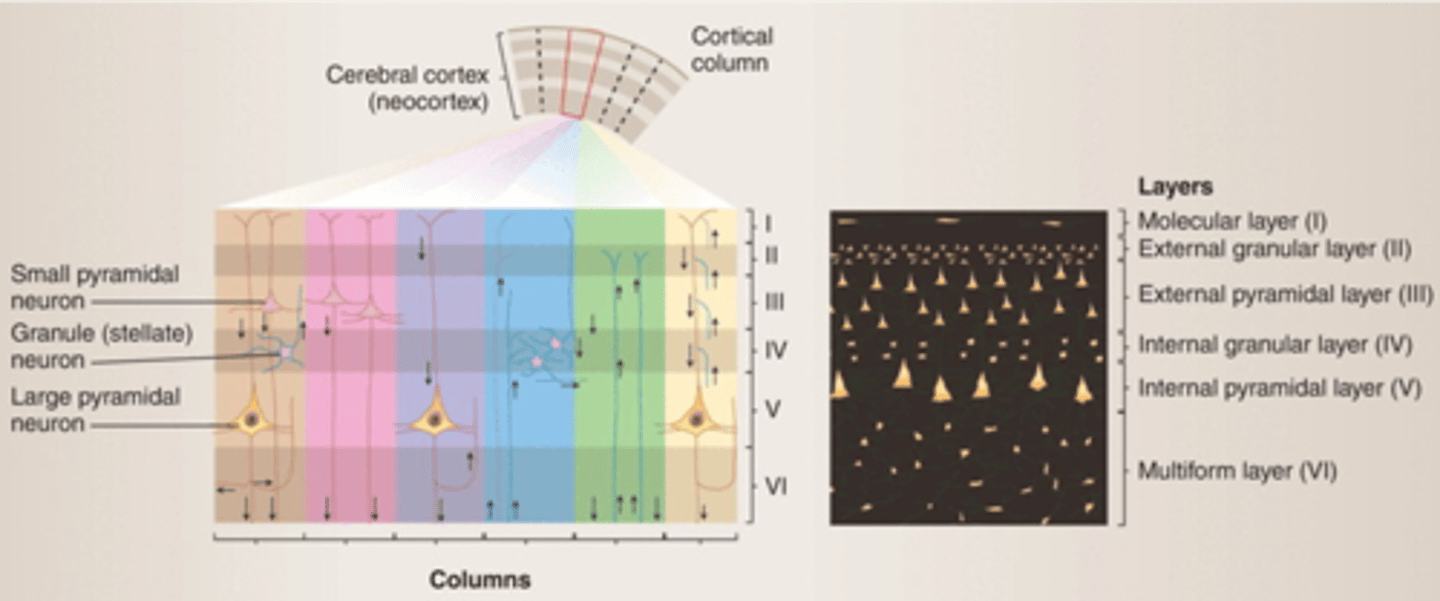
differences in cytoarchitecture can be mapped out as __________ areas
brodmann

what brodmann areas make up the primary somatosensory cortex (postcentral gyrus)?
areas 3, 1, and 2
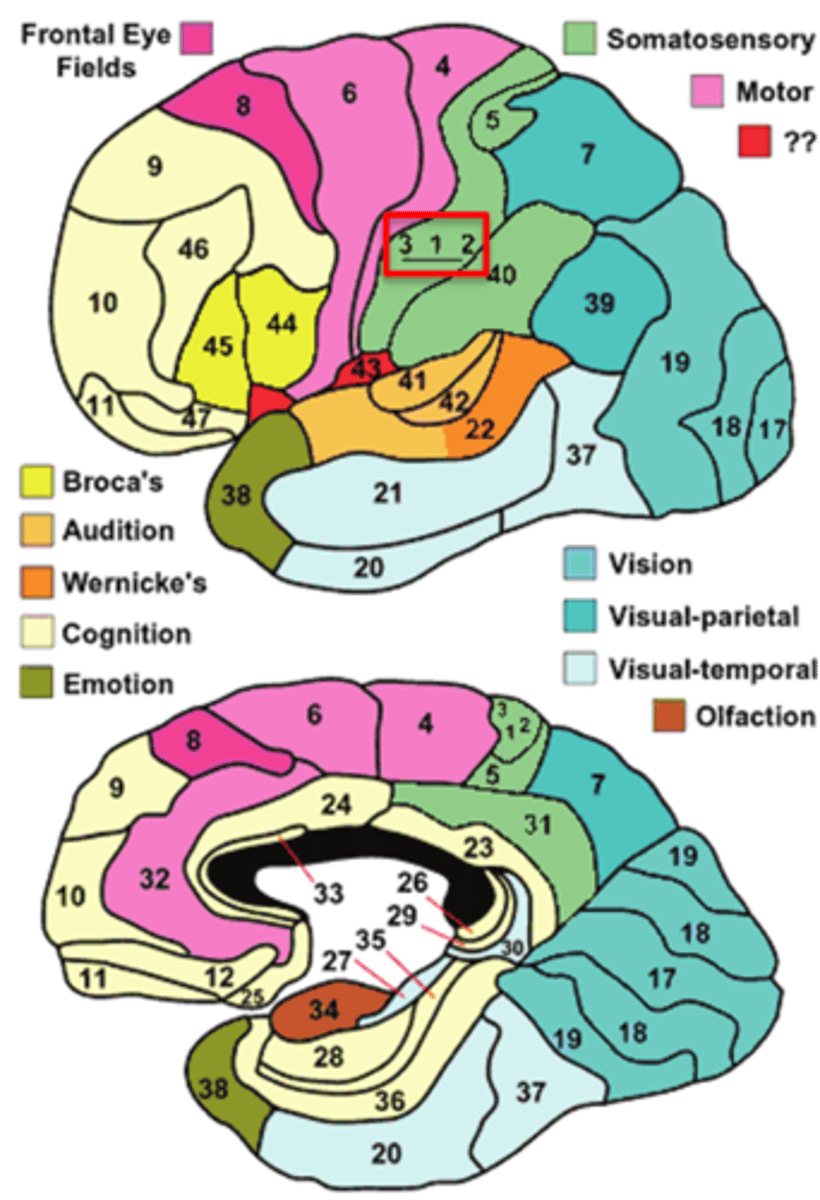
what brodmann area makes up the primary motor cortex (precentral gyrus)?
area 4
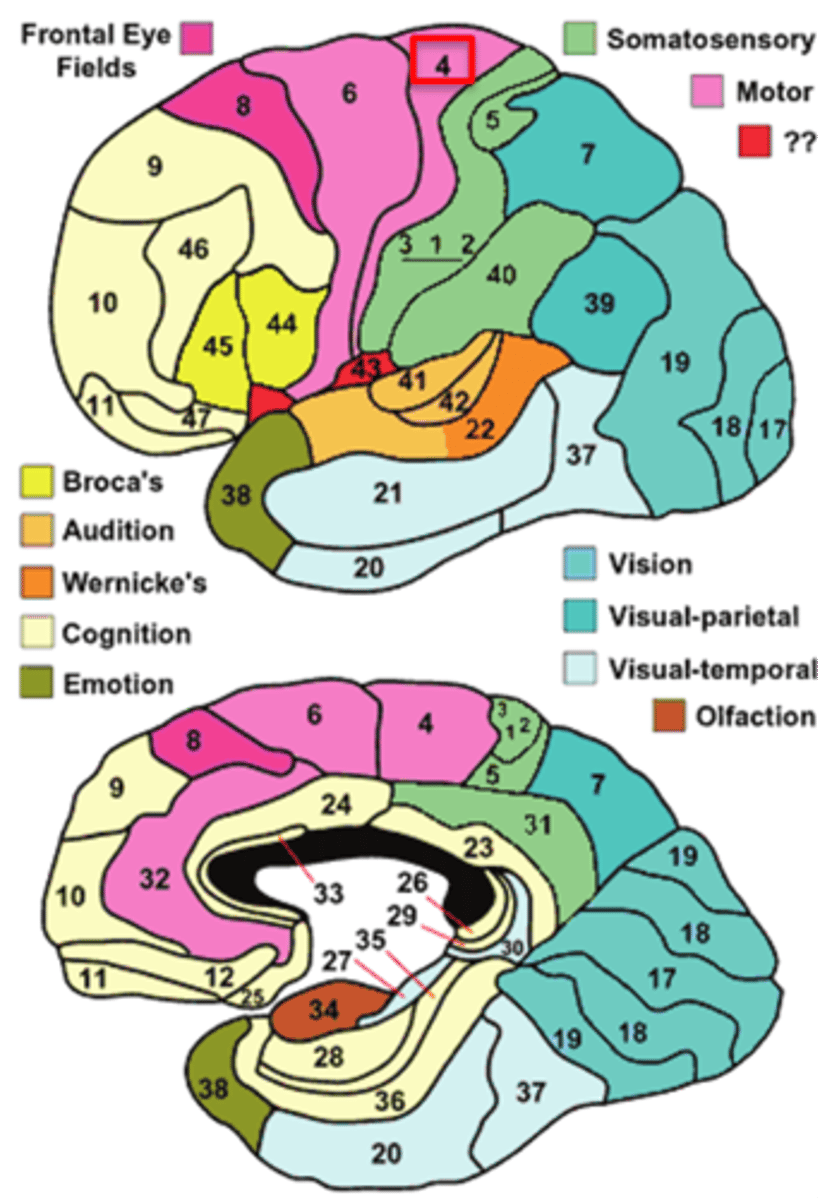
what brodmann area makes up the primary visual cortex?
area 17
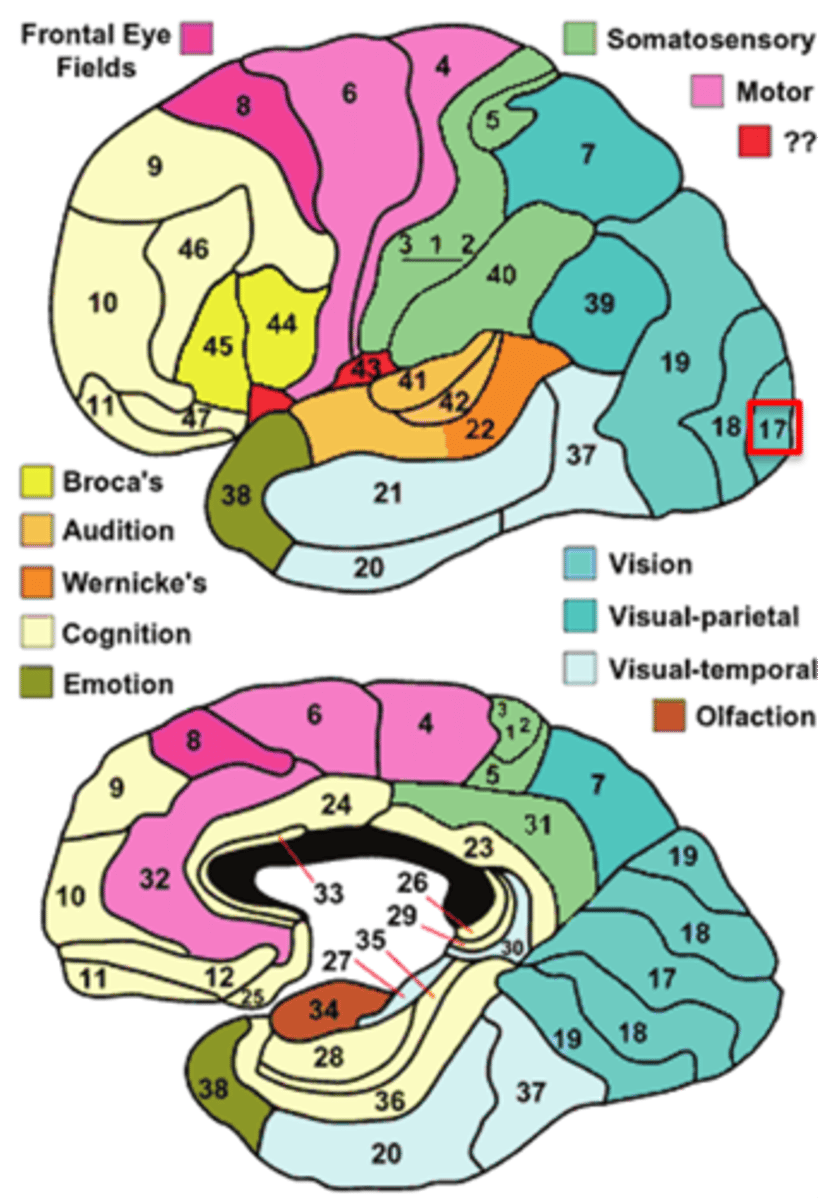
what brodmann area makes up the primary auditory cortex?
area 41
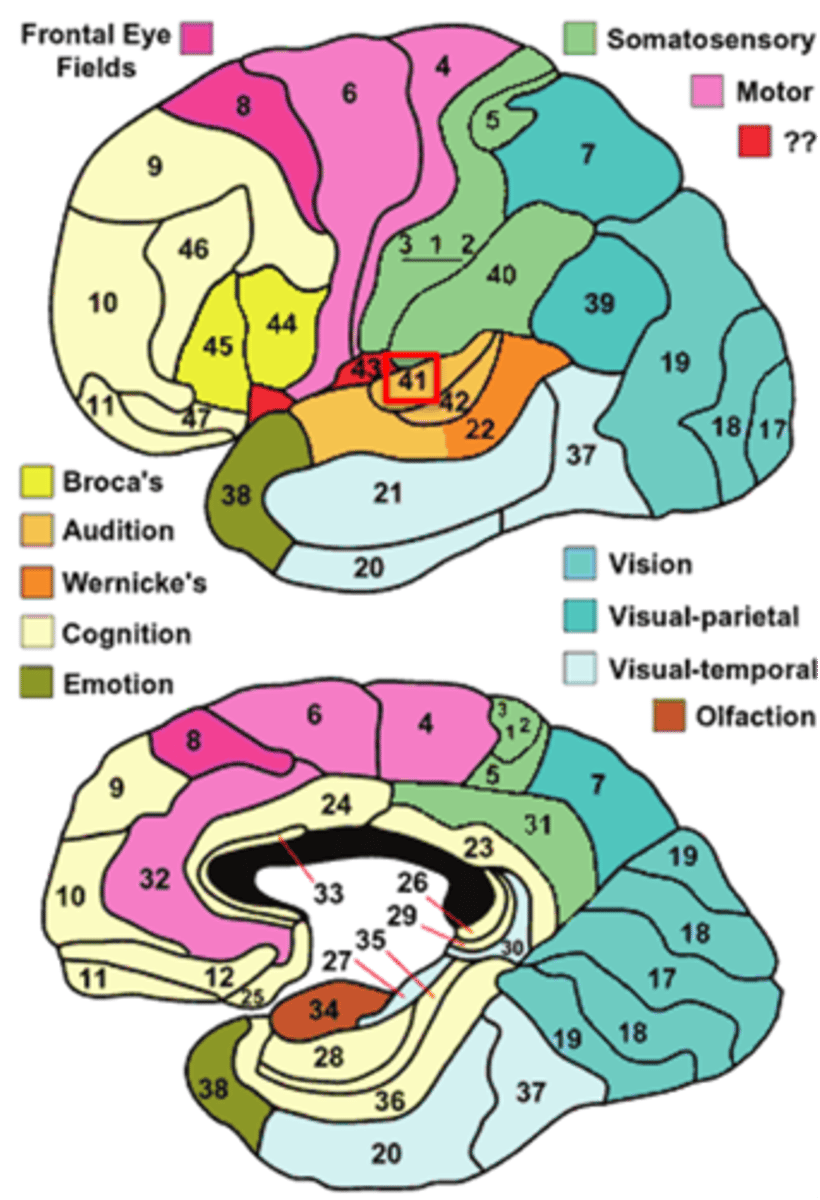
what brodmann areas make up Broca's area?
area 44 and 45
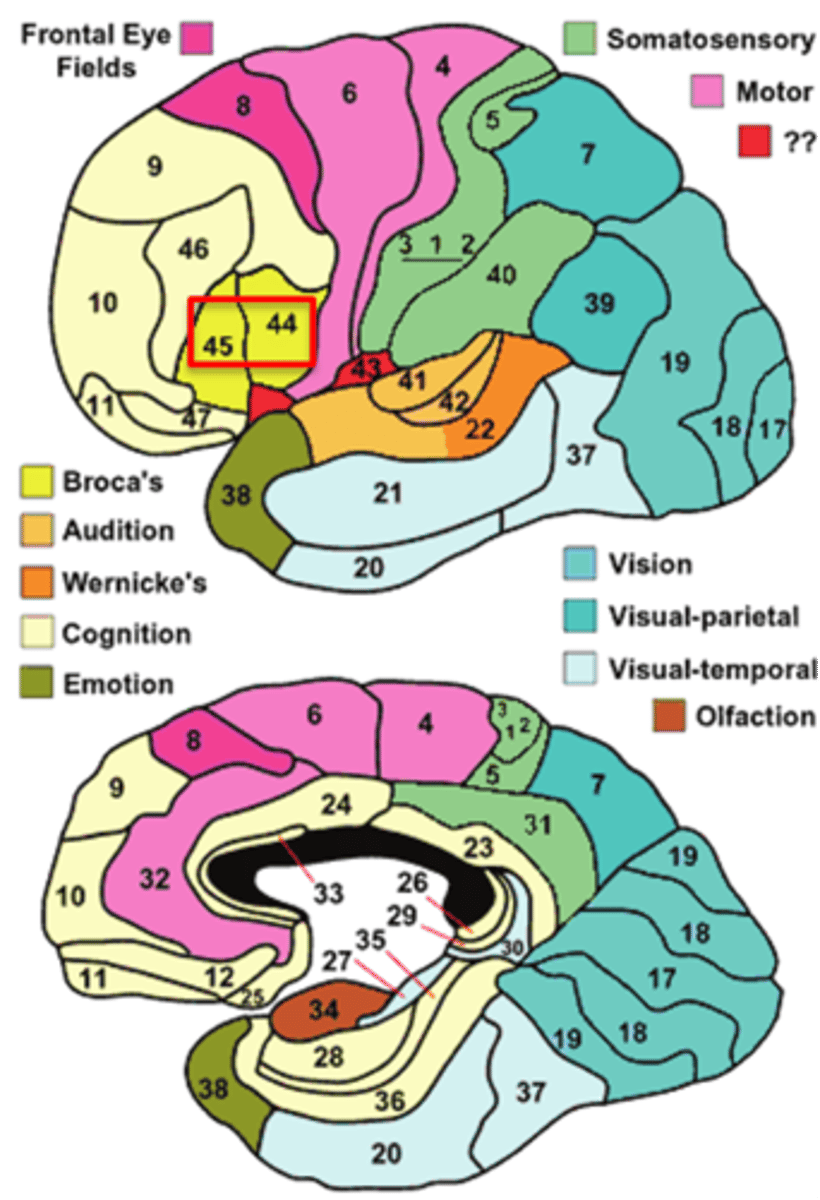
what brodmann areas make up Wernicke's area?
area 22, 39, and 40
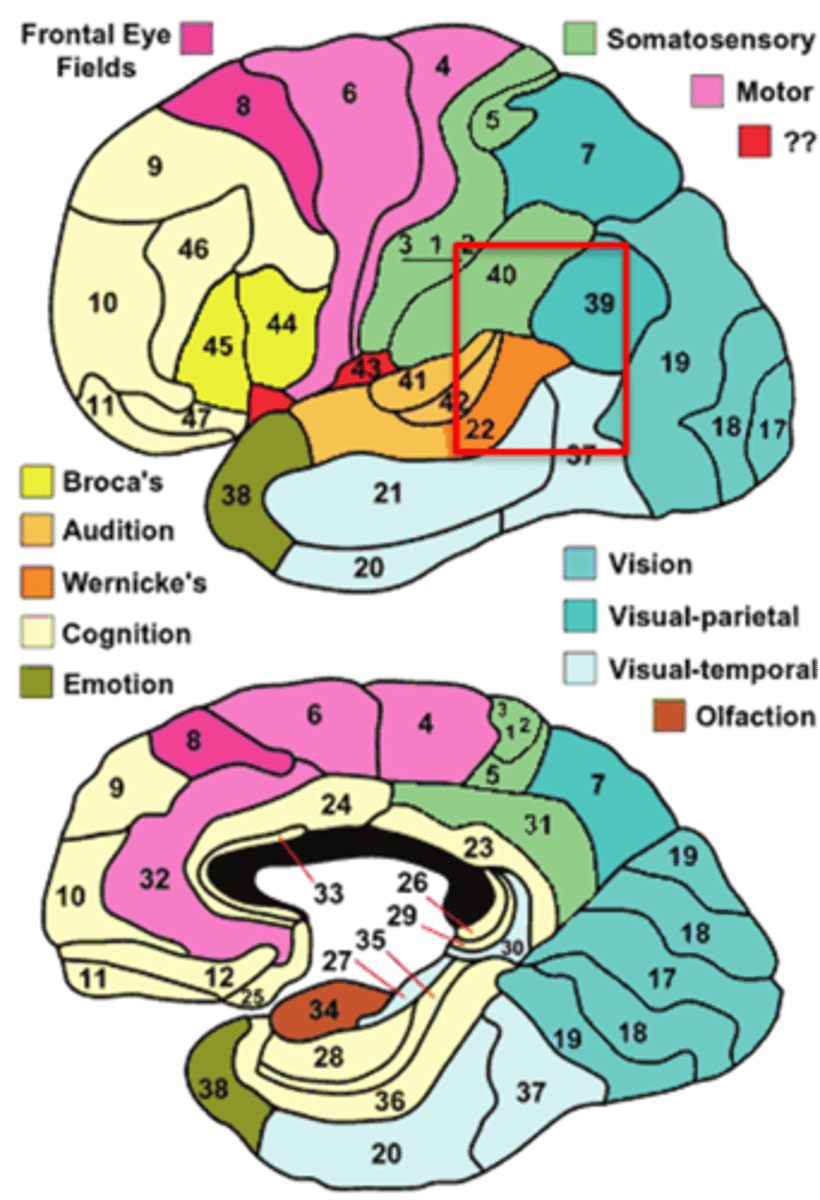
all information entering or leaving the cerebral cortex (or connecting one part of the cortex with another) must pass through subcortical (gray/white) matter
white
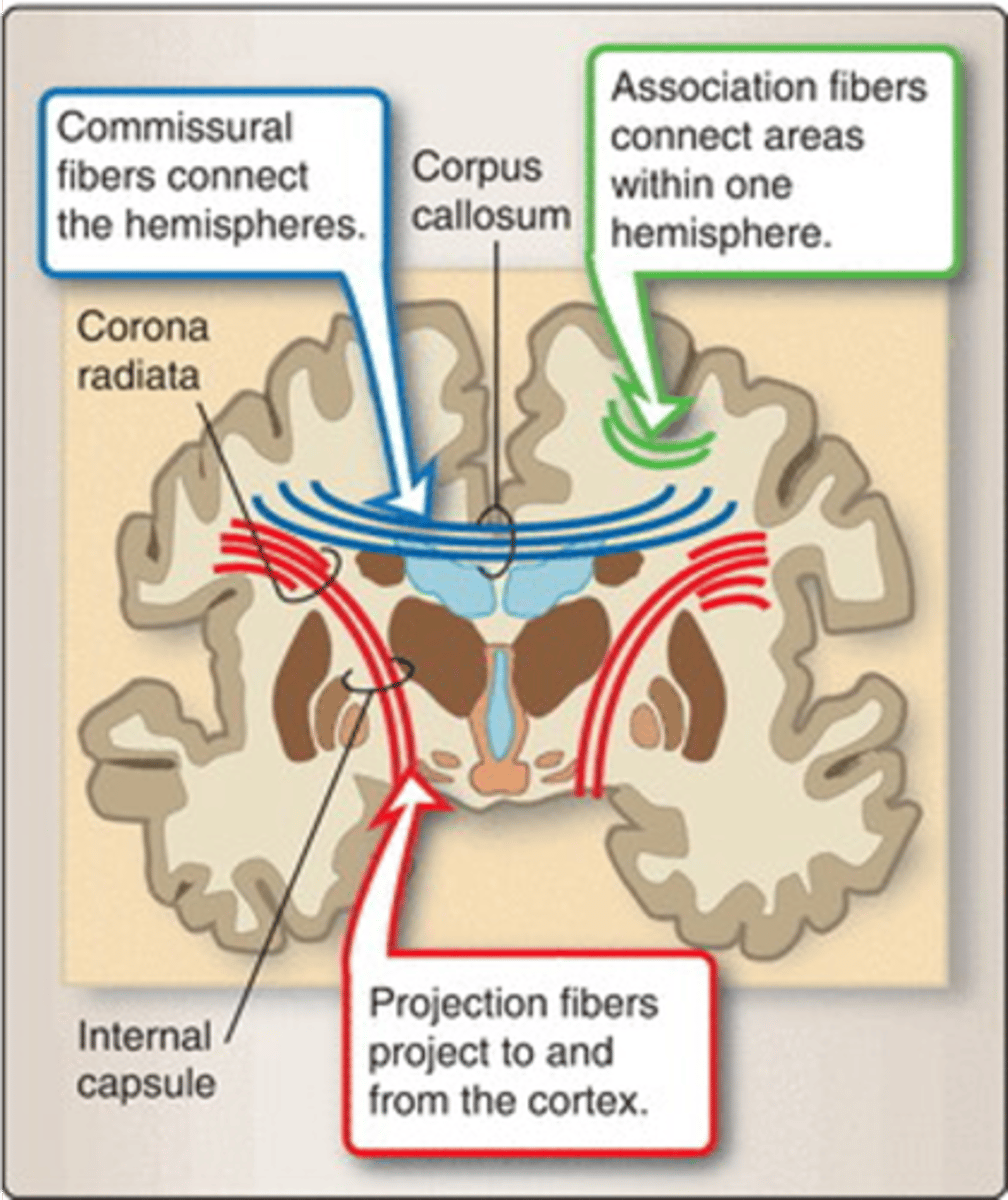
which subcortical fiber bundles interconnect various cortical regions within the same hemisphere?
association fibers
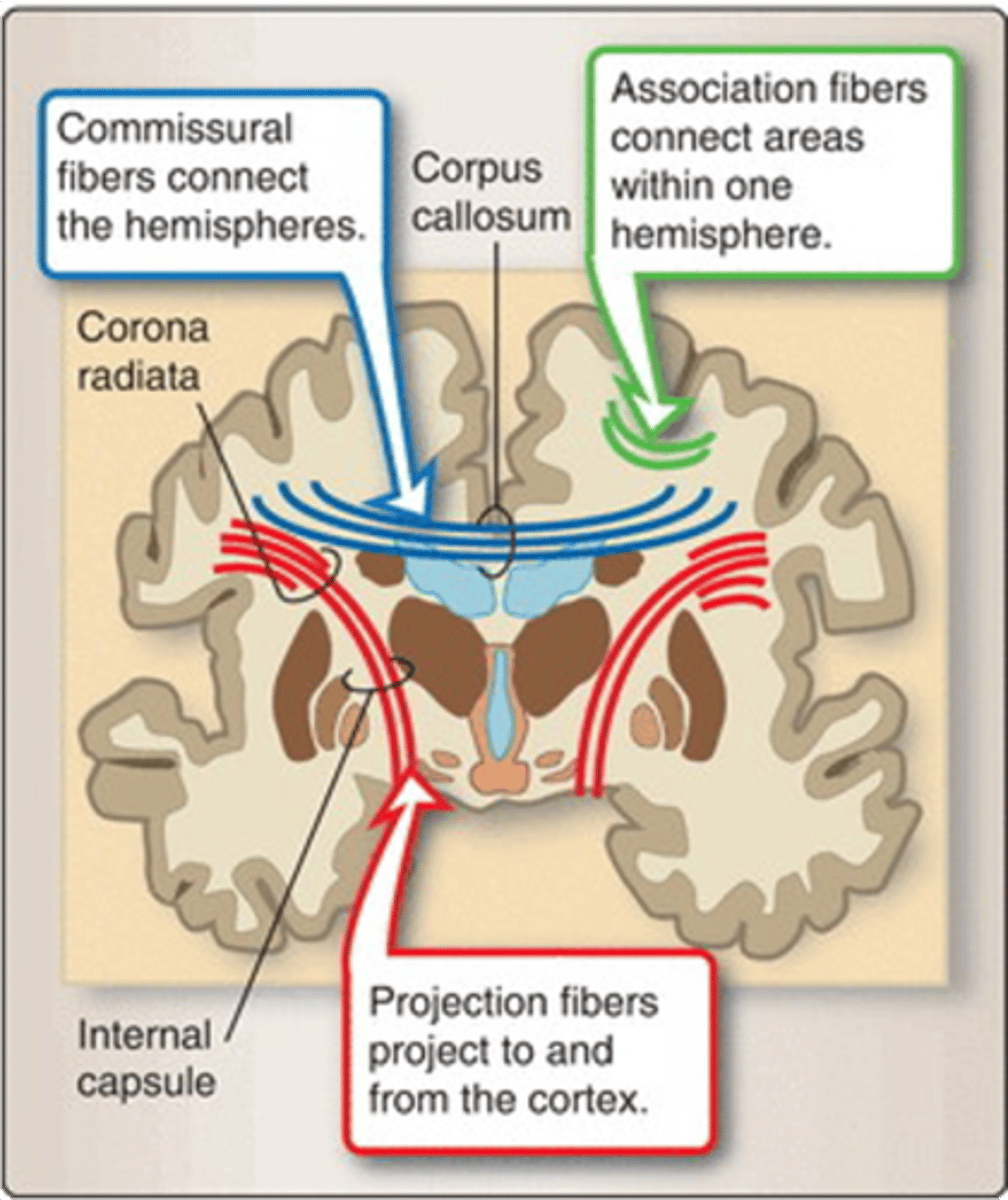
which subcortical fiber bundles reciprocally connect areas of the cortex in one hemisphere with corresponding areas of the opposite hemisphere (includes the largest fibers known as the corpus callosum)?
commissural fibers
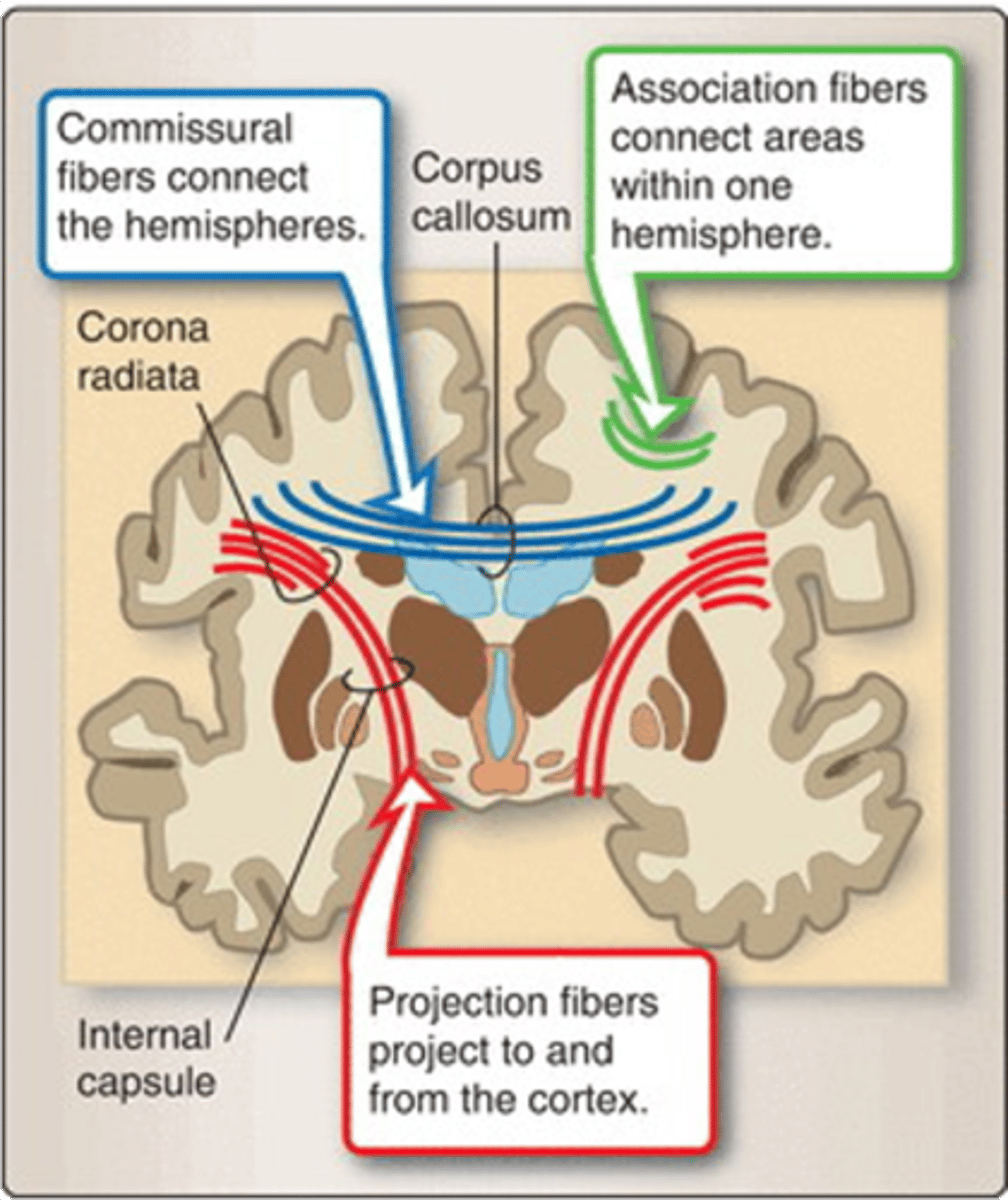
which subcortical fiber bundles carry information to and from the cerebral cortex (from the corona radiata and continues ventrally with the internal capsule)?
projection fibers
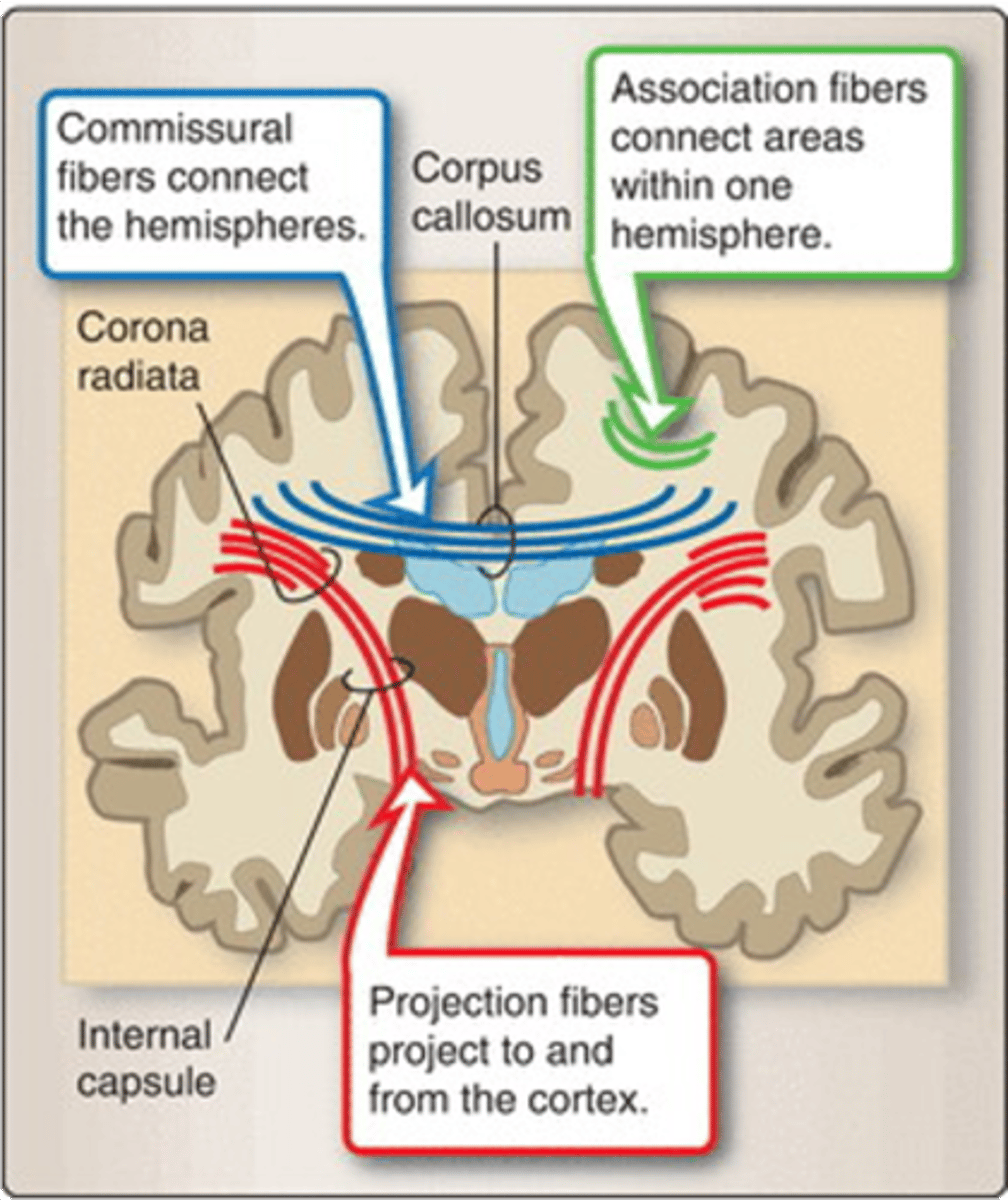
(short/long) association fibers connect areas in the adjacent gyri while (short/long) association fibers connect areas more distant from each other
short, long
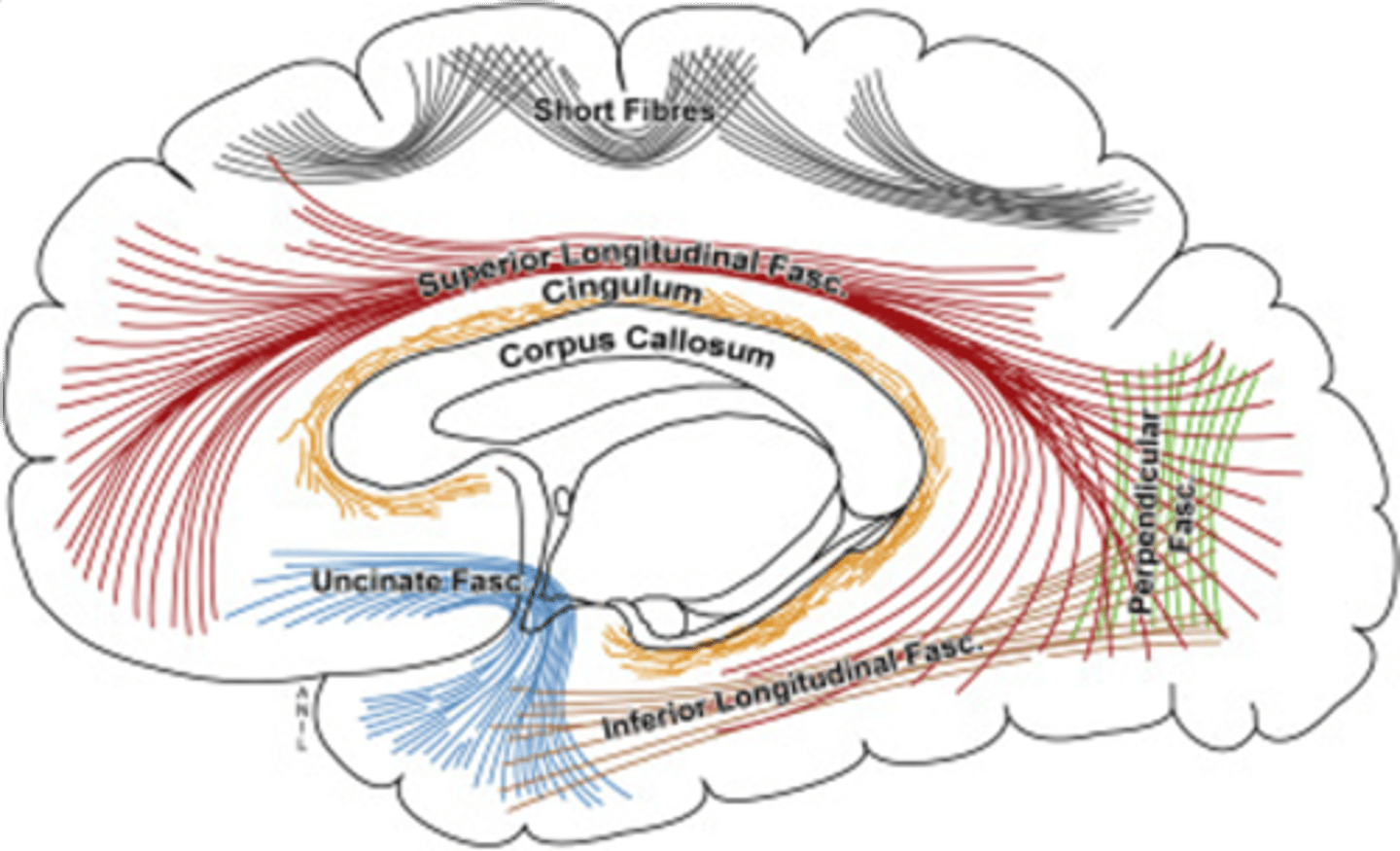
which long association fibers hook around the margin of the lateral fissure to connect the frontal and temporal lobe?
uncinate fasciculus
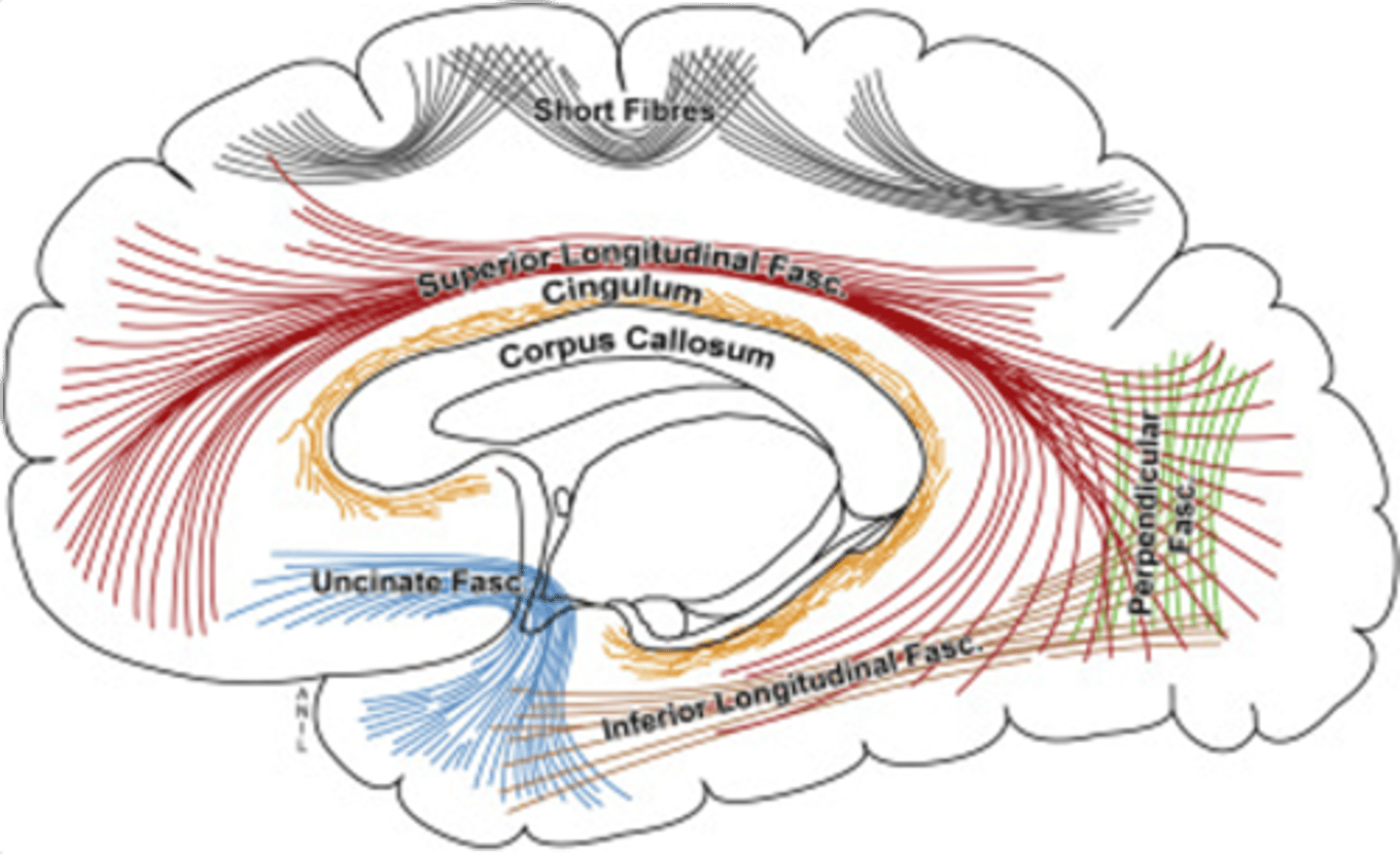
which long association fibers connect the cingulate gyrus to the parahippocampal gyrus?
cingulum fasciculus
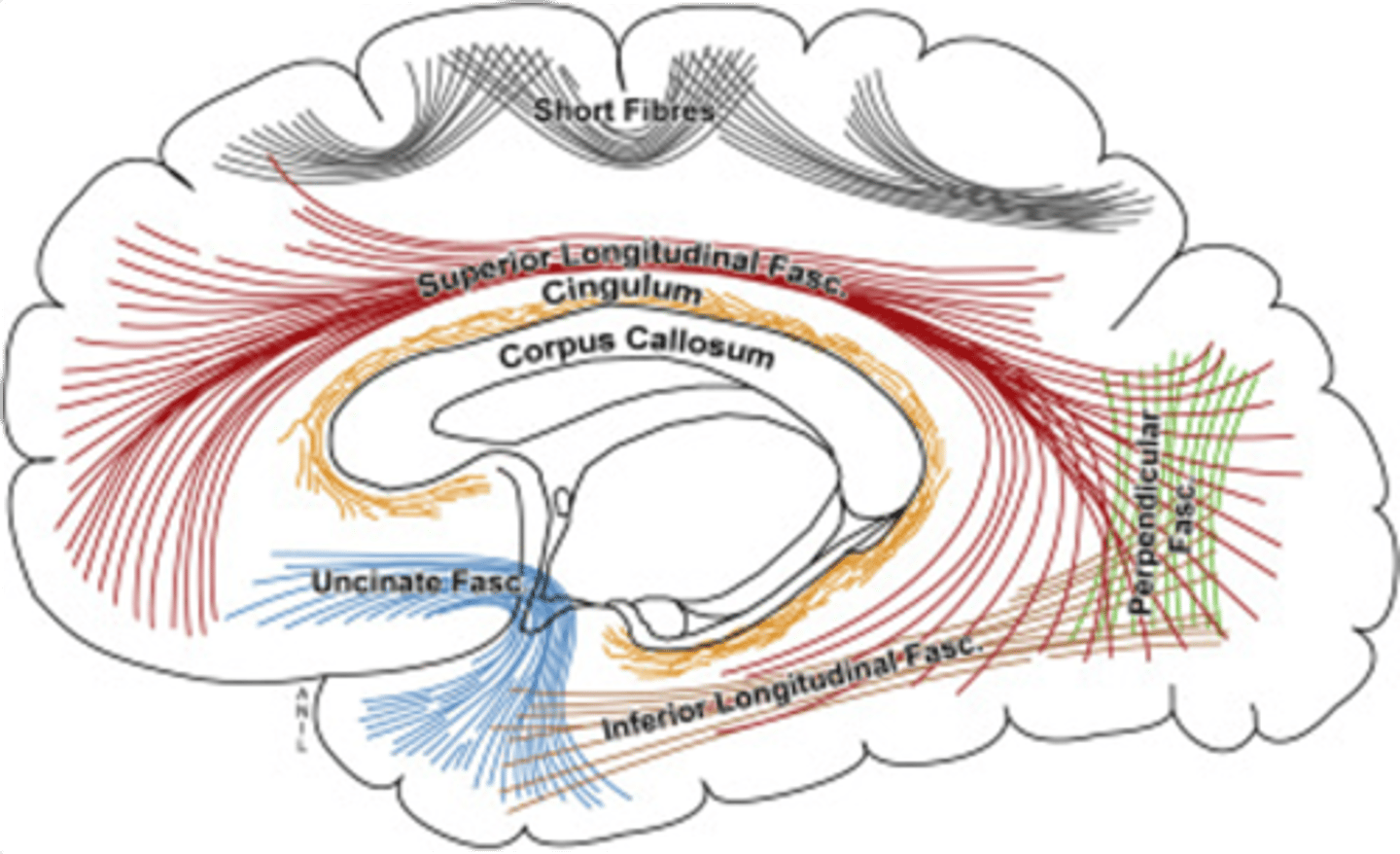
which long association fibers connects the front lobe to occipital and temporal lobes?
superior longitudinal fasciculus
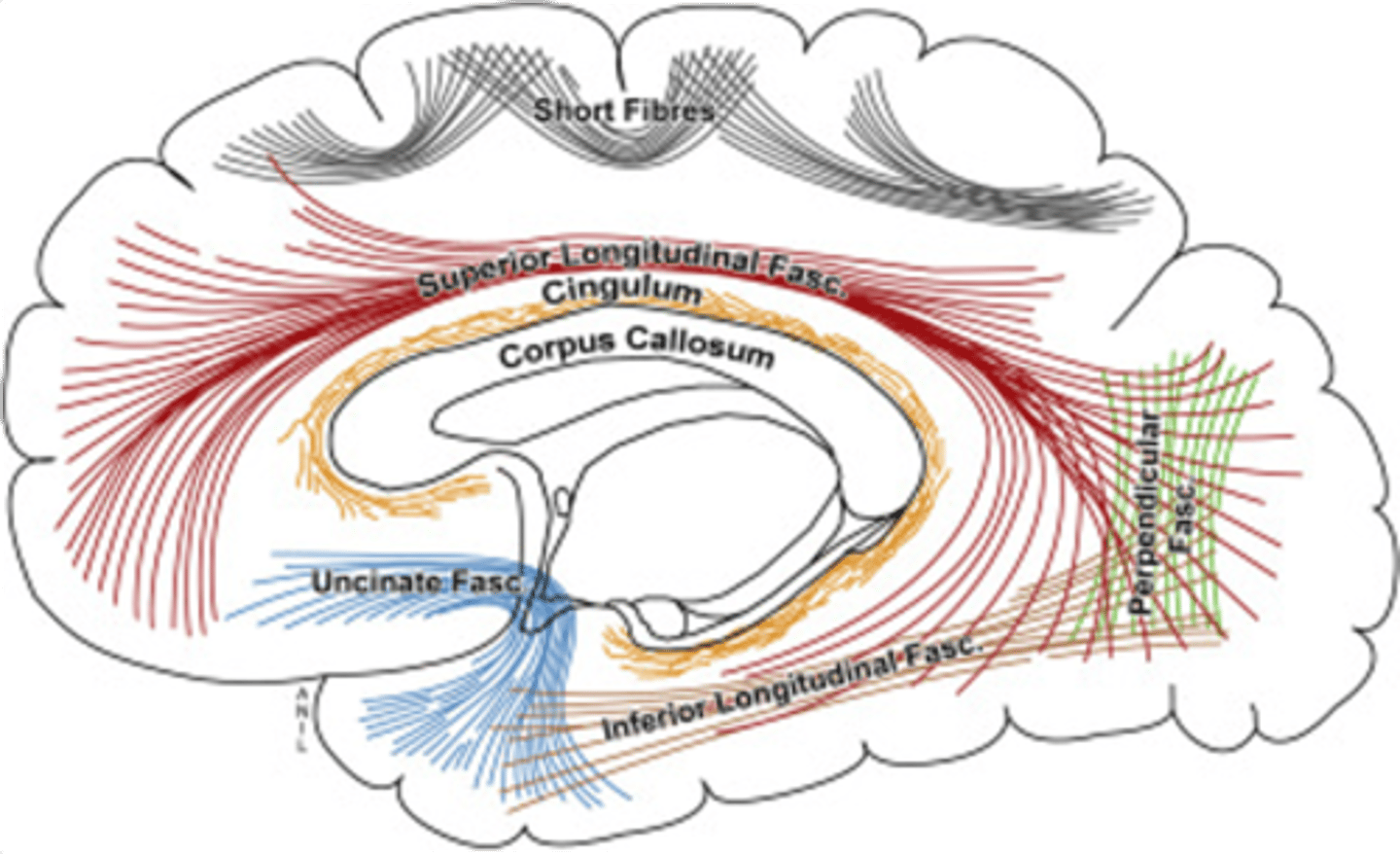
which long association fibers connects the temporal lobe to the occipital lobe?
inferior longitudinal fasciculus

most commissural fibers of the corpus callosum are (inhibitory/excitatory). why?
inhibitory; to ensure that the cerebral hemispheres do not compete with each other and that cortical output is coordinated
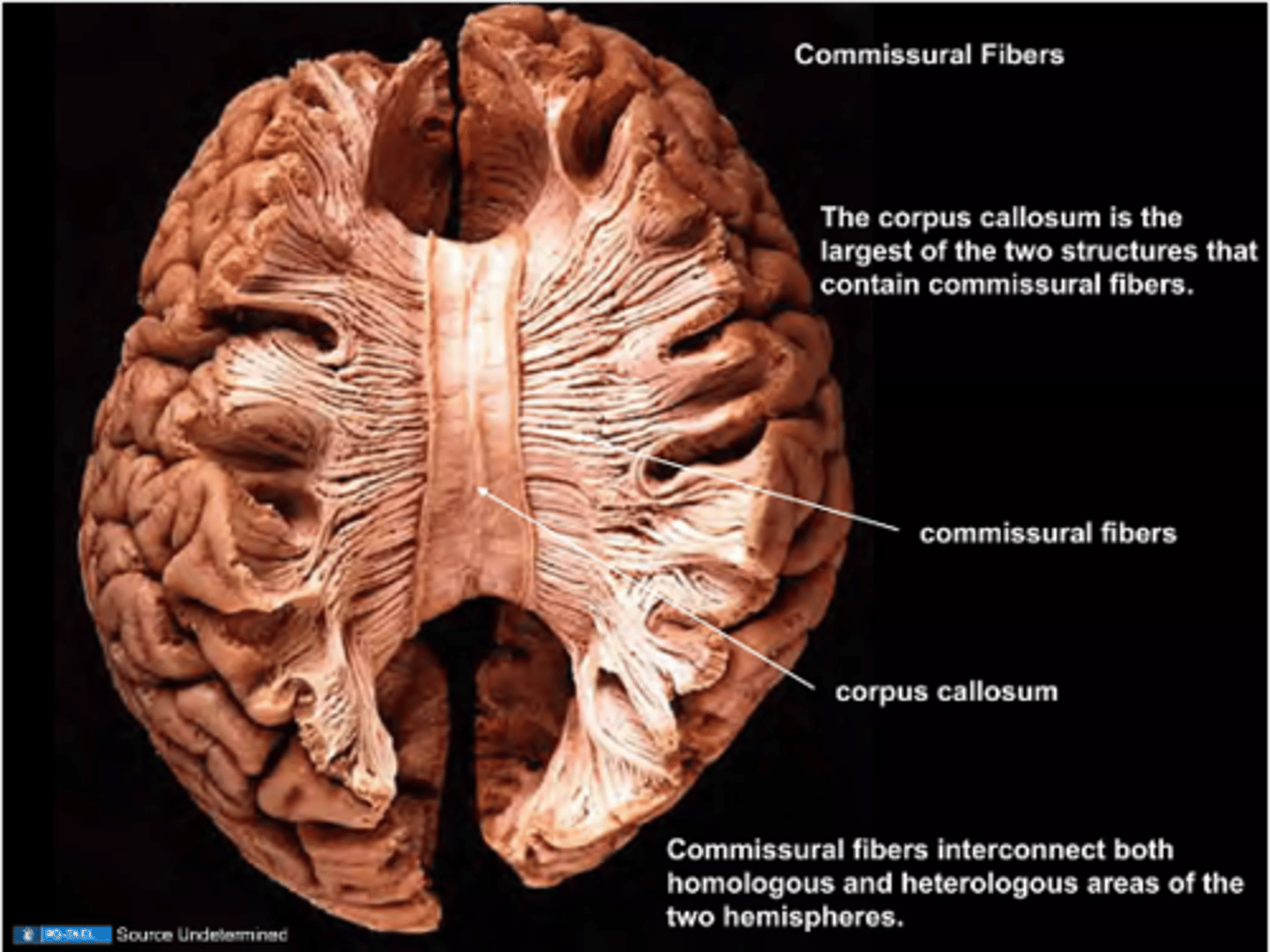
(anterior/posterior) commissural fibers are small bundles of fibers that connect the temporal lobe, olfactory cortices, and olfactory bulbs with each other
anterior

(anterior/posterior) commissural fibers are located in the midbrain to connect the two pretectal nuclei (part of the visual system)
posterior
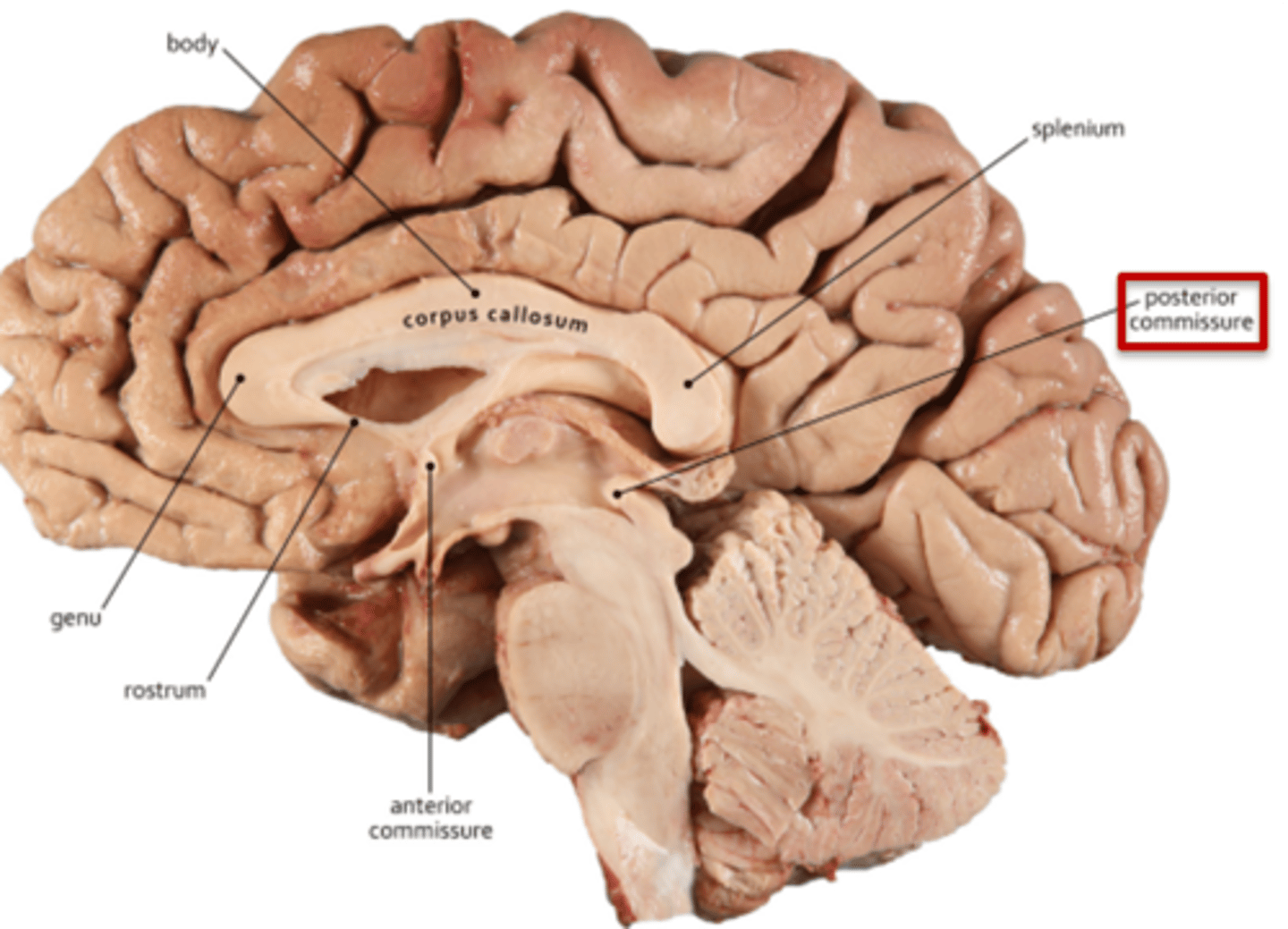
which limb of the internal capsule is found between the caudate and lentiform nucleus?
anterior limb
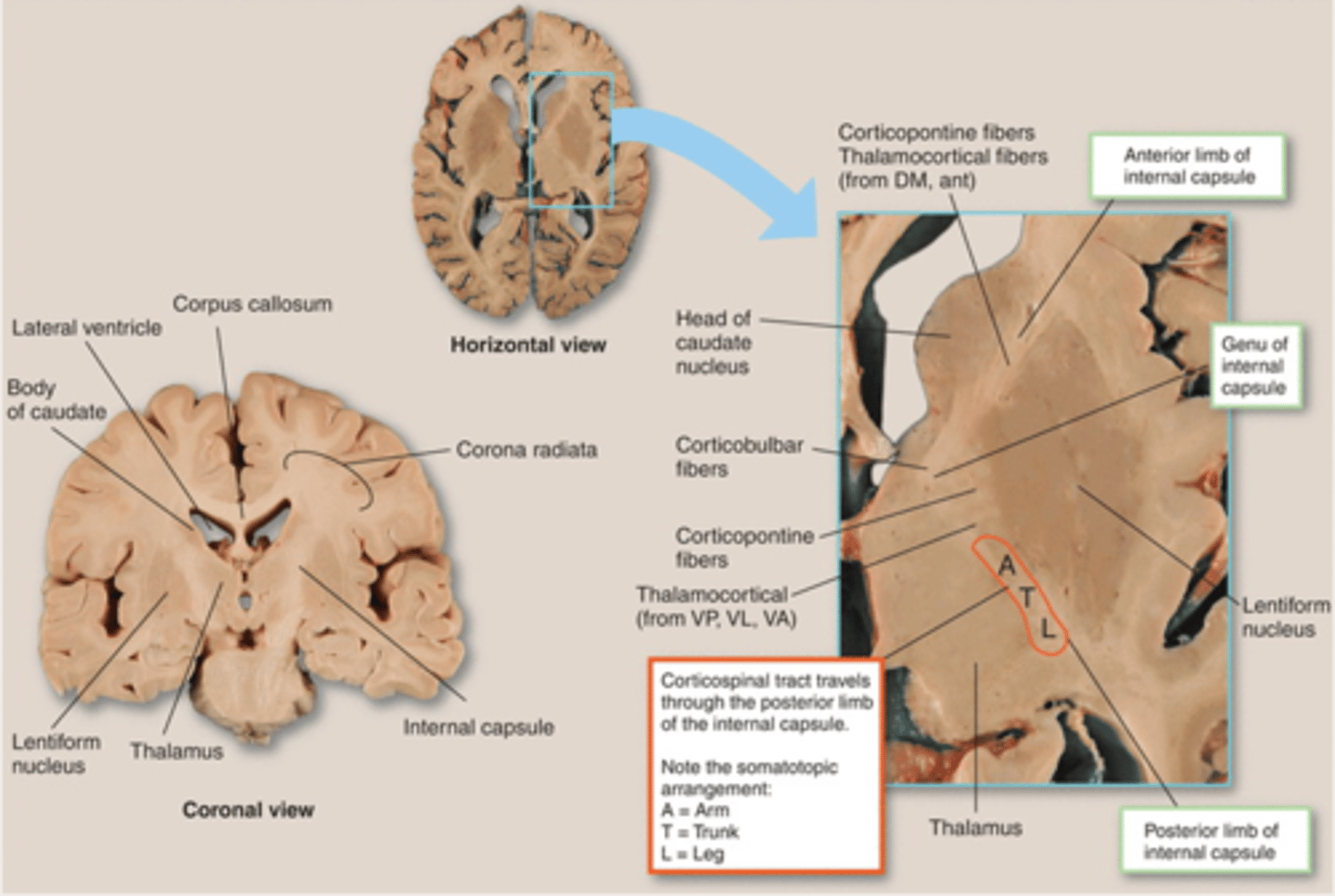
which limb of the internal capsule is found between the thalamus and lentiform nucleus?
posterior limb
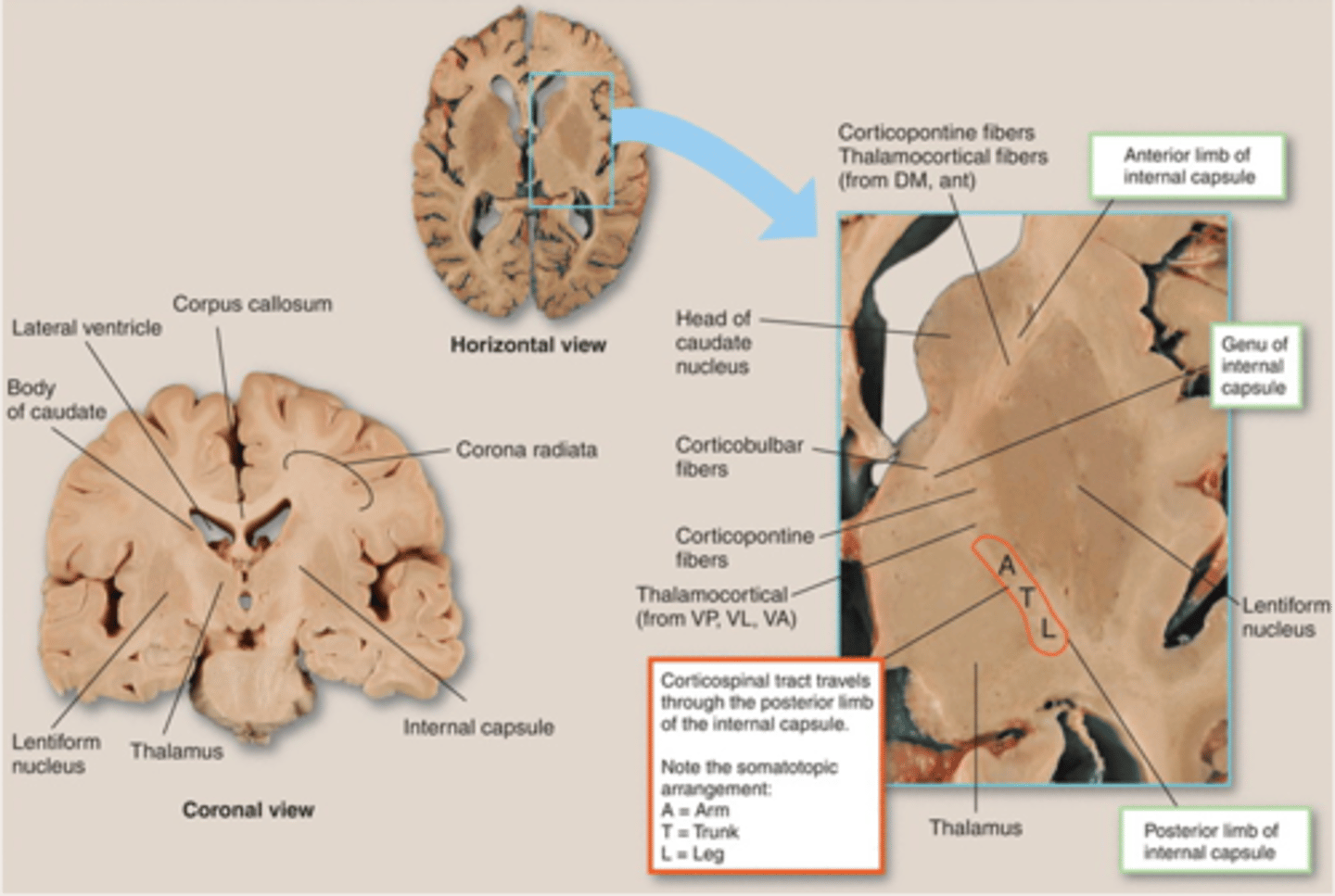
the cerebral hemisphere that is more important in comprehension and production of language is called the (non-dominant/dominant) hemisphere. in the majority of people, this is the (left/right) hemisphere.
dominant, left
non-dominant vs dominant hemisphere: skilled motor formulation and mathematical/analytic processes
dominant
non-dominant vs dominant hemisphere: language
dominant
non-dominant vs dominant hemisphere: creative arts and music
non-dominant
non-dominant vs dominant hemisphere: spatial comprehension
non-dominant
non-dominant vs dominant hemisphere: geometrical and facial recognition
non-dominant
association vs primary functional areas of the cortex: compromises a small portion of the cortex
primary
association vs primary functional areas of the cortex: contains the major motor, major sensory, and major area relating to special senses
primary
association vs primary functional areas of the cortex: compromises the majority of the cortex
association
association vs primary functional areas of the cortex: interconnects and integrates information from the primary sensory and motor area
association
association vs primary functional areas of the cortex: contains the unimodal and multimodal areas
association
(unimodal/multimodal) association areas are adjacent to the primary areas to modulate the primary areas
unimodal

(unimodal/multimodal) association areas are involved in higher-order processing, integrating, and interpreting information from more than one modality
multimodal
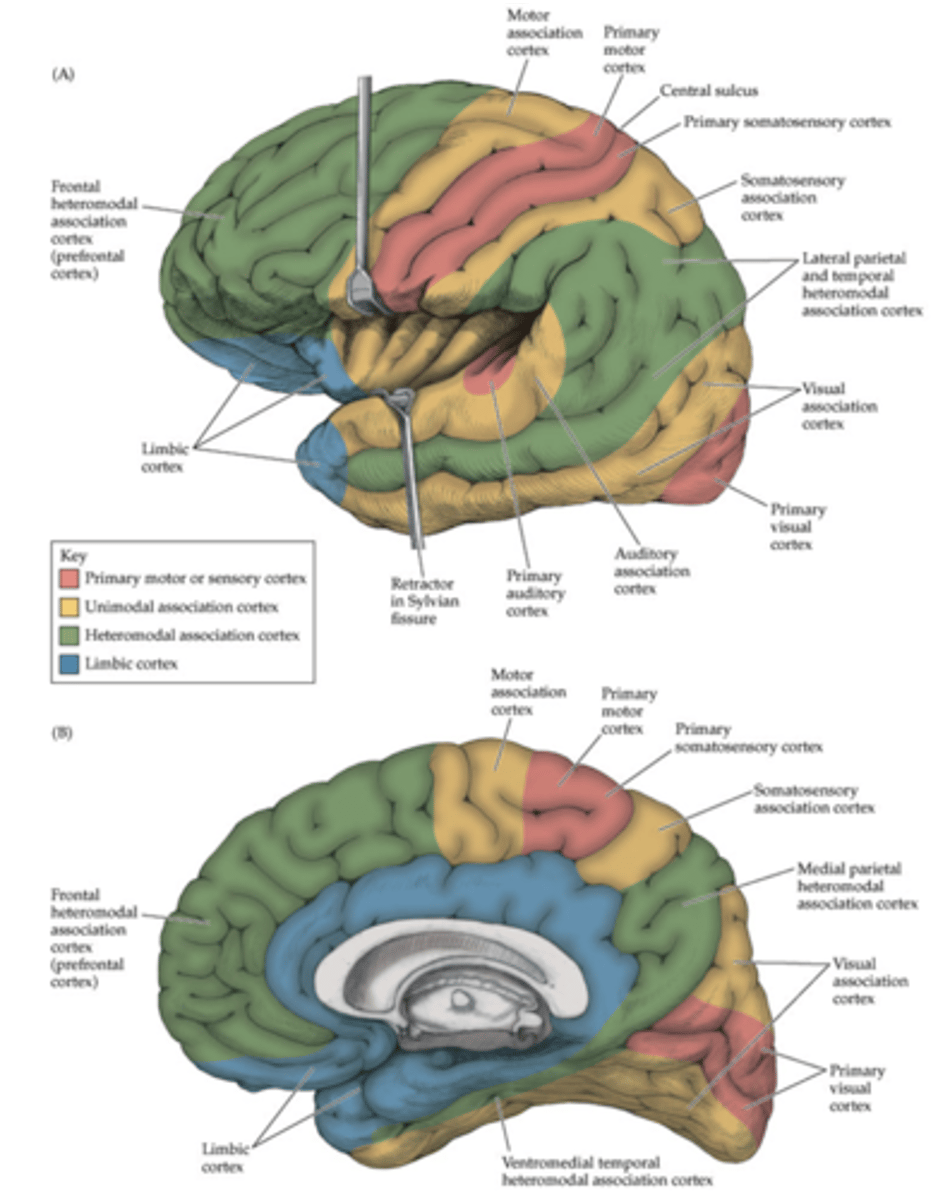
which lobe of the cerebral cortex is involved in motor functions and high order cognitive processes like decision making, reasoning, personality expression, and social cognition?
frontal lobe

which lobe of the cerebral cortex is associated with voluntary motor control?
frontal lobe
which lobe of the cerebral cortex contains Broadmann area 4?
frontal lobe
which lobe of the cerebral cortex contains the anterior paracentral gyrus?
frontal lobe
which region of the frontal lobe occupies the remainder of the precentral gyrus, together with adjacent portions of the superior and middle frontal gyri (in Brodmann area 6)?
motor association cortex
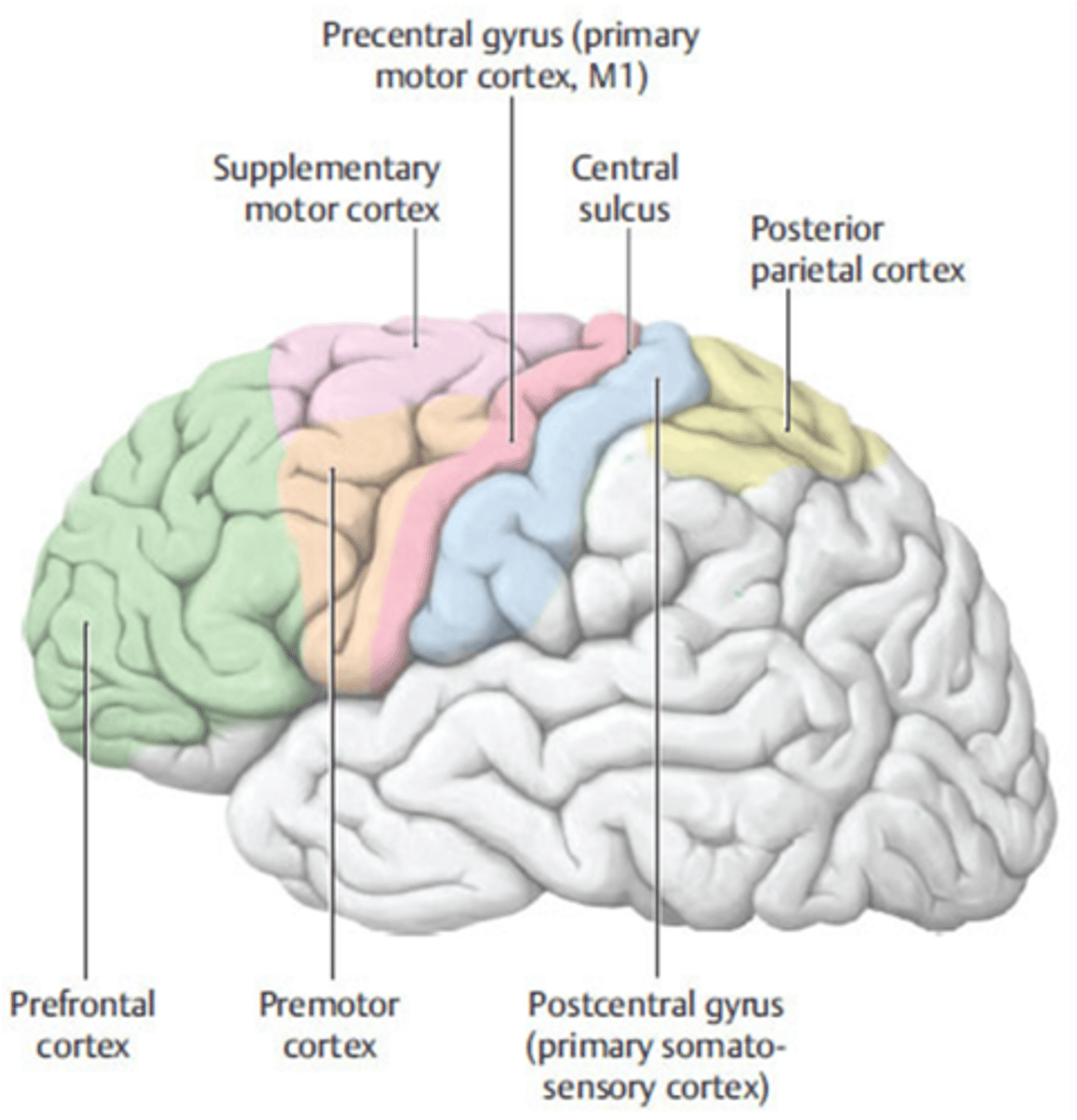
which part of the motor association cortex is on the lateral surface of the frontal lobe, immediately anterior to the primary motor cortex?
premotor cortex
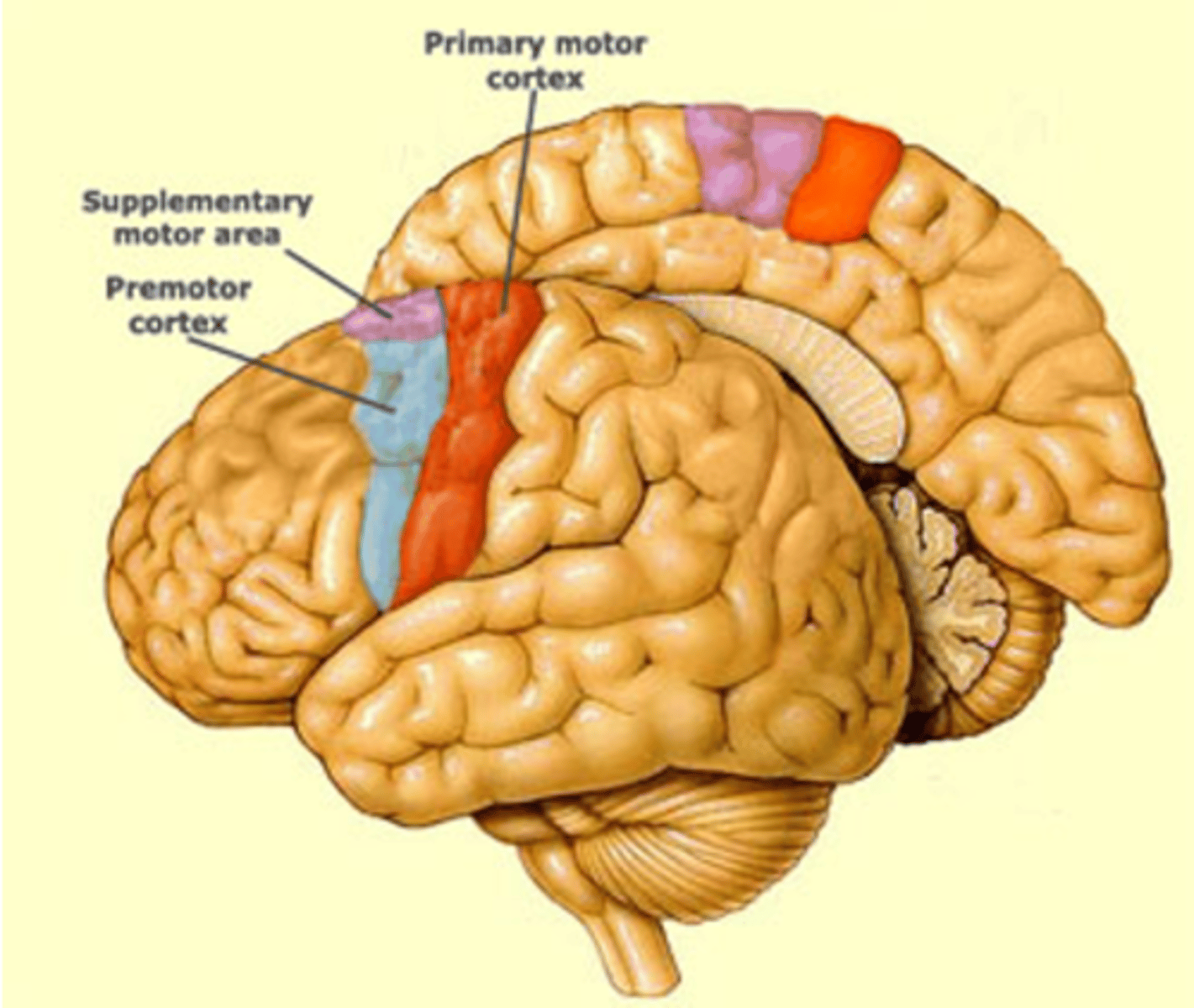
which part of the motor association cortex is important for planning movements guided by external stimuli (like reaching for a seen object)?
premotor cortex
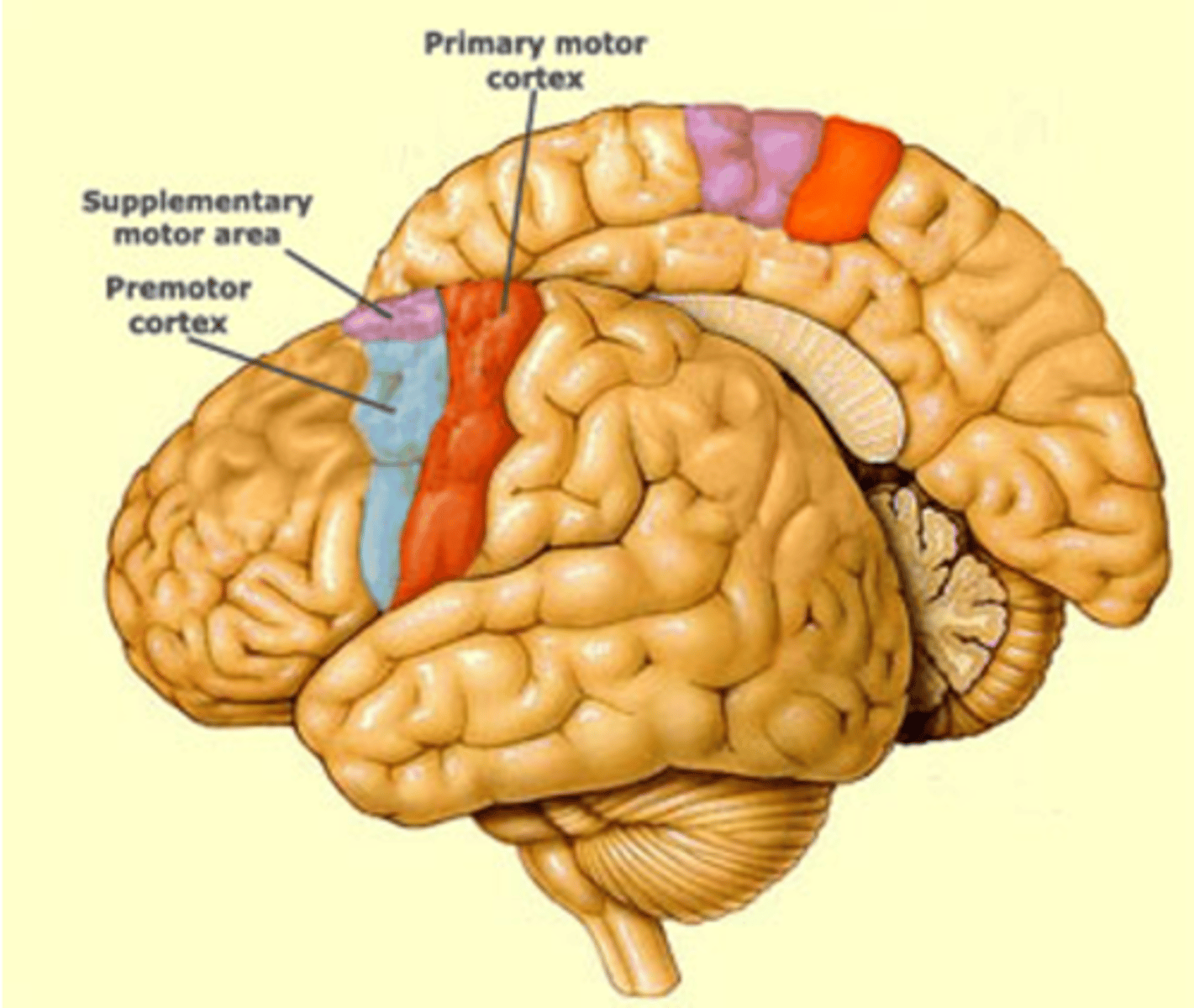
which part of the motor association cortex is on the medial surface of the frontal lobe in the superior frontal gyrus, anterior to the primary motor cortex?
supplementary motor cortex
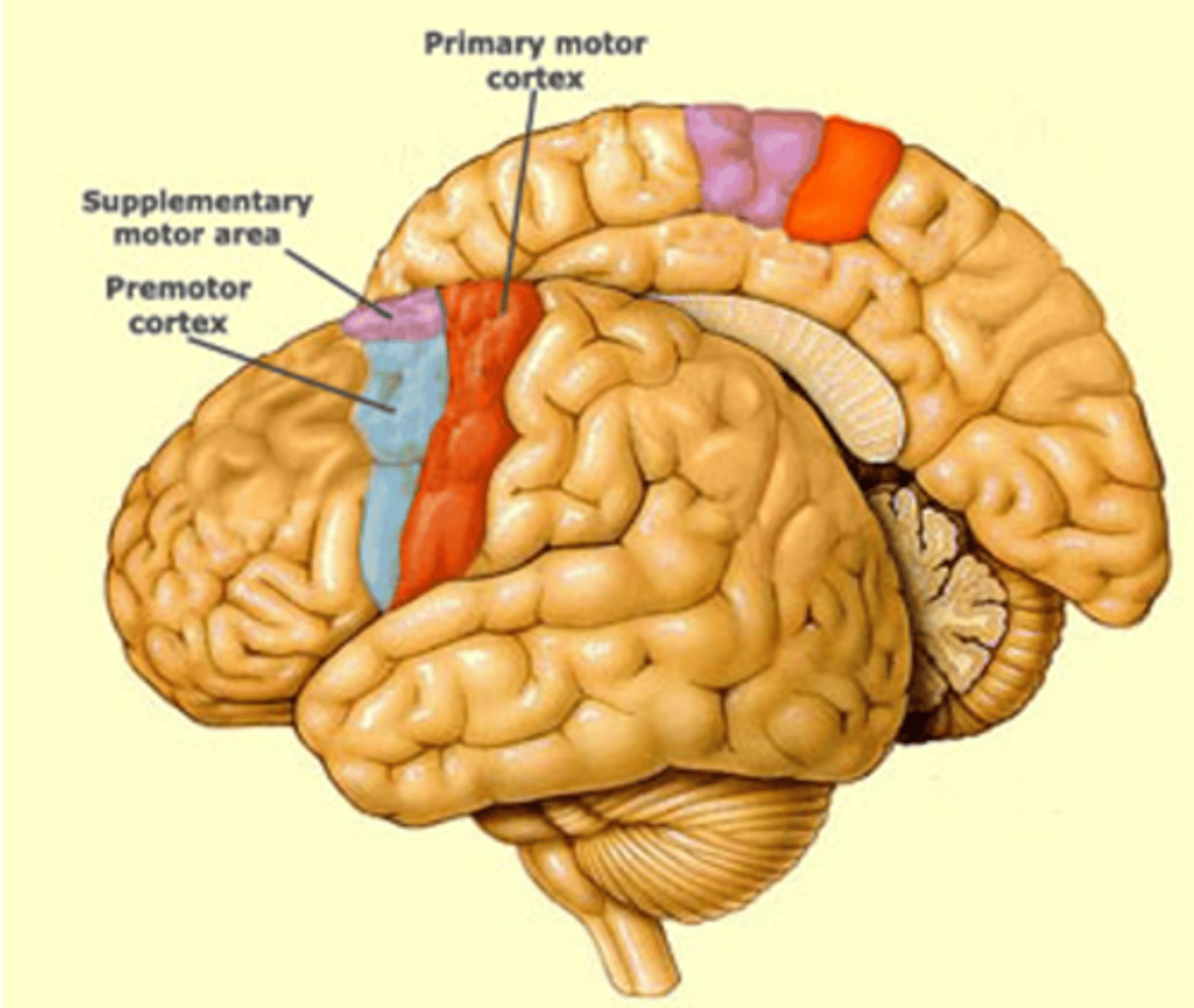
which part of the motor association cortex is important for planning and learning complexes allowing for internally generated movements (like playing a song on the piano from memory)?
supplementary motor cortex

which part of the motor association cortex plays a critical role in the initiation of movements?
supplementary motor cortex
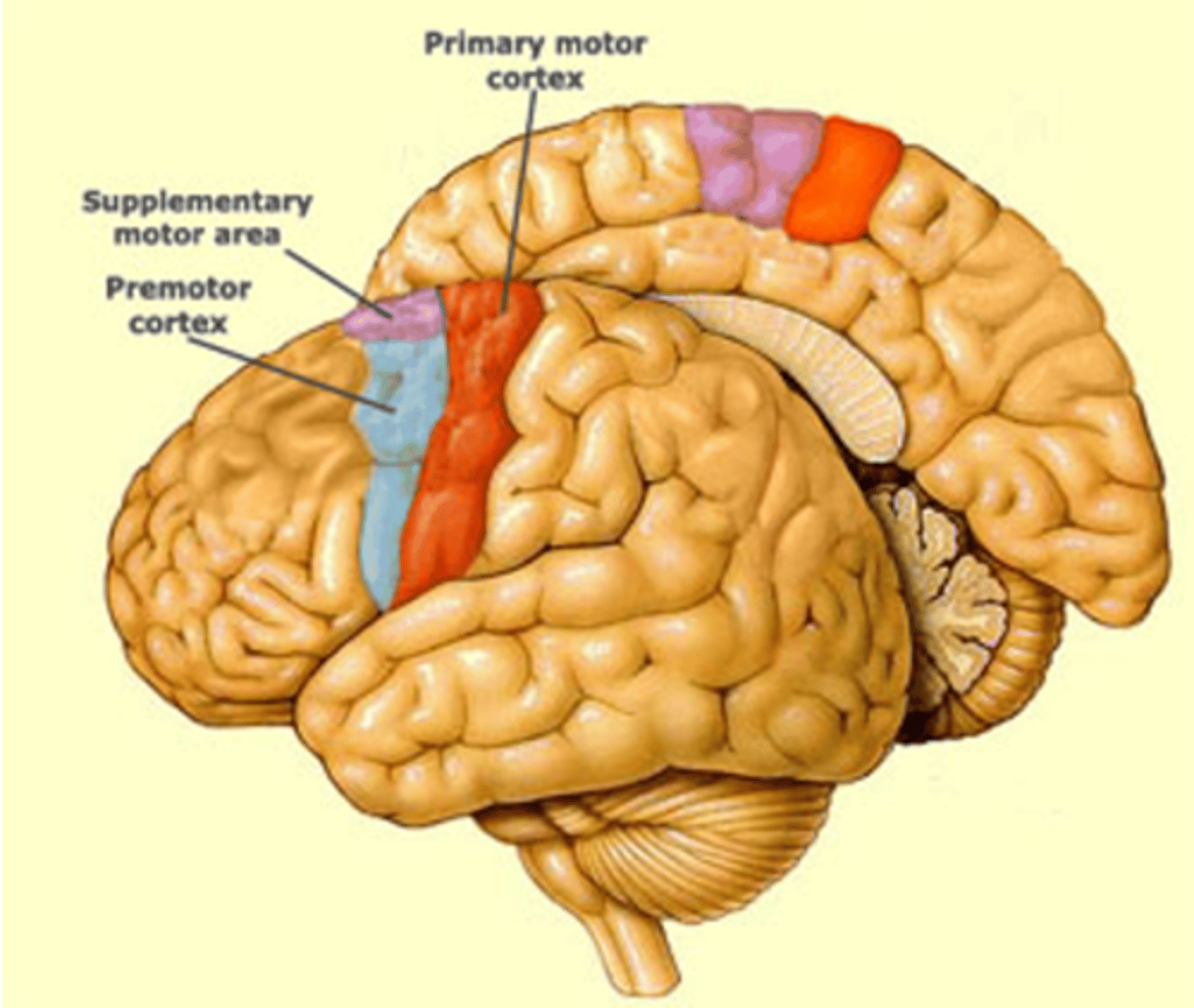
which region of the frontal lobe is located in the caudal portion of the middle frontal gyrus, just anterior to the premotor cortex and is part of the oculomotor system?
frontal eye fields
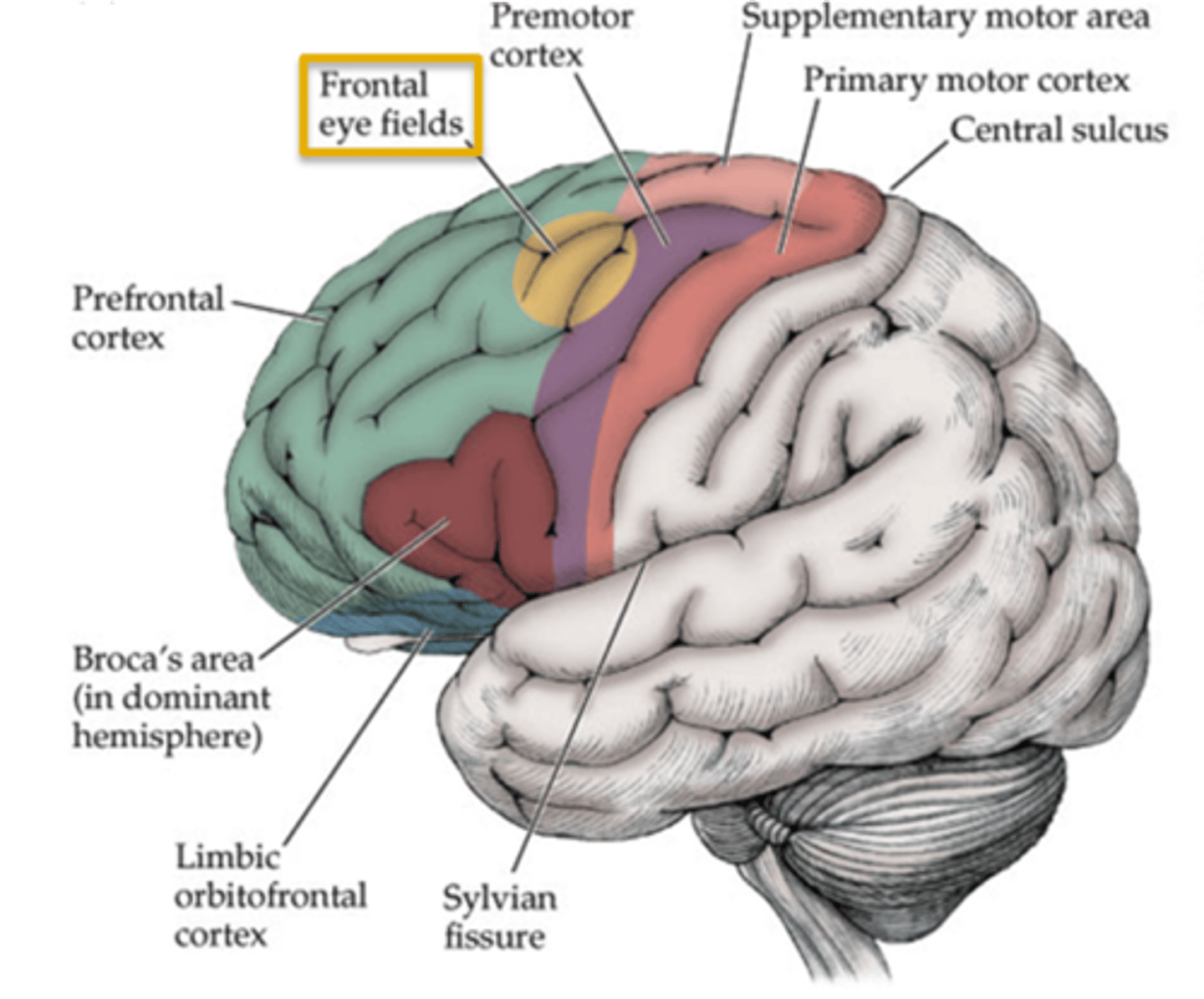
which region of the frontal lobe is involved in voluntary saccades to the contralateral side and in smooth pursuit movements?
frontal eye fields
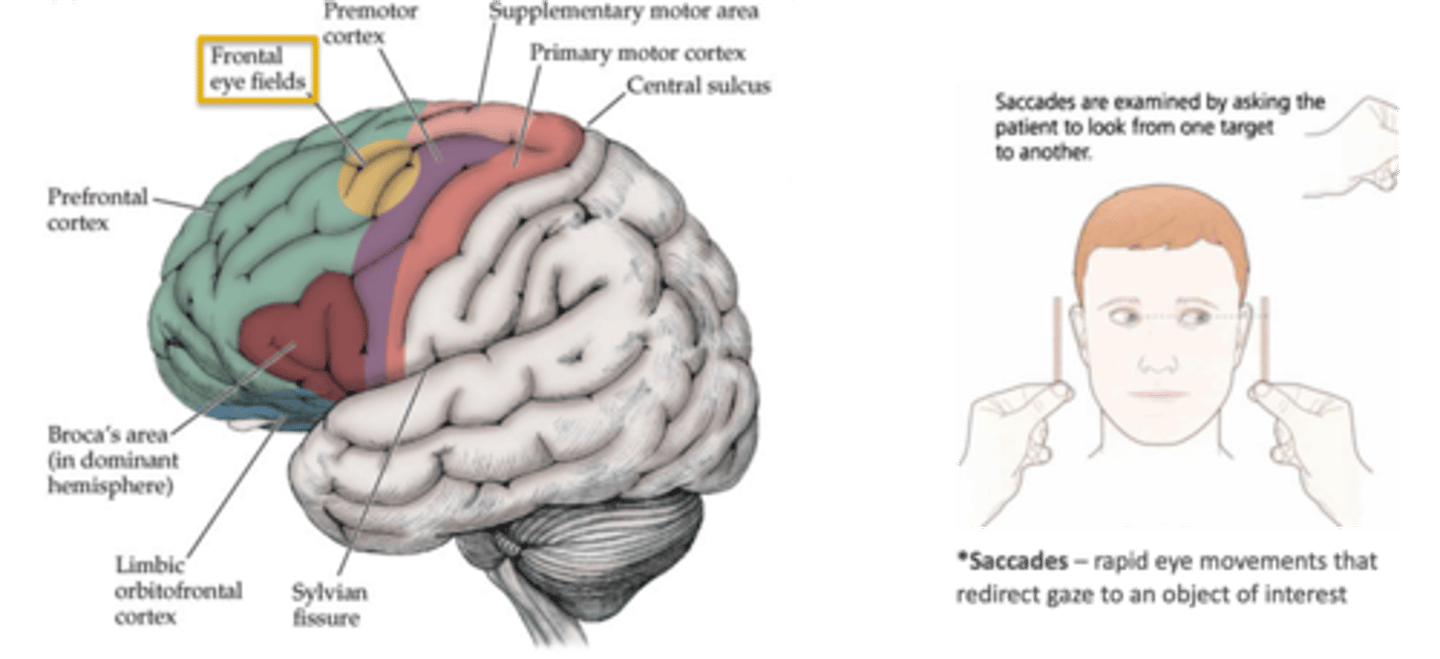
which region of the frontal lobe occupies the majority of the frontal lobe and receives input from all regions of the cerebral cortex, the limbic system, and the brainstem nuclei (projects widely to various regions of the brain)?
prefrontal cortex
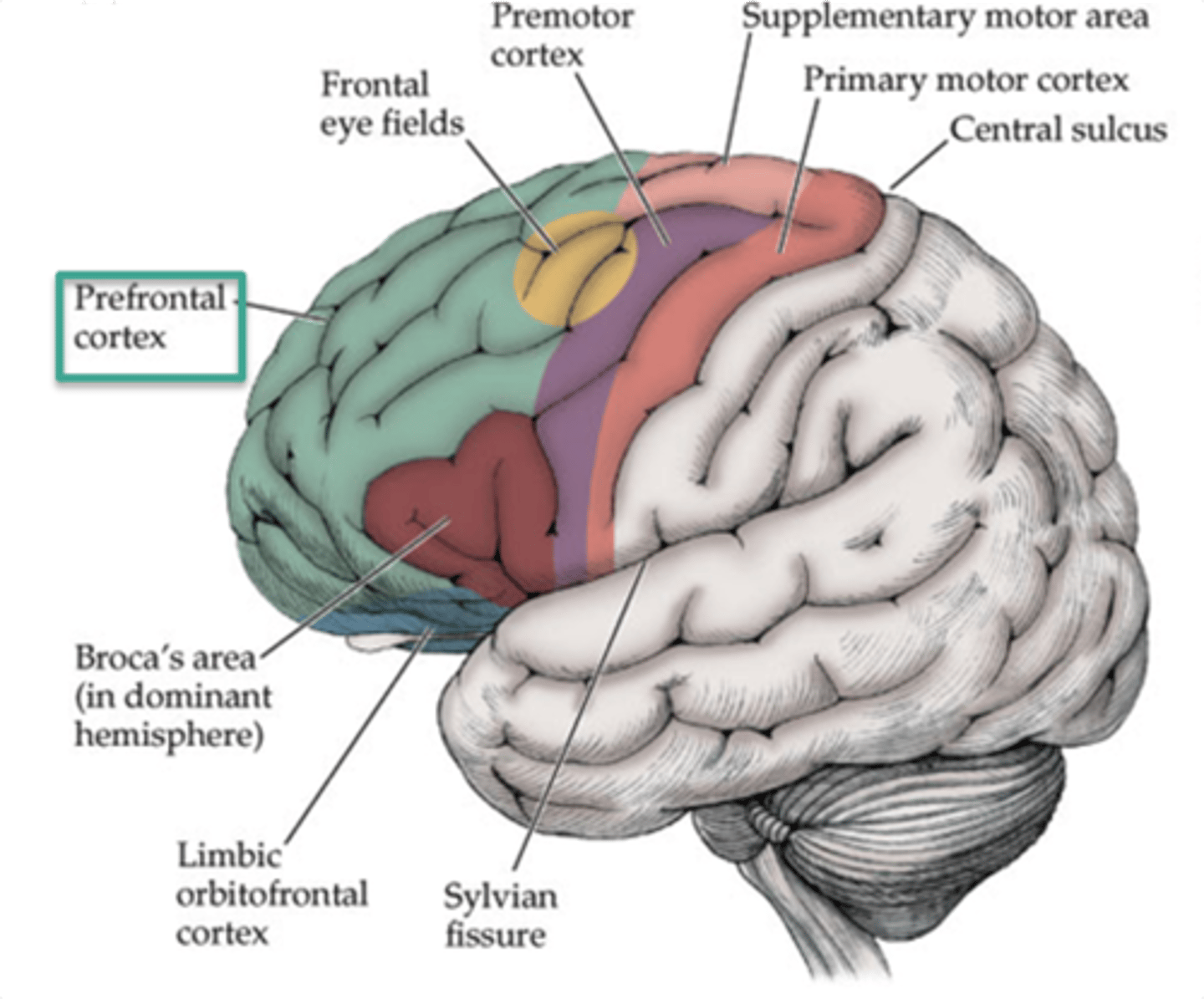
which region of the frontal lobe is involved in high-order cognitive processes such as decision making, reasoning, personality, expression, and social cognition?
prefrontal cortex
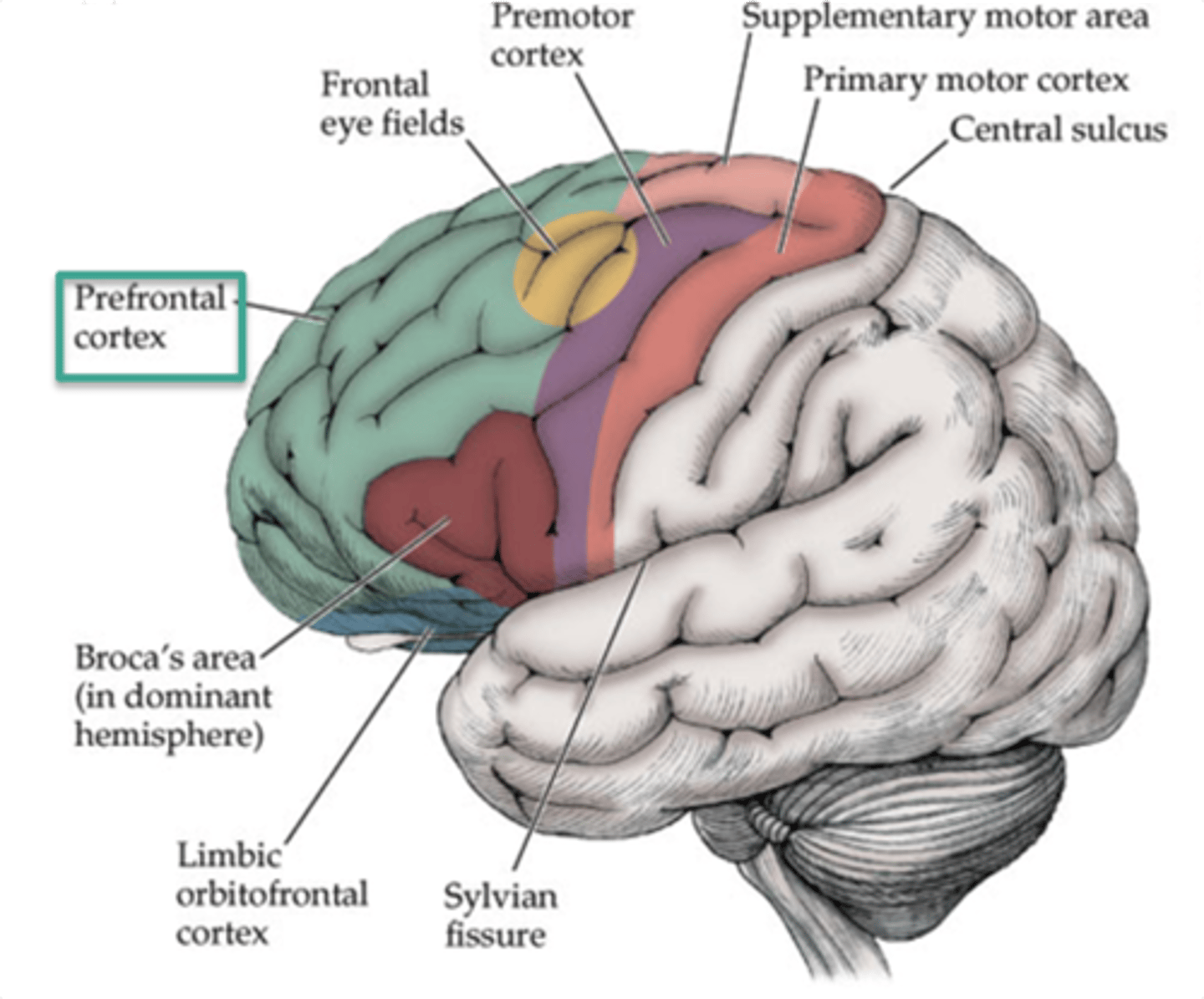
which region of the frontal lobe provides motivation to make a movement?
prefrontal cortex
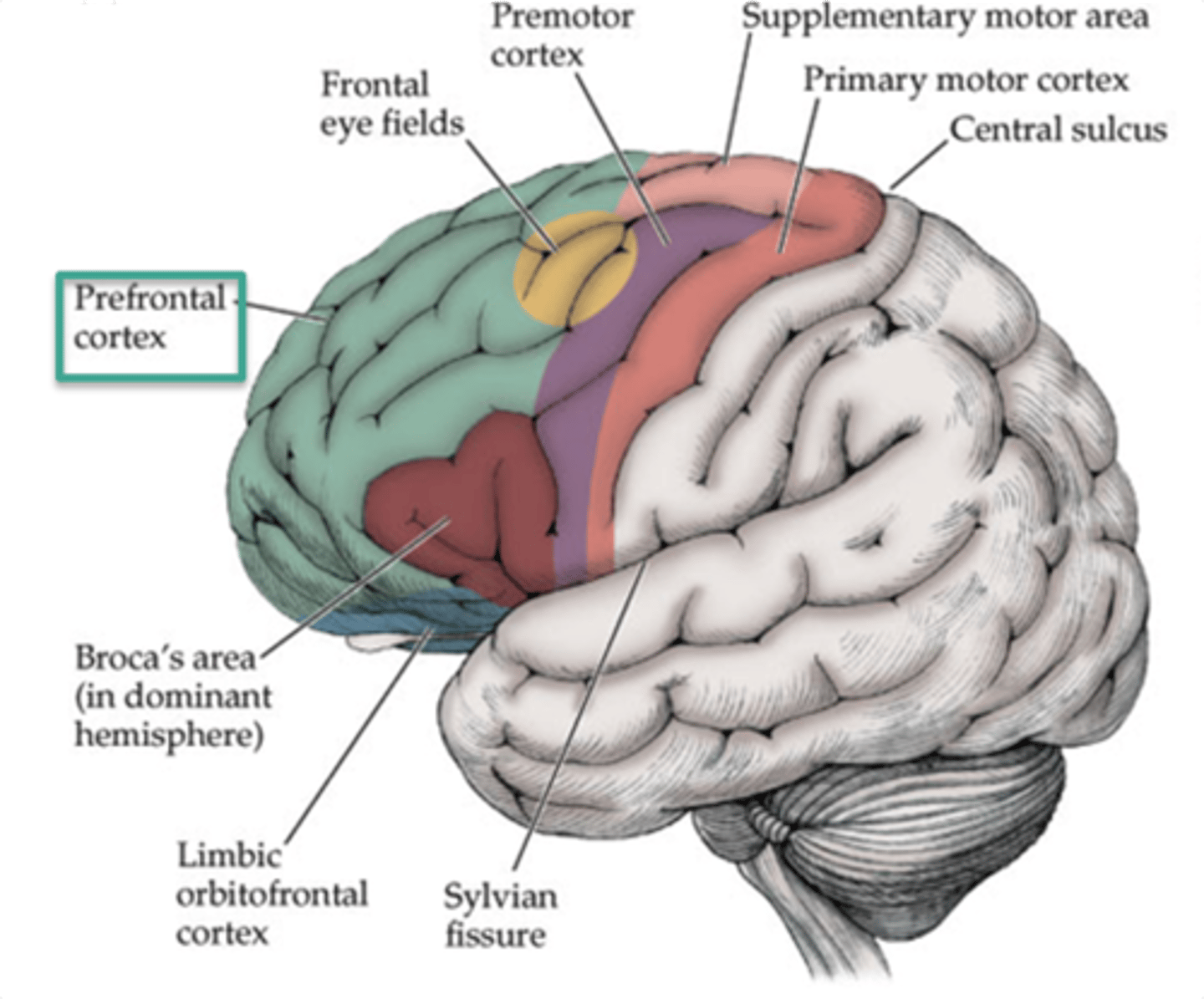
which region of the frontal lobe uses information to make decisions, generate plans for movements, and anticipate consequences of impeding motor actions?
prefrontal cortex

which region of the frontal lobe sends information to the motor association cortex then to the primary motor cortex to activate UMNs to execute movement?
prefrontal cortex
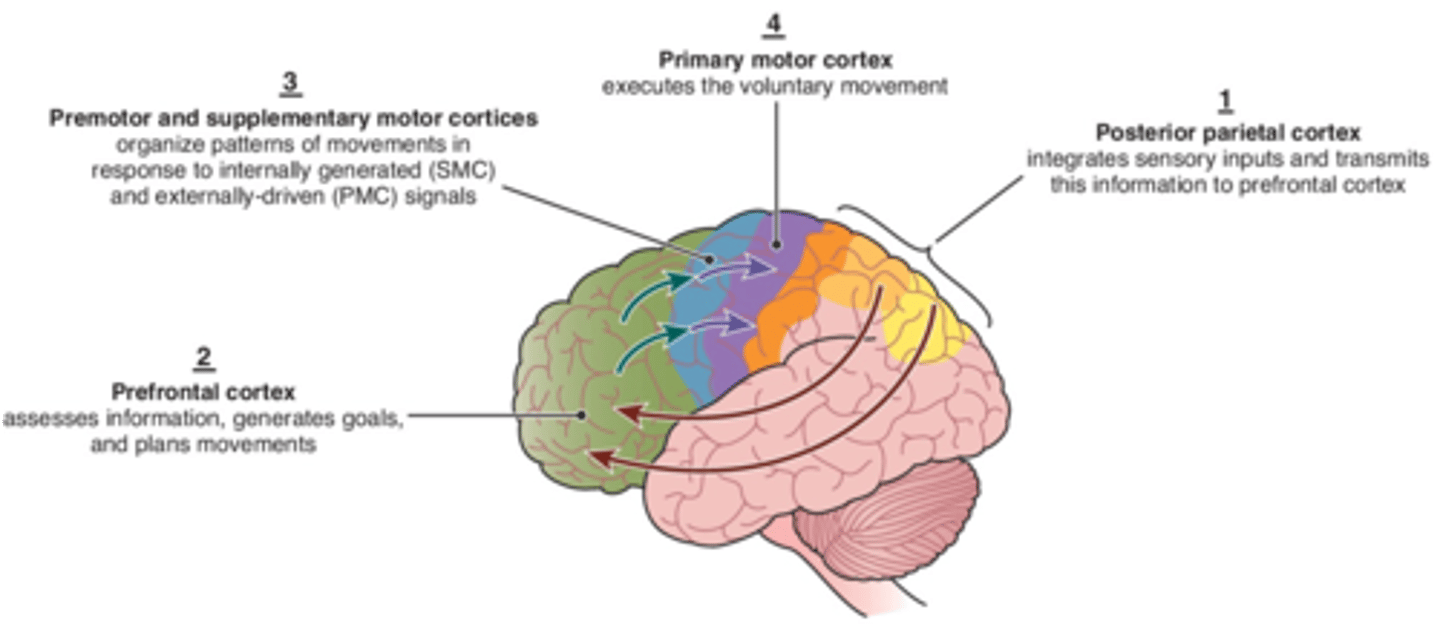
which region of the frontal lobe is key for behavior and personality?
prefrontal cortex; after a prefrontal lobotomy or injury to the prefrontal cortex, patients exhibit differences in their personality and expressions
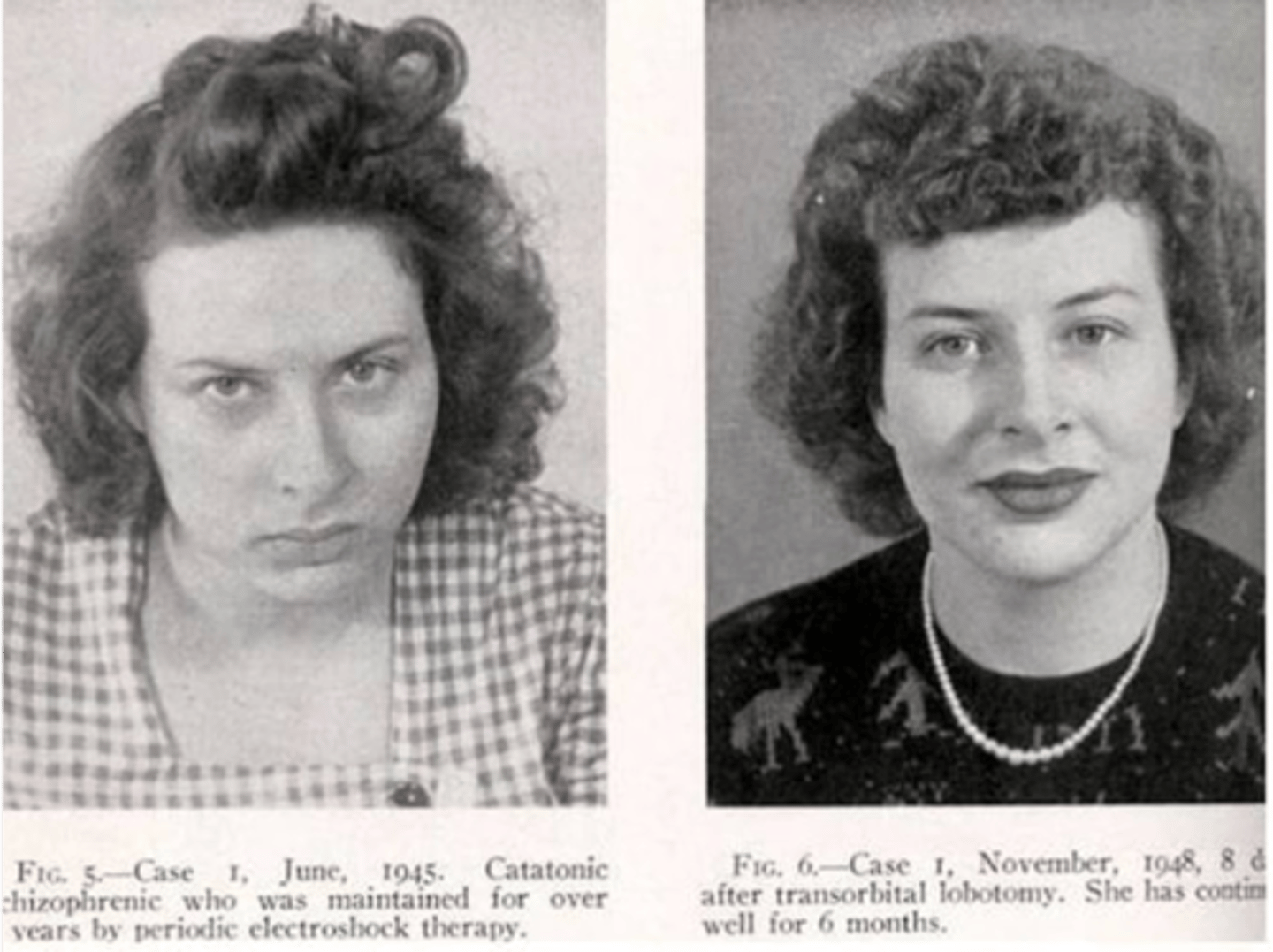
which region of the frontal lobe is usually in the left hemisphere and is essential for the production of speech?
broca's area (BA 44 and 45); injury to Broca's area causes (Broca)ken speech
